Author Archives: Josh
Arizona 2015: Connecting with Old Maricopa Friends and Making New
Coming home from vacation is always a mixed-bag. There is the unbeatable comforts of sleeping in one’s own bed and seeing the family dog again, which is only off-set by the reality of reality–unpacked bags, piles of mail, and employment. But, it’s still the weekend and the mail and bags can wait; it’s time to unpack the bird photos and stories from a very birdy spring-break trip to visit my snowbird parents in Arizona.
Unlike last year, I woke up that first morning in Arizona this year with zero birding anxiety. Partly this was due to the fact that last year we had pretty much conquered all the birds that could be had in the suburbia environment of Maricopa. It was also due to the knowledge that the next two days in SE AZ would provide plenty of birding excitement. So in this calm before the storm, there was nothing to do but relax, hang out, and do some casual birdwatching. There were also lizards.
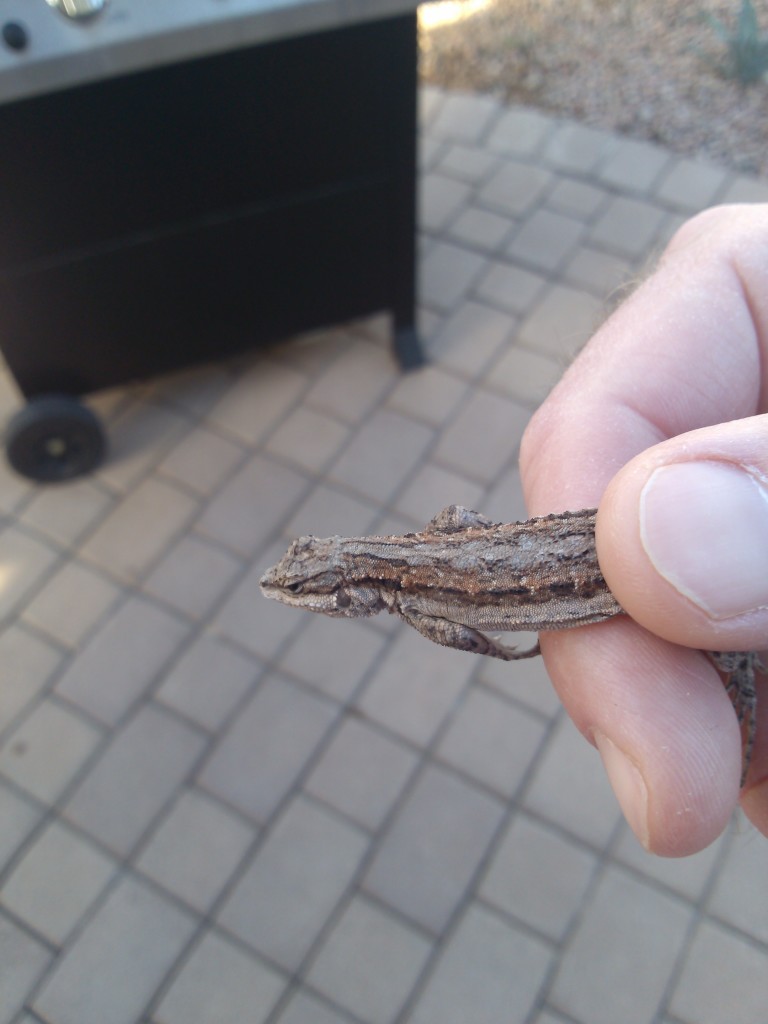
As fun as lizard-wrangling can be, one must never pass up an opportunity to visit Burrowing Owls especially when they are less than a mile from the house. It was great to see the same pair in the same burrow as last year.
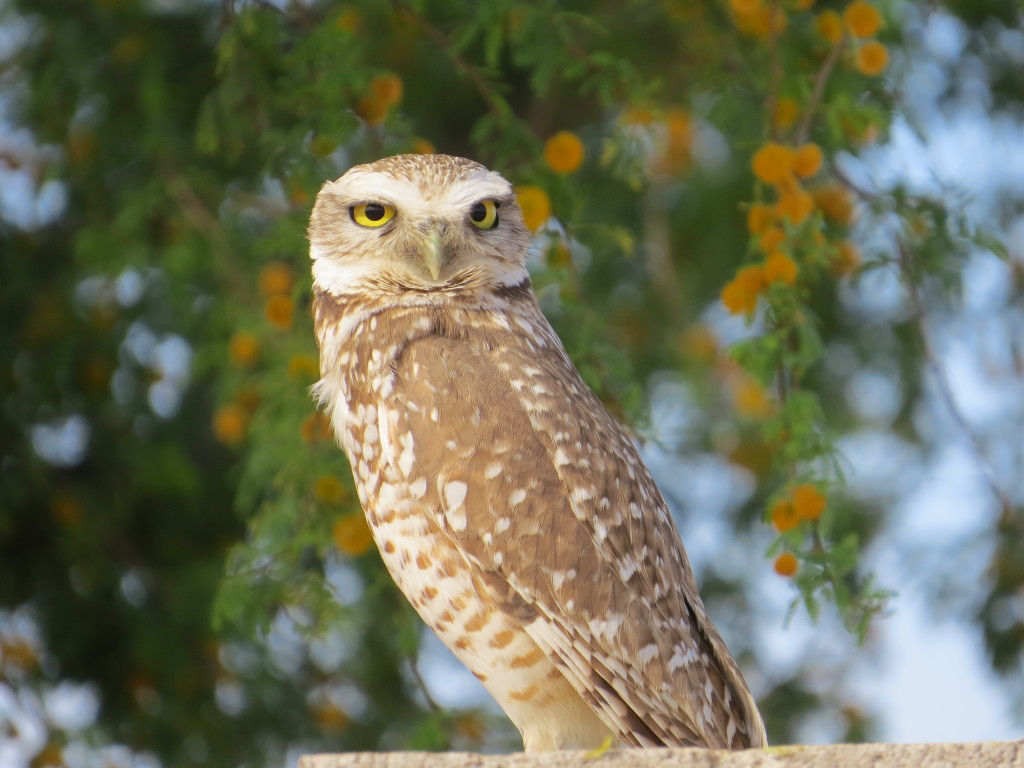 The reunion tour continued at a municipal park where I discovered a pair of Vermilion Flycatchers last year. Evan and I were pleasantly surprised to find not just one pair there this year, but two. Seeing the males do their pot-bellied flight displays is a real treat.
The reunion tour continued at a municipal park where I discovered a pair of Vermilion Flycatchers last year. Evan and I were pleasantly surprised to find not just one pair there this year, but two. Seeing the males do their pot-bellied flight displays is a real treat.
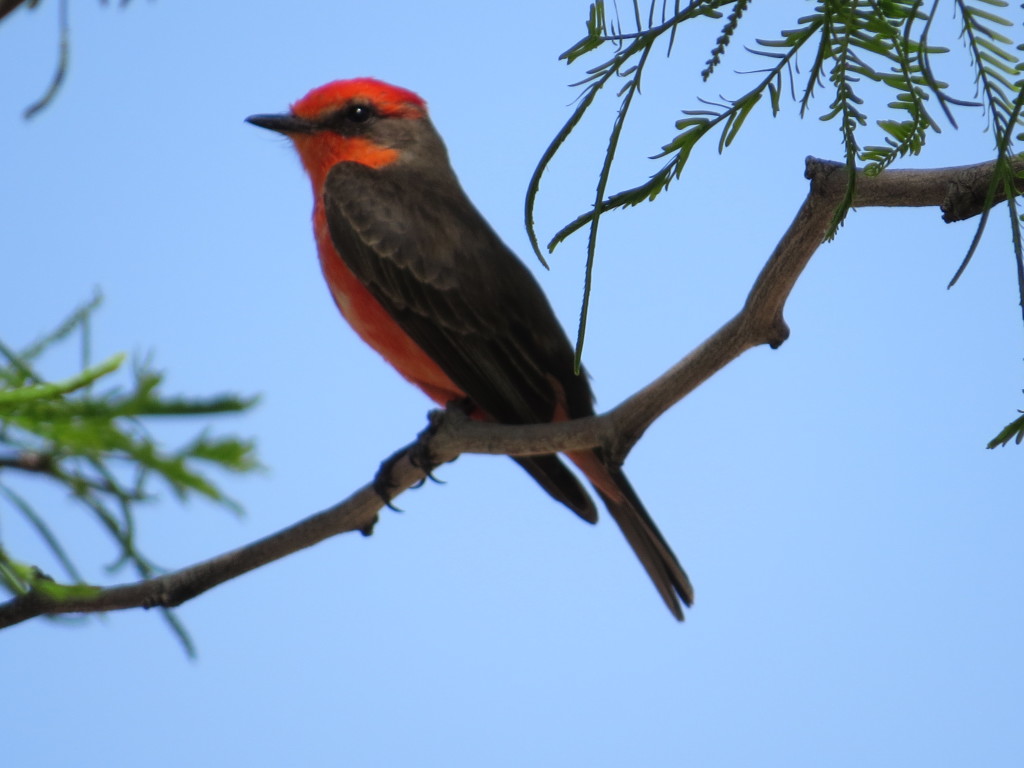 Good birds can be had in my parents’ yard and just beyond. My dad had been seeing a Greater Roadrunner around the house recently. Evan and I were going to set out to see if we could find it. As I was literally walking out to get Evan in the back yard, I caught a fast glimpse of the Roadrunner himself on the fence! While I was able to finally put this lifer to rest, Evan still didn’t see it–something that would become a common theme for the trip…
Good birds can be had in my parents’ yard and just beyond. My dad had been seeing a Greater Roadrunner around the house recently. Evan and I were going to set out to see if we could find it. As I was literally walking out to get Evan in the back yard, I caught a fast glimpse of the Roadrunner himself on the fence! While I was able to finally put this lifer to rest, Evan still didn’t see it–something that would become a common theme for the trip…
The search for the Roadrunner provided many opportunities to enjoy birds we don’t normally get to see. Western Kingbirds–anywhere–never get old. We had several this year. How did we miss them last year?!
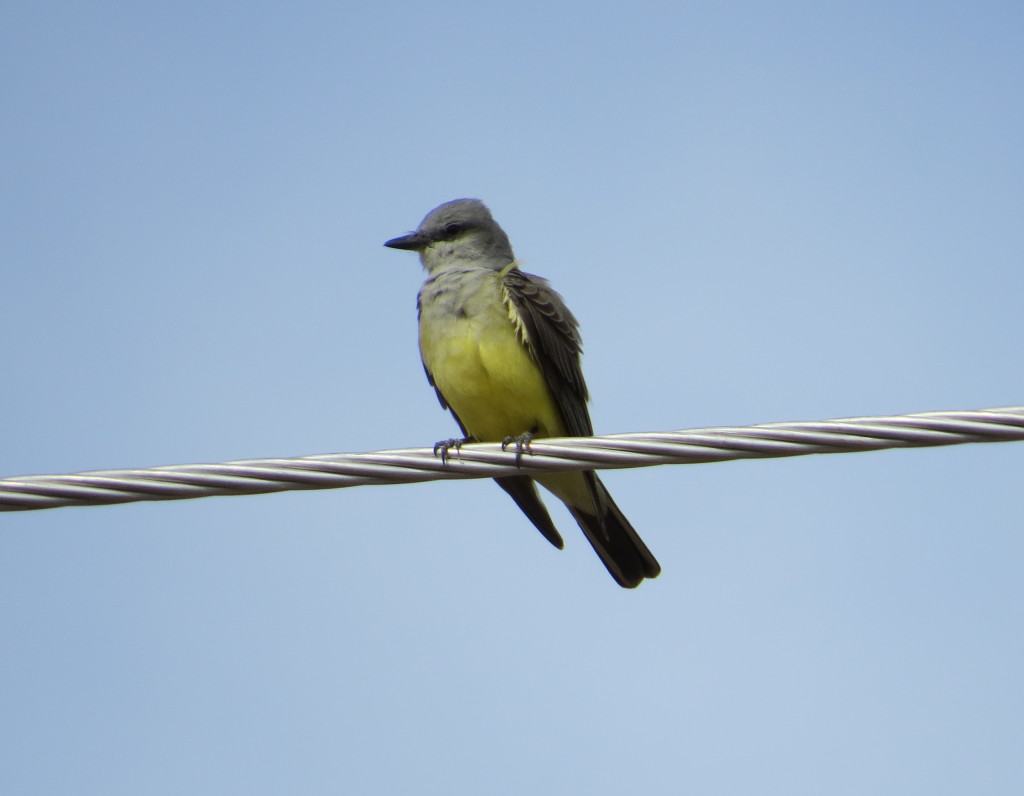
The Maricopa WEKIs are quite cooperative and unashamed, allowing a couple out-of-towners to do intimate checks for the similar-looking Cassin’s Kingbirds.
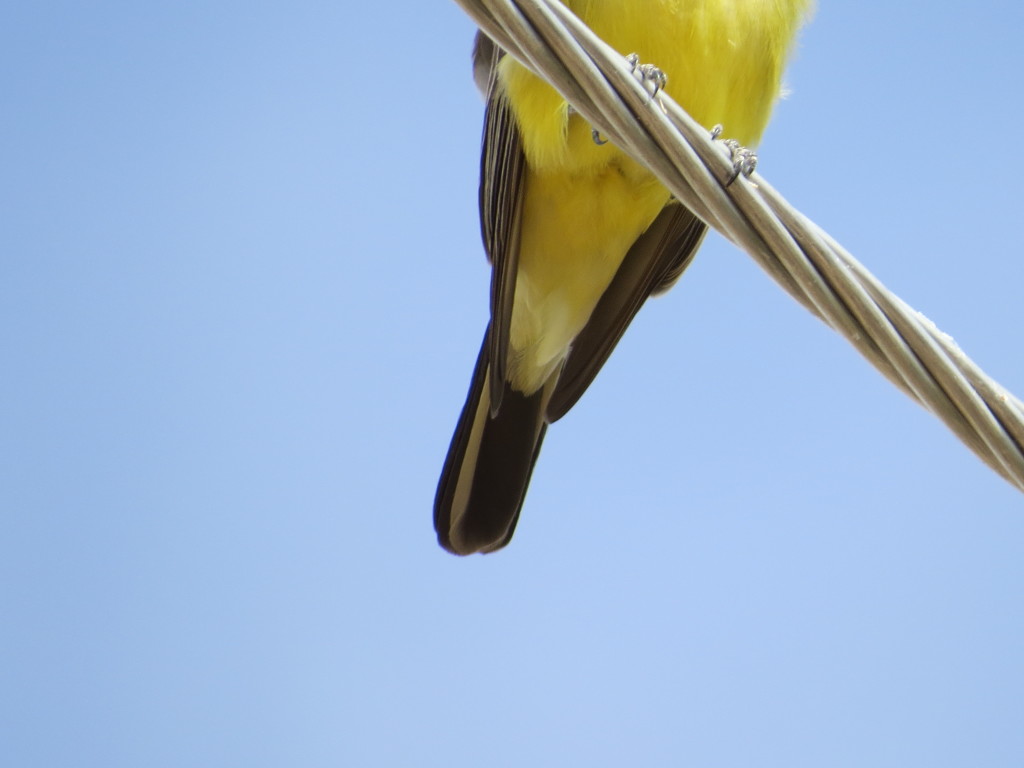
Say’s Phoebe is a bird I have not yet added to my Minnesota list. For now, these Maricopa birds will have to fill the Say’s Phoebe void.
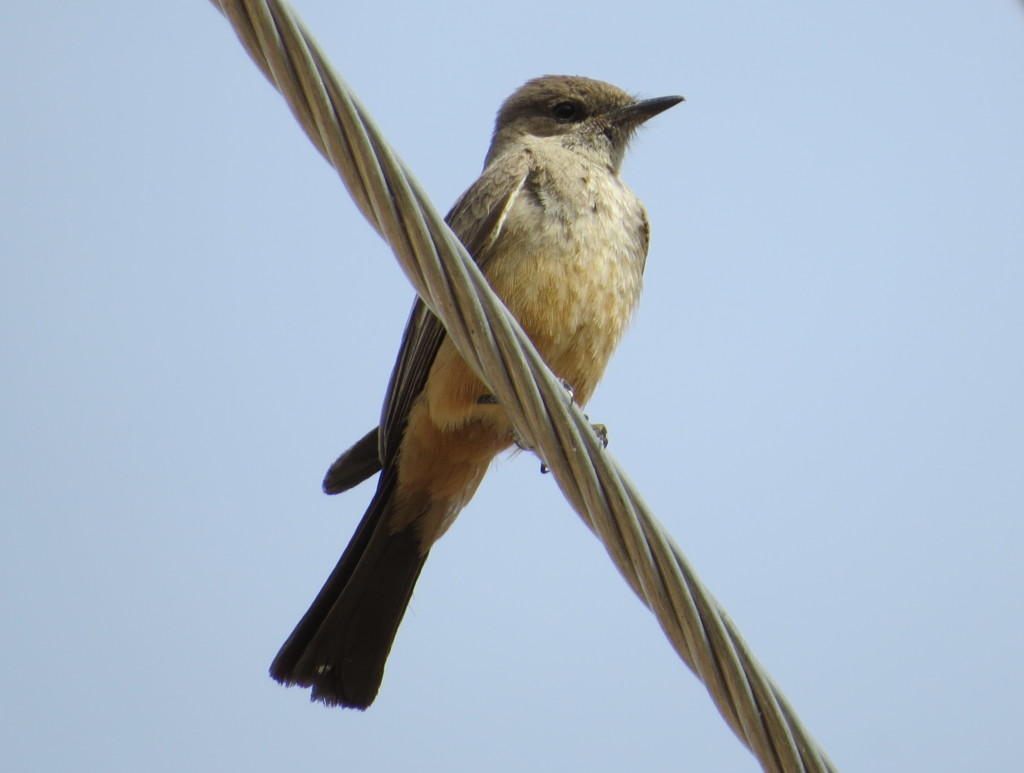
The same can be said of Northern Mockingbirds. The name of this species ironically mocks us northern birders since it is a much easier bird down south.
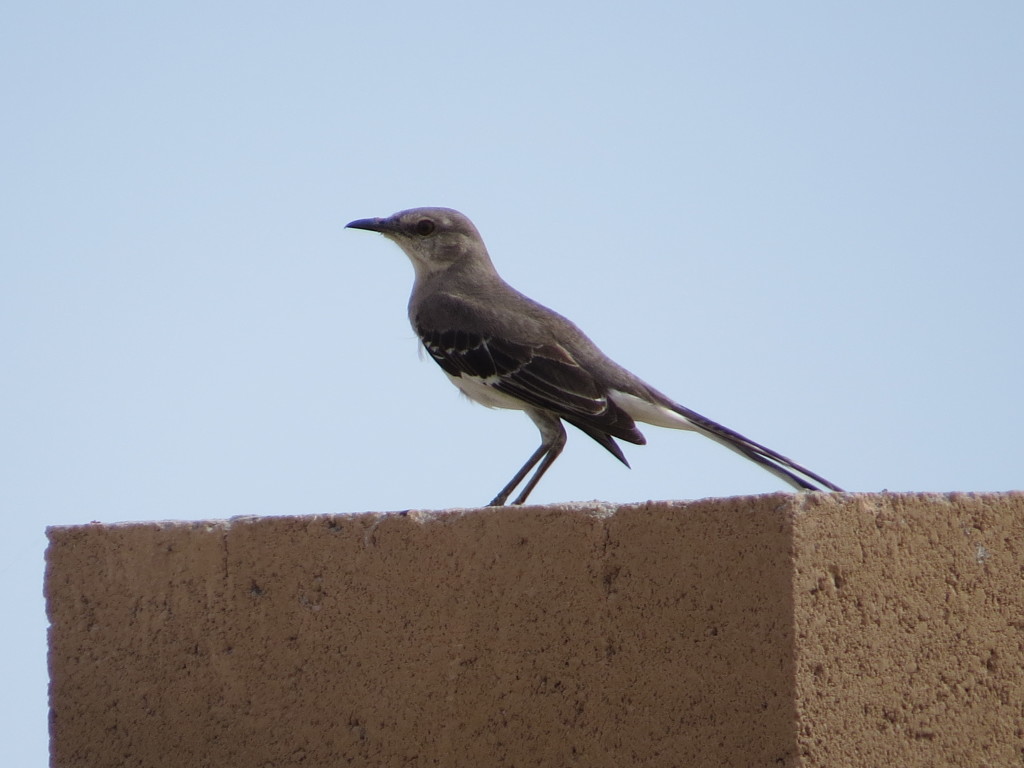
Continuing in this vein of ironic names is that while the Common Grackle is not so common in Arizona, the Great-tailed Grackle is common but not so great to Arizona birders. Needless to say, this is a fun bird for us vagrant birders both in the visual and audio sense.
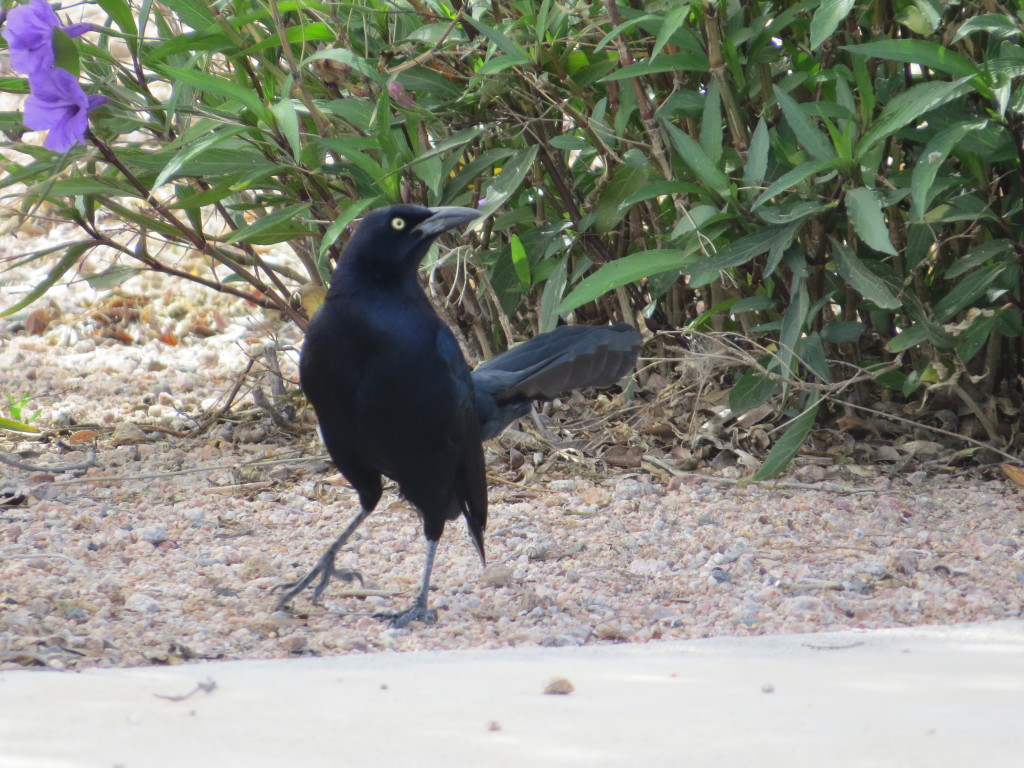 No trip to Arizona is complete without seeing the bodacious and skittish Gambel’s Quail.
No trip to Arizona is complete without seeing the bodacious and skittish Gambel’s Quail.
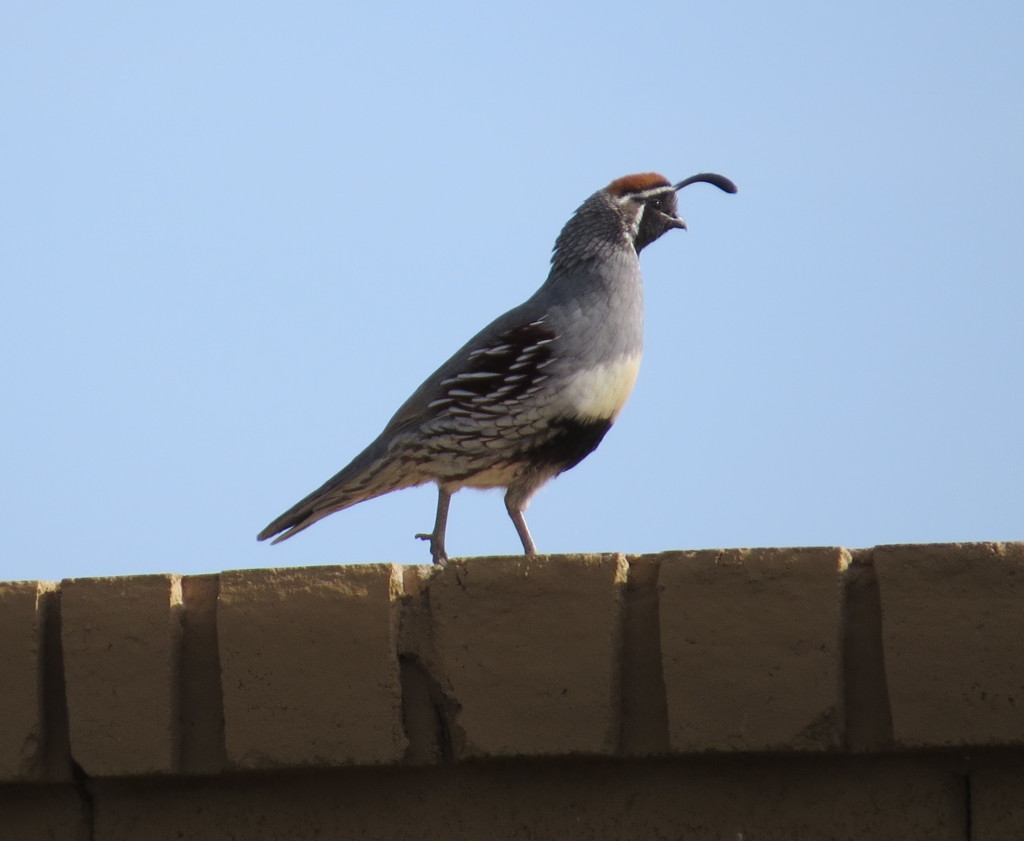
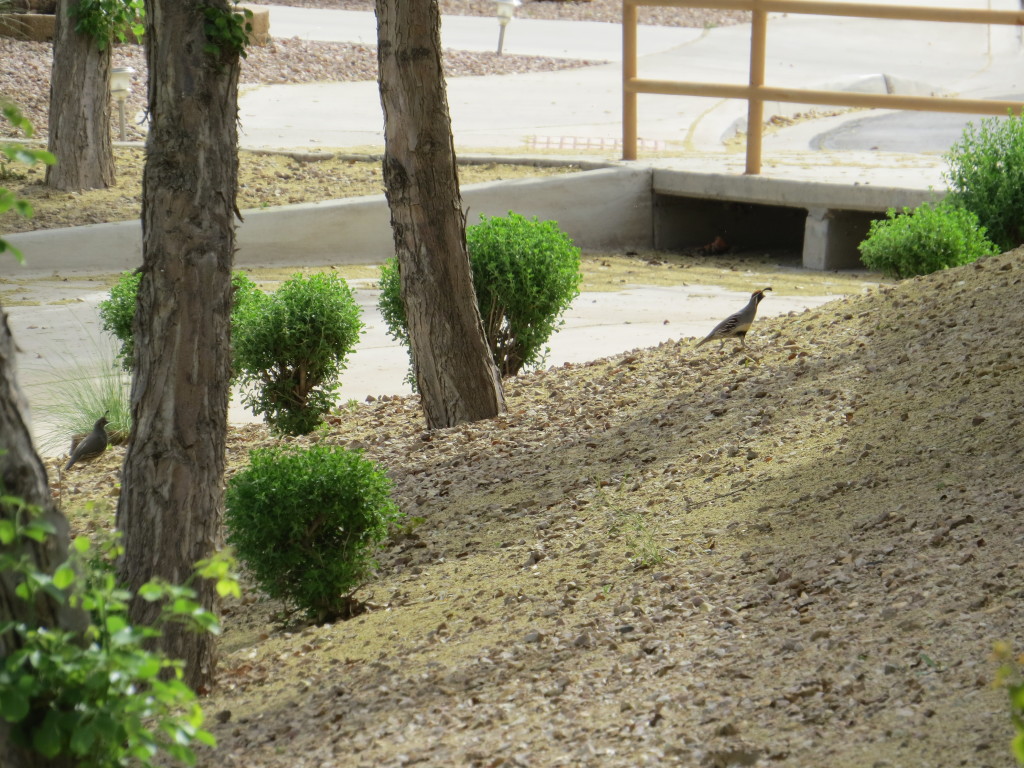
Not only was it fun to visit all these old friends again, but Evan also got to add a big lifer within Maricopa’s city limits. It was definitely a surprise to bump into a Western Grebe in one of the scuzzy man-made ponds of reclaimed water. Though I was hoping it was a Clark’s, it was nice that Evan could finally tally this bird, one that he has had lingering soreness over me seeing and not him.
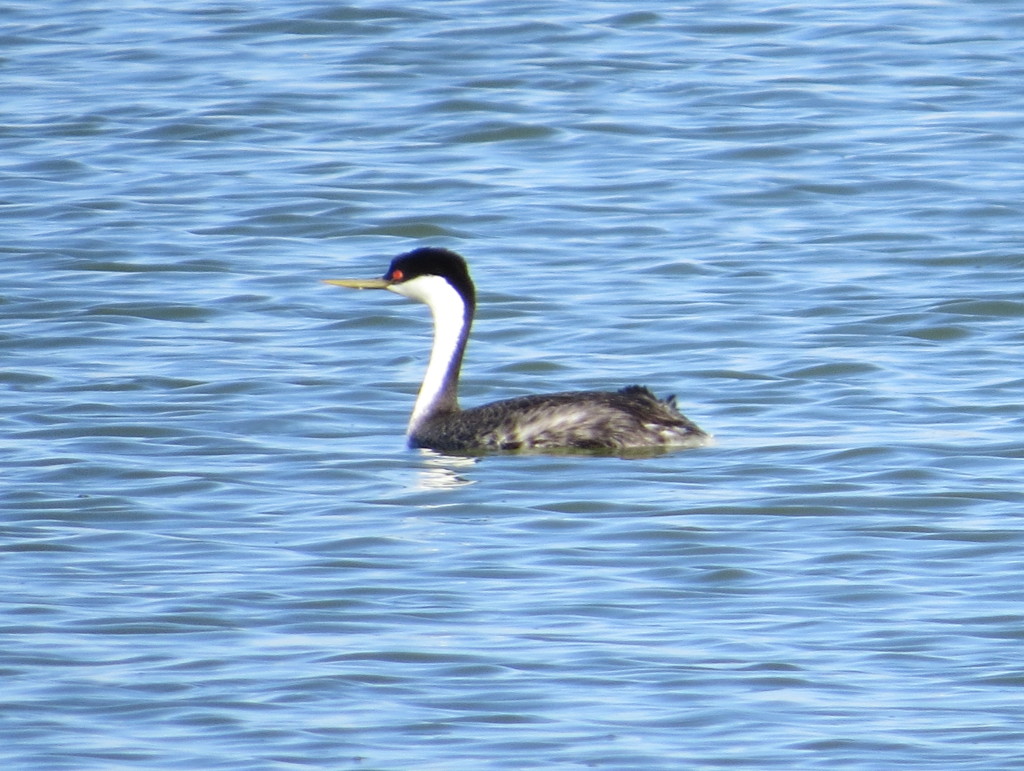
These nasty ponds have given us some good birds the past couple years, but it’s important to remember that no matter how hot it gets in AZ and how thirsty one gets…no beber.
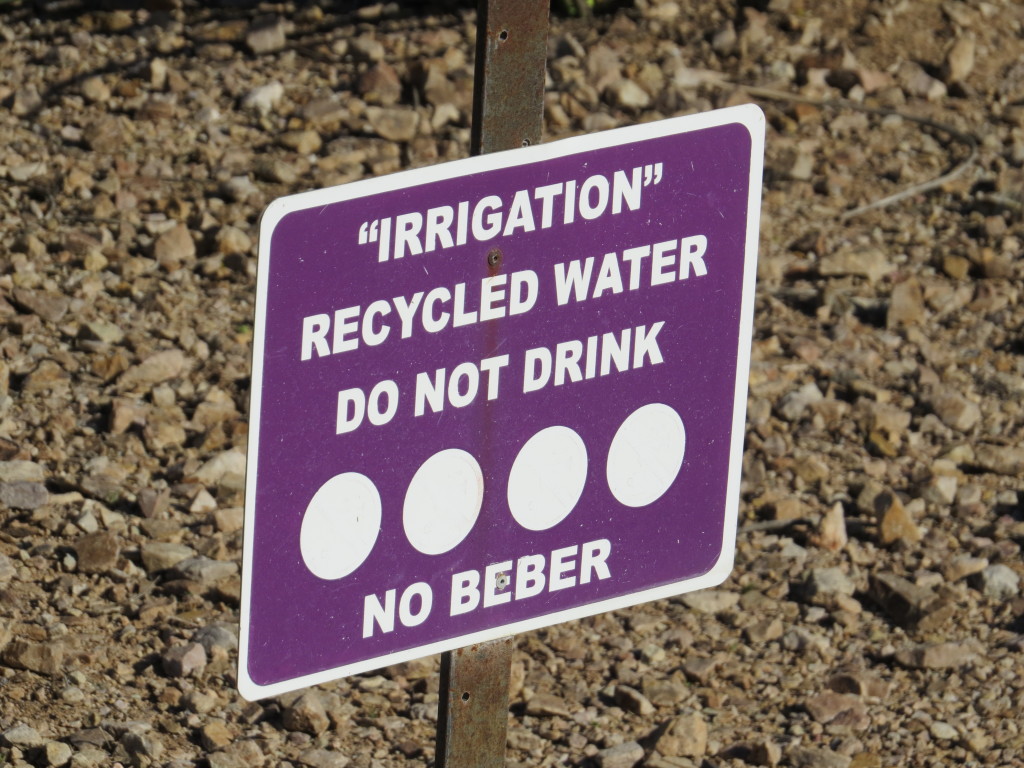
Consider this post an appetizer of great things to come from our Arizona trip. The main course(s), the filet mignon of birds, is yet to come. There will be a whole new cast of characters, birds and otherwise, for your viewing and reading pleasure.
The 2015 Arizona series has eight chapters: 1) Maricopa Birds, 2) Mt. Lemmon, 3) Florida Canyon, 4) Madera Canyon Part 1, 5) Madera Canyon Part 2, 6) Evan’s Big Discovery, 7) Owling at Coon Bluff on the Salt River, and 8) Evan’s Nemesis.
Sugar and Spice and a Whole Lot of Nice
 What are a couple of birders to do when they are kicked out of the house for a bonafide girls-only, princess birthday tea-party? Hmmmm…
What are a couple of birders to do when they are kicked out of the house for a bonafide girls-only, princess birthday tea-party? Hmmmm…
Even if we could stomach the inordinate amounts of pink, lace, and so forth, Marin was adamant that her brother and I NOT be anywhere in sight. All day long she wanted us to go birding and kept asking when we’d be leaving. We didn’t have a license to go birding–we were given orders.
I had decided on traveling about an hour south to look for Long-eared Owls near Morton. Just as we were about to be exiled from the princess fairy-world, a fantastic bird sighting by Bill Marengo came in on the listserv, a Cinnamon Teal in New Germany, a town an hour away to the southeast. This is a bird I needed for my state list, and after lingering regrets of not chasing the one last year in Stewart a MILE from my AUNT AND UNCLE’s HOUSE, it was an easy decision to switch from owl mode to cool, western duck mode. Also, Minnesota only gets maybe one or two Cinnamon Teal a year, so another chance this close to home was not one to pass up!
Halfway to New Germany a devastating report came in that the Cinnamon Teal had flown off and wasn’t relocated. However, we had nothing better to do and were halfway to the site already–we might as well look around in the area. After all, treasure hunting is always more fun when you know you there’s actually treasure in the area.
We started with ground zero at the large wetland southwest of New Germany and were pleasantly surprised to see a couple of cars lined up by the original location. Scopes were out. Things were looking good. Hopping out and visiting with the other birders quickly revealed that the duck was back!
Birders are so great at these random, road-side, birding flash-mobs that bewilder the rural passers-by; we were instantly invited to view the Cinnamon through scopes trained on it. Renowned county-lister, Denny Martin, quickly set up his apparatus to accommodate the much shorter Evan.
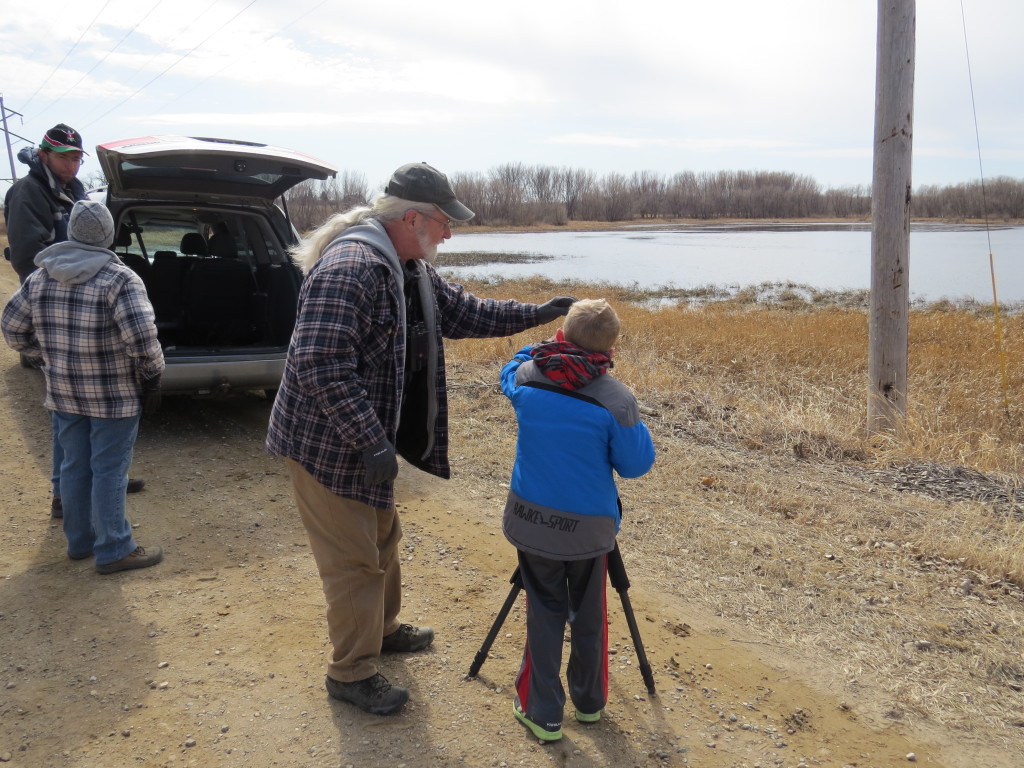
L-R: Bill Marengo (Discover of the Cinnamon Teal), Barb Martin, Denny Martin, Evan
Such a good bird the Cinnamon Teal is and so great it was to see one again. This duck was one of the very first life birds we nabbed within an hour of deboarding a plane in Arizona last year.
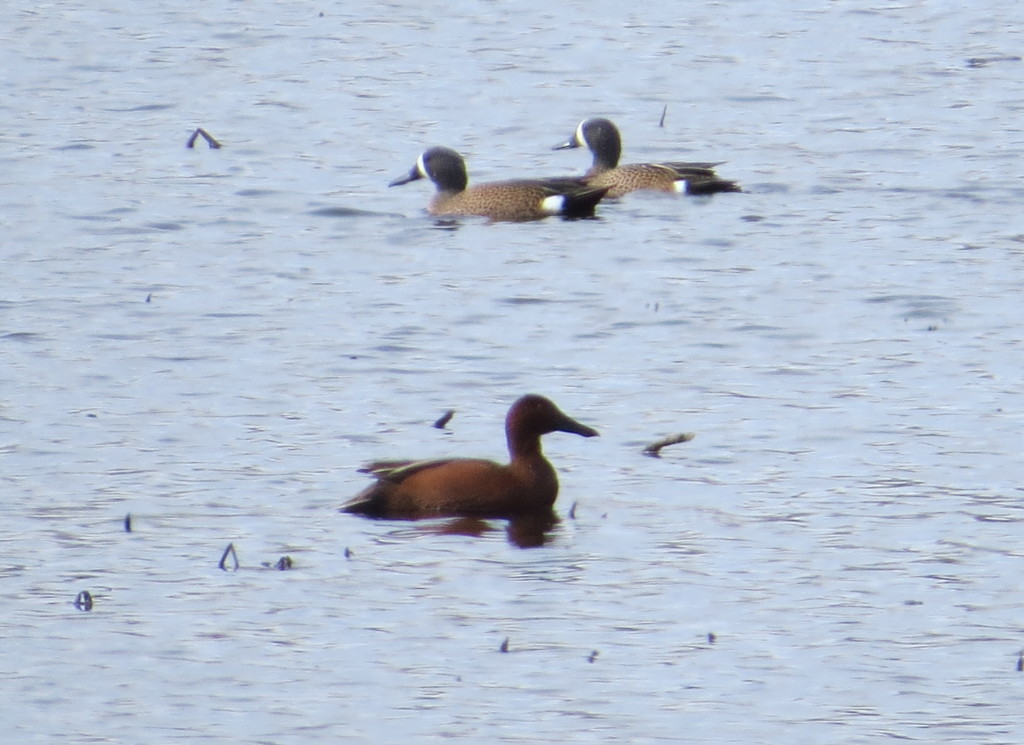
I couldn’t do much about the distance or light in this situation, but beggars can’t be choosers. At least you can see what all the hype was about.
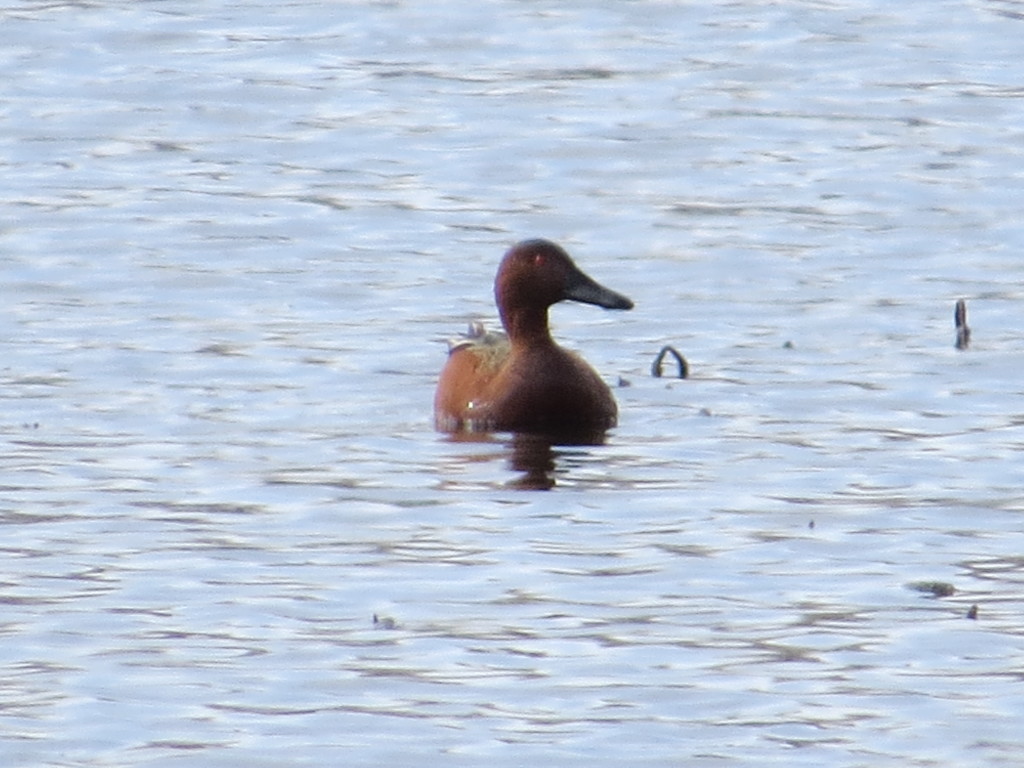
As we watched and chatted with the Martins (the people not the birds), some Eagles (the birds not the people) flew over. I normally don’t even look- the height of the birds combined with my lack of long-range optics and poor ID skills means I am highly unlikely to ever pick out a Golden Eagle. Denny Martin quickly trained his scope-still set at Evan’s level-on one bird. With the tenacity of a county-lister and lots of years of experience, he stayed on that Eagle for a long time until he got the clincher field marks he was looking for – a small head and golden nape as it turned into the sun. Golden Eagle! It was a county bird for the Martins, a second state bird in as many minutes for me, and a life bird for Evan.
After the Golden Eagle we all went back to visiting and enjoying the Cinnamon Teal as more birders kept responding to the call. Cars kept stacking up behind us the longer we stayed. They’d get their tick and leave. New cars would replace them. Really new cars. Really awesome cars. Really puts my mini-van-to-shame cars.
 This sighting at a birding-rave may be the rarest thing I’ve seen yet. Just how special is a Cinnamon Teal in Minnesota? It’s drive-your-Porsche-on-gravel special.
This sighting at a birding-rave may be the rarest thing I’ve seen yet. Just how special is a Cinnamon Teal in Minnesota? It’s drive-your-Porsche-on-gravel special.
Yard Bird #74 – Far, Far From a Cardinal in the Snow
The birds are conspiring against me. After the trip Up North, I was all set to be a responsible, non-birding adult who takes care of all those non-birding chores, duties, etc, and who generally uses his time wisely before jet-setting for Arizona in a couple weeks for…more bird gluttony. The birds have had other plans–they’ve been in my face.
For starters, FOYs are increasing exponentially. My year list doubled in the last couple weeks.
Some we are catching on arrival.
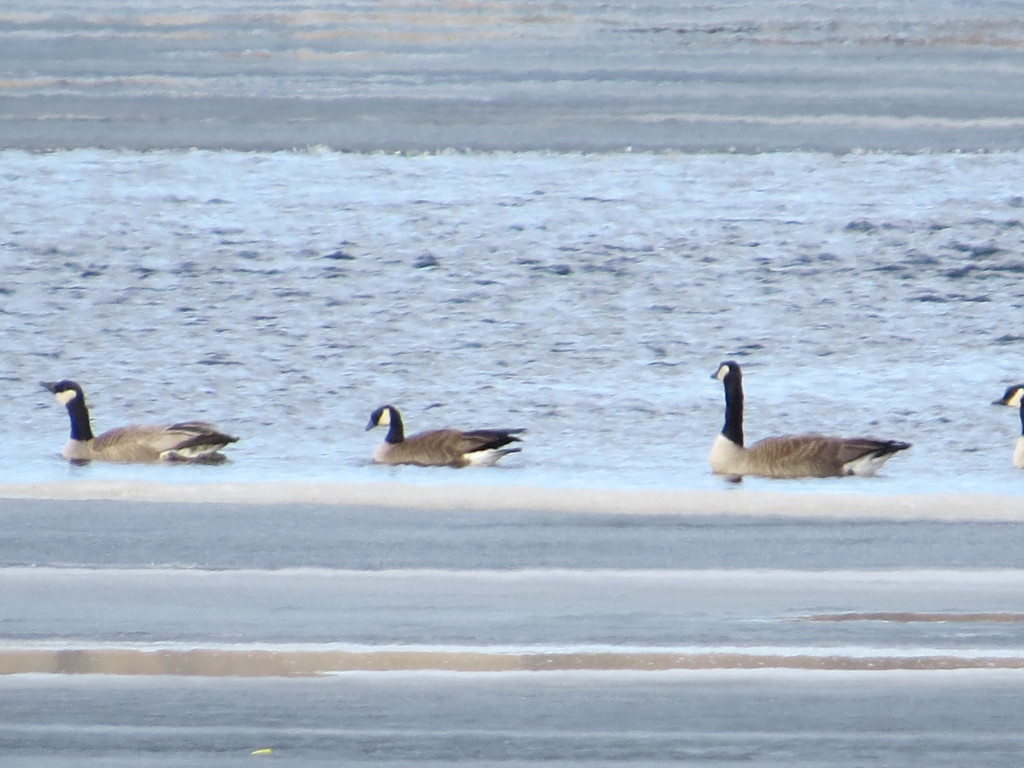
Cackling Goose is a solid FOY, not to be taken-for-granted.
Some we are catching on departure.
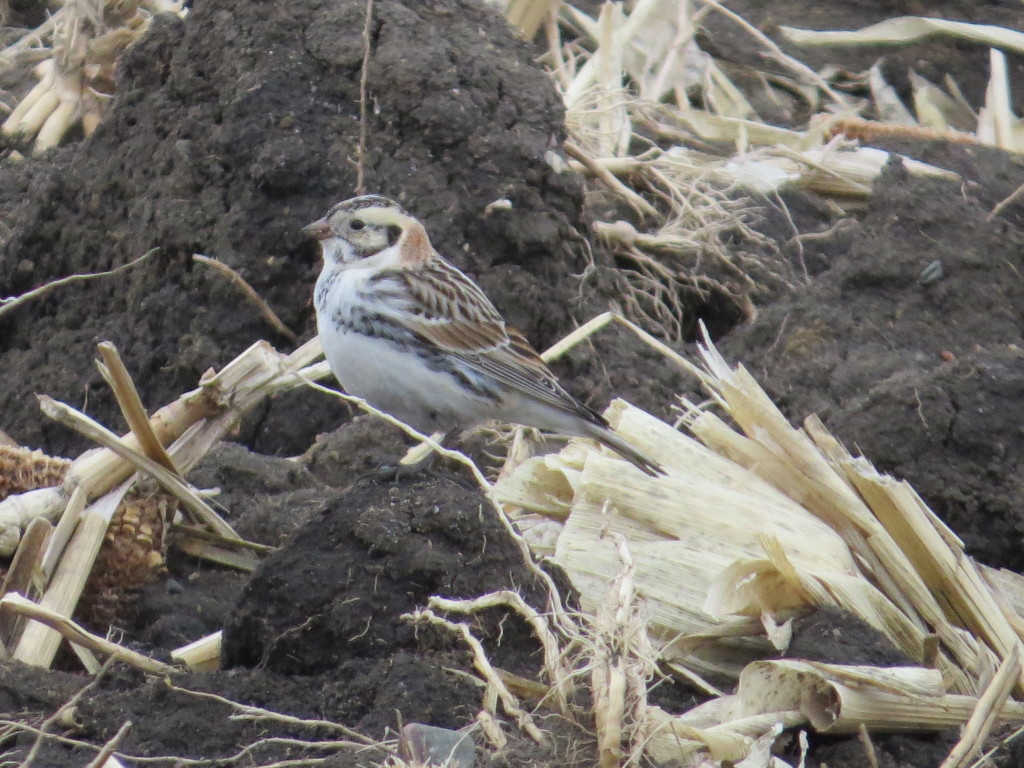
2015 was dangerously close to being Lapland Longspurless. Tragedy averted.
Then there is the time-consuming documentation of good birds, FOY or otherwise, that comes along with responsible birding.
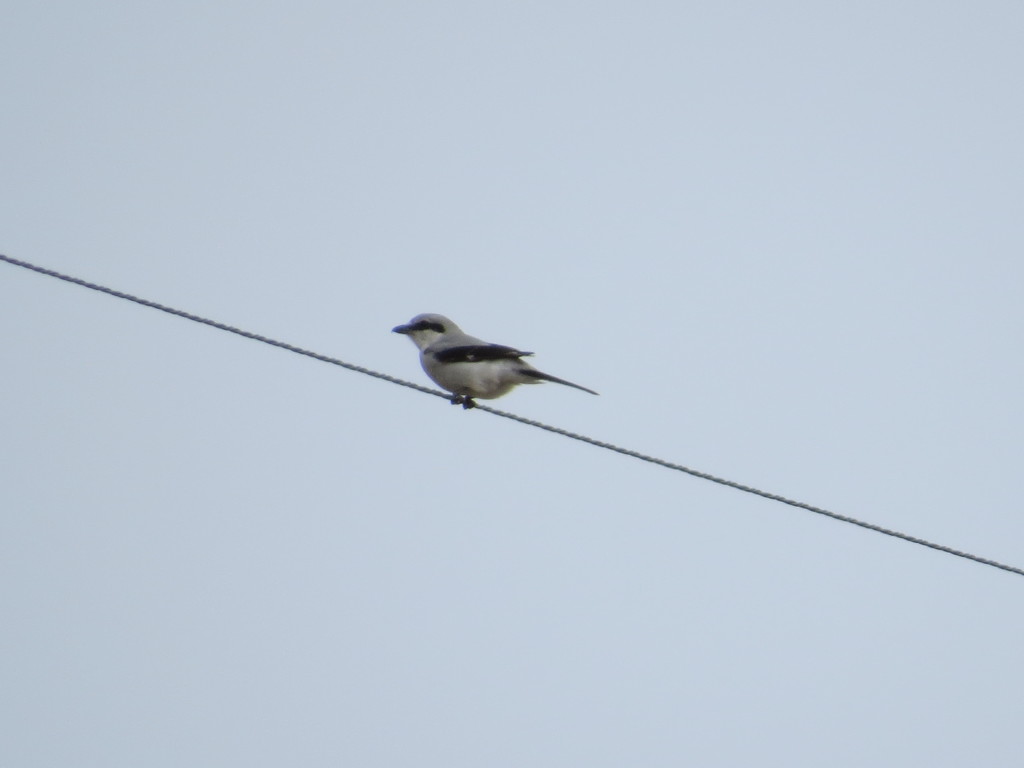
March 16th! The time is approaching when a MN Shrike cannot be safely identified by the calendar alone. Despite his proclivities for our recent warmer temps, this guy’s barred breast gave him away as a Northern.
Of course, when an MOU-official county first-record shows up in the home county, you simply must go after it.
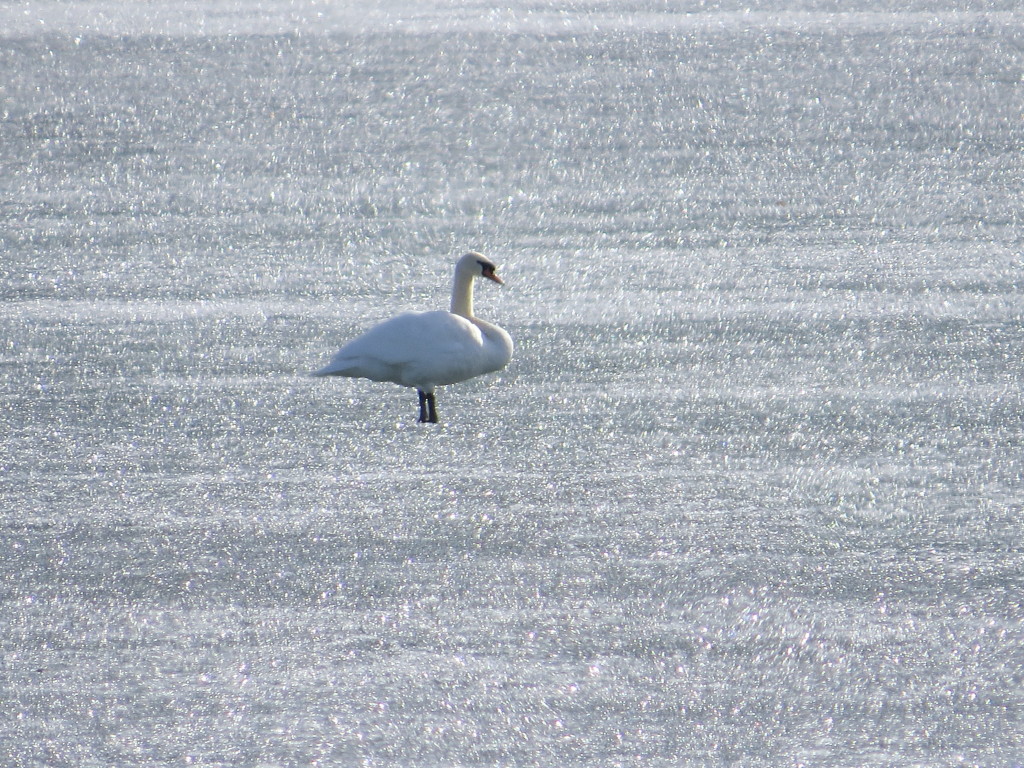
The race to see a rare bird is all the more urgent when an invasive, destructive species like the Mute Swan will be shot on sight by the DNR or USFWS.
Even if it chooses an uninspiring place to land.

Big Kandiyohi Lake from County Park #2
Even if it is an unambitious slug that hangs out ALL day in one spot and might be a sick bird.
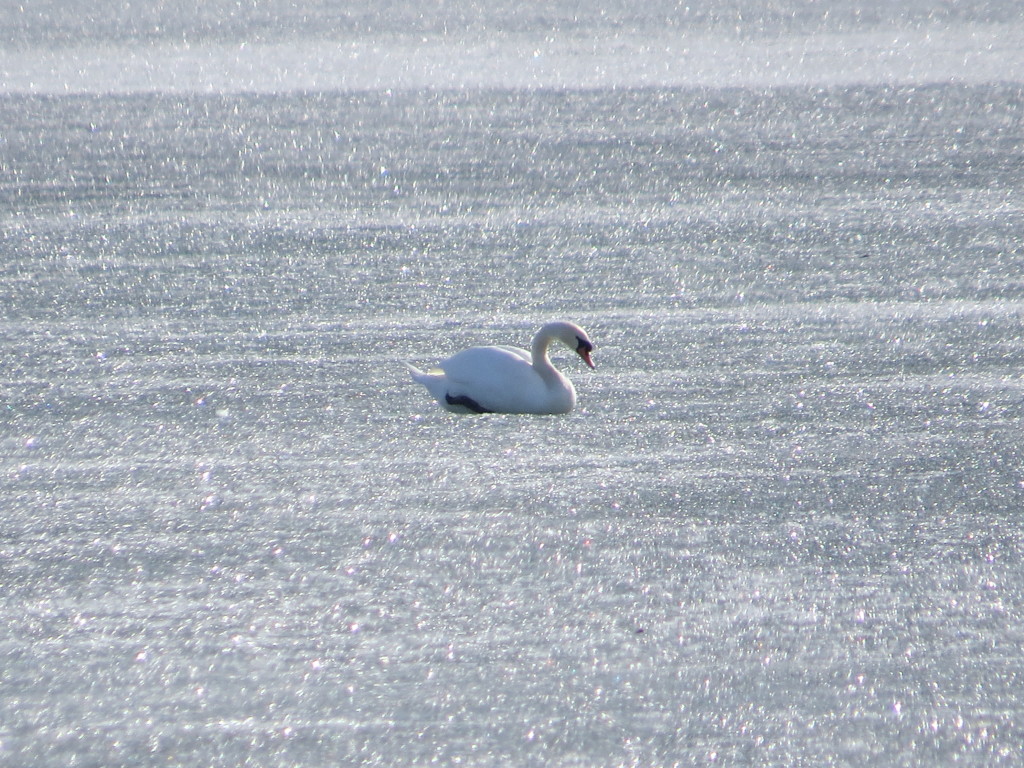
An escapee? Doubtful-no leg bands seen when standing or clipped wings seen when flapping.
Then there are birds you simply have to take time to look at, unless of course, no one read you E.B. White’s classic, The Trumpet of the Swan, when you were a kid.
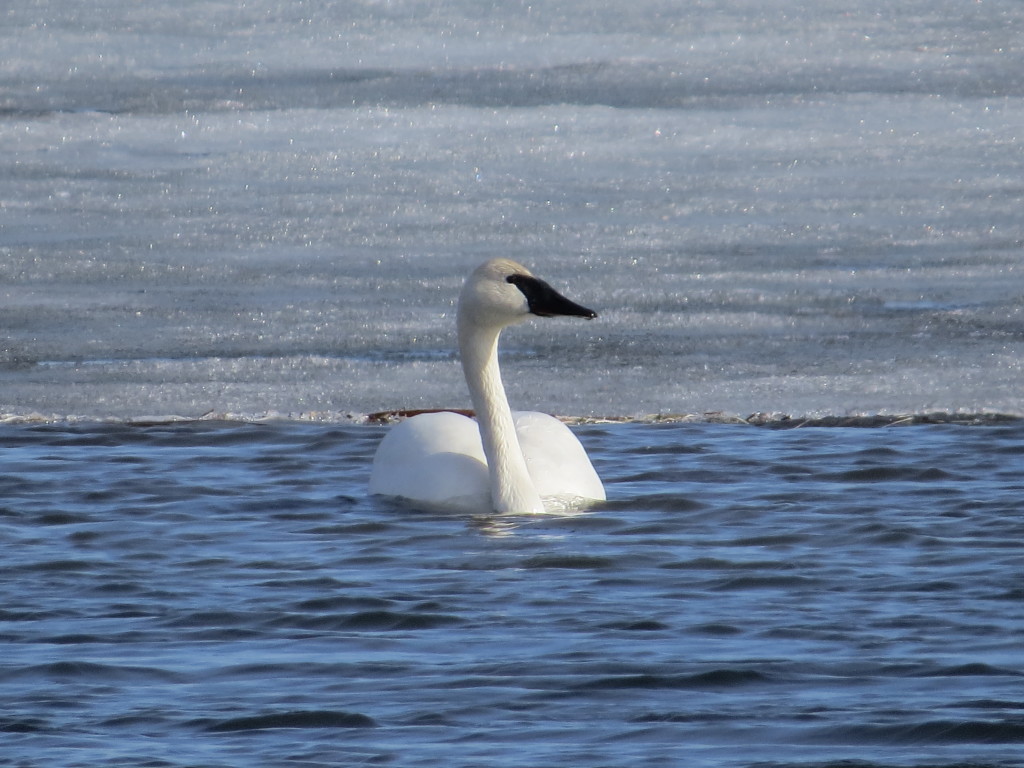
This Trumpeter Swan descendant of Louis is purported to play the trumpet line in the opening credits of Homeland.
Finally, there are birds that you cannot ignore even if you never venture out–yard birds. Last week I stayed home one day to take care of a sick Evan. Upon pulling in the driveway after going out to pick up soda crackers, 7-Up, and so on, Evan told me he thought he saw a Bald Eagle overhead. Not a rare sighting at our house, as it happens 2-3 times annually, but it was definitely a noteworthy sighting that caused me to get out of the car and look up. It was no hum-drum Eagle. I nearly felt the breath knocked out of me when I saw it cruise directly over the house under 100 feet up–a new yard bird and rare one at that, a dark morph Rough-legged Hawk! Normally I always have the camera with me in the vehicle. Instead, I raced into the house and got back in time for one shot to document this color-morph of an uncommon bird that is exciting anywhere, but all the more exciting because it graced our yard with its shadow.
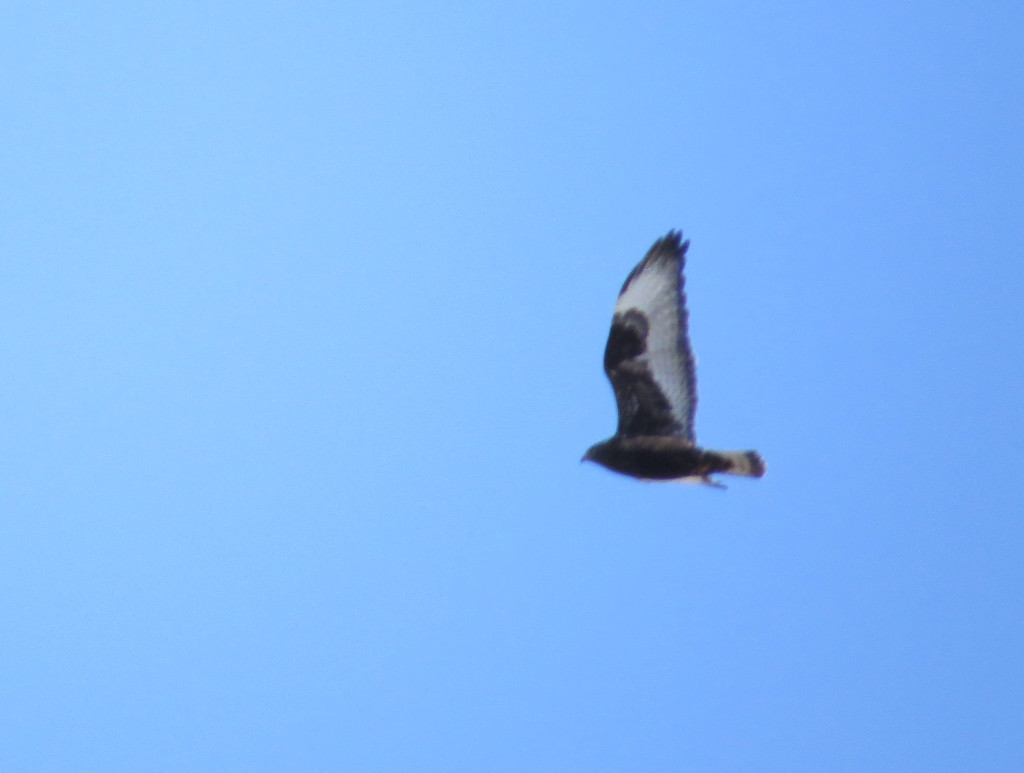
This was only my fourth county RLHA and my second-ever dark morph.
Evan and I chased after this bird for better photos, but it just kept slipping away as it glided on the wind. I kept raving about what a cool find it was for our yard to which Evan replied, “You’re welcome, Dad.”
GOOD Morning Sax-Zim Bog!
After a successful hunt for a Gyrfalcon lifer and a Boreal Chickadee photo on Sunday, I was primed for a day of different birding objectives when I woke up at the in-laws’ house in the Northwoods Monday morning. I was expecting magic–I was going to the Sax-Zim Bog. Part of that excitement was that, when given the choice between the Bog or hanging out with Grandma for the morning, Evan chose the Bog. Based on recent knowledge I had, I knew this could be a special day of lifering and just downright fun birdwatching for him. Doing something science-based eased the parental guilt of pulling him out of school on this day, especially since science (and other subjects) get pushed to the margins in this era of standardized testing where math and reading reign supreme. Forget the guilt, I felt like I was doing something good.
Getting him up that morning was tough, but the promise of McDonald’s breakfast and the morning’s main objective-seeing Sharp-tailed Grouse do their courtship dance on a lek-was enough to get him going. We left the house under an amazing starry sky (truly, there is no better place to see the night sky) to try to get to the lek around first light. However, the breakfast errand and my negligence in not planning extra time to get all the way to Meadowlands in the southwest corner of the Bog caused a delay in my plans. Needless to say, I was haulin’ down Co. Rd. 7.
Still, I brake for Great Gray Owls. Coffee is a great way to start the day, but these are even better way to get the day off on the right foot.
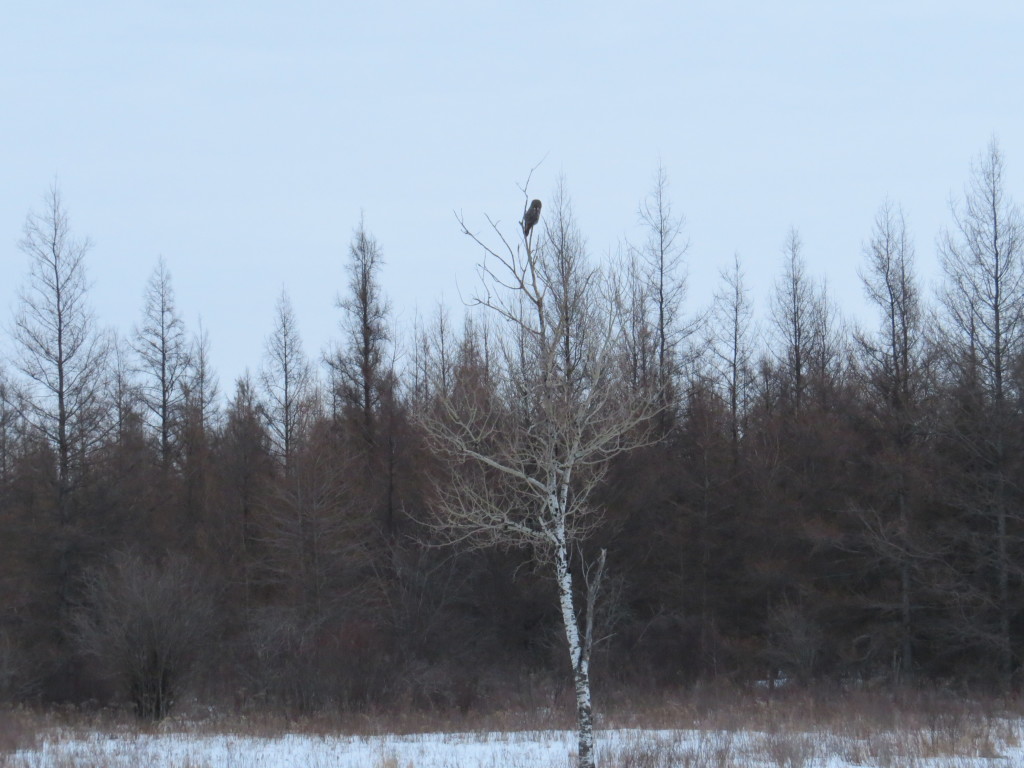
Note the distinct white “mustache” which is visible even in the diminished light of dawn and dusk.
I’d love to tell you how I spotted this thing, but you deserve the truth: I saw hazard lights in the dim morning light. That usually means one thing in the Bog. Immediately I looked in the vicinity of the stopped car and saw the giant silhouette. Brakes were slammed. A sleeping child was woken. Game on! I was NOT expecting to see a Great Gray this trip. They have been very sporadically seen since early January. Many out-of-state visitors dipped on this species this winter. Interestingly I had seen a report of a Great Gray on Co. Rd. 7 the previous evening, so I was keeping my eyes peeled. I’d like to think I would have spotted it on my own. But really, who cares? These things are just fun to see–well worth delaying our Sharp-tailed Grouse plans even more.
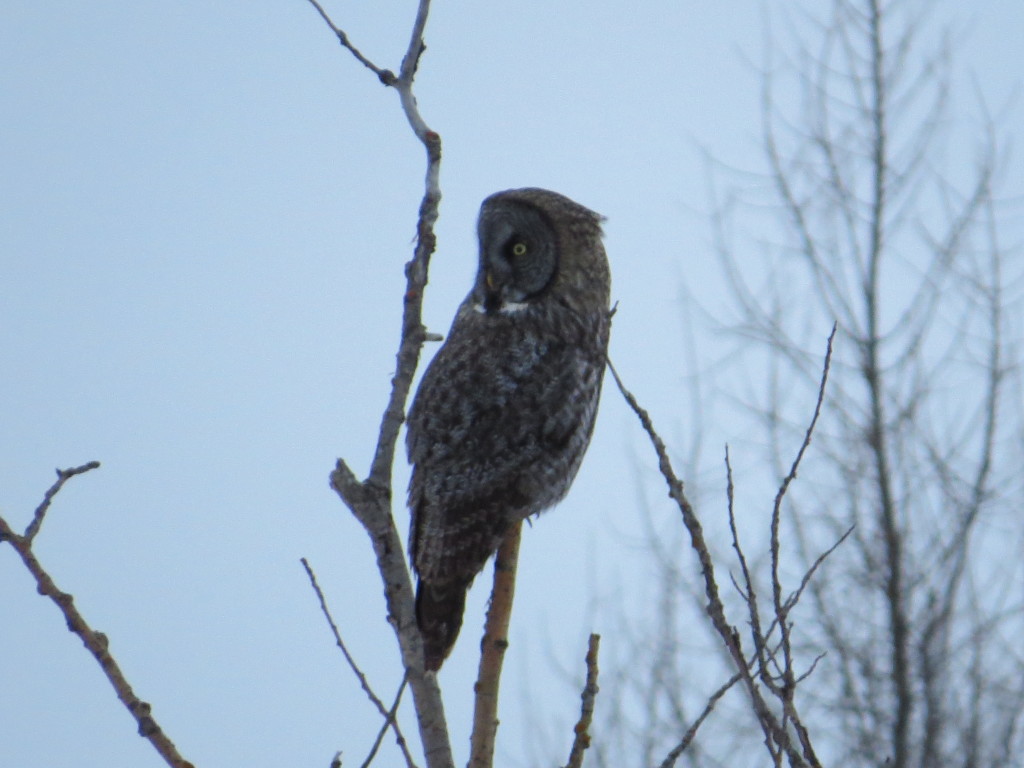
Call me crazy, but I prefer to watch Great Gray Owls on gray overcast days and in gloomy light. There’s just something fitting about it that adds to the mystique of this bird.
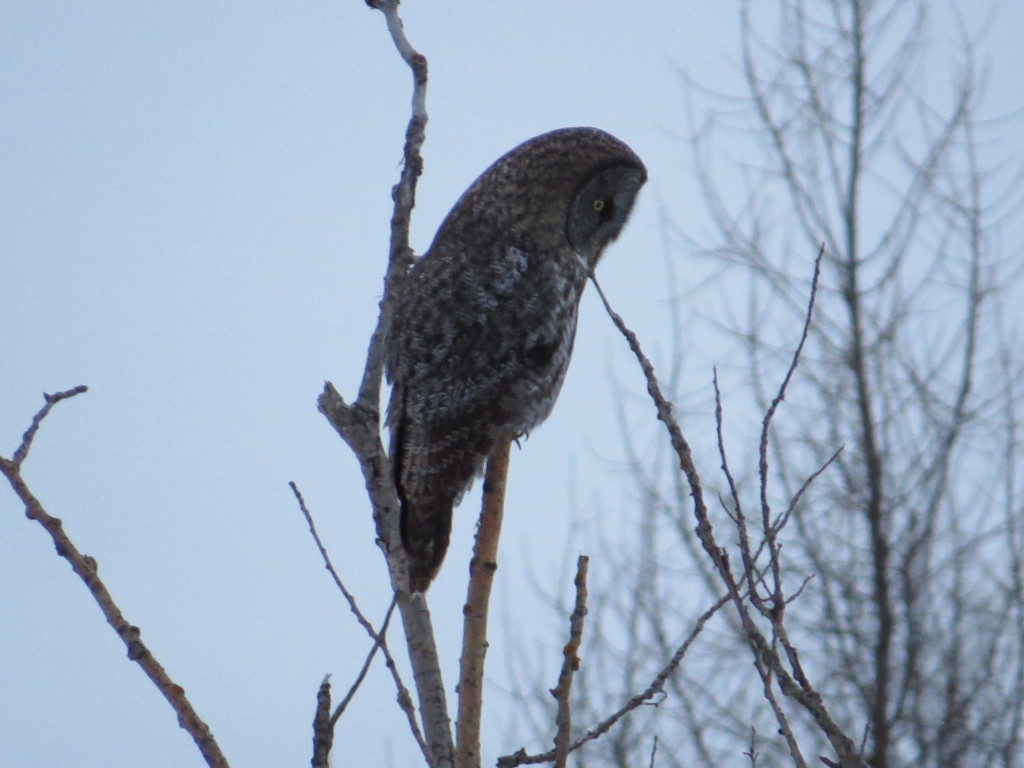
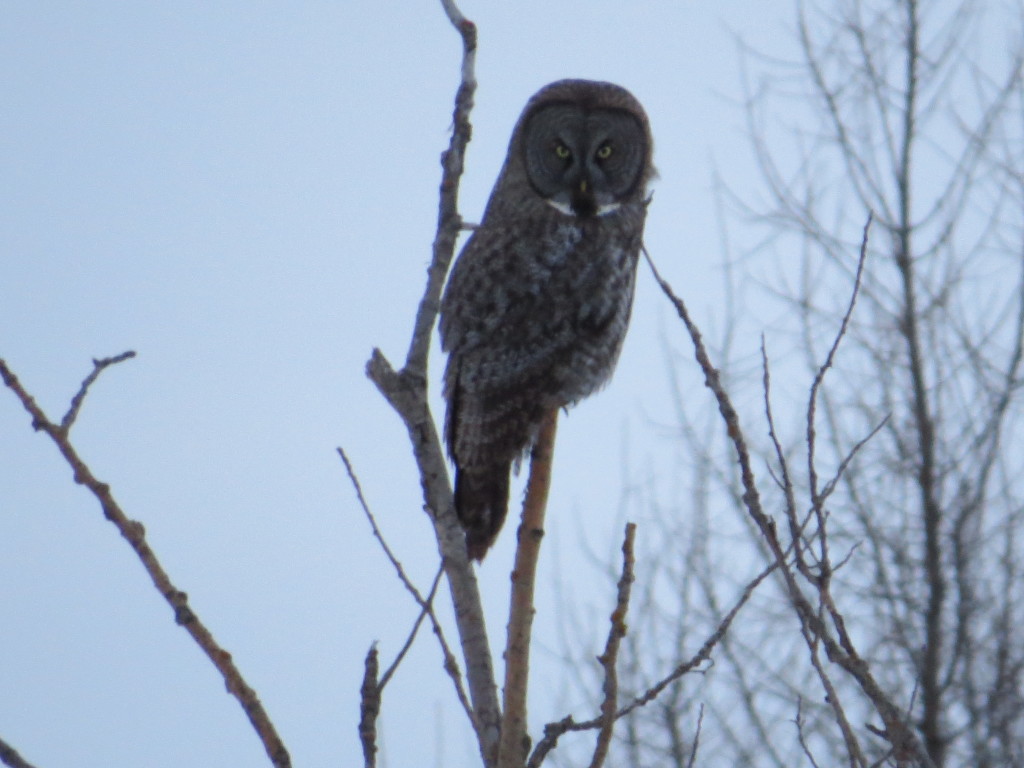
Despite this good fortune, I was confounded. How much time could I devote to watching this owl? I had to get to the lek if I wanted to see Sharp-tailed Grouse. Why does birding always have to be so stressful and full of decisions?! Mr. Owl, or I should say Mr. Crow helped me out. After 15 minutes or so of owl-watching, an American Crow flew in out of nowhere right at the Great Gray. It was awesome to watch the owl’s defense posture, spreading out his wing and ducking his head. But he didn’t want to be bothered any more, so he departed for the deep, gray recesses of the Tamarack bog behind him. Evan was using my camera at the time to get good looks at the owl, so I wasn’t able to capture this. I will offer up a short video for your viewing pleasure, though.
Next stop was the lek just north and east of the intersection of Co. Rd. 29 and Racek Rd. We got there around 8:15. Birding friend Clinton Nienhaus had told me that he had observed the grouse dancing around 7:30 last week, which was 8:30 this week thanks to Daylight Savings Time. So we were still on time. I found the small group of eight Sharp-tailed Grouse over a quarter mile east of the white house. They were little brown dots in a field of snow, very far from even the camera’s view. We were able to view them a little closer from Racek Rd.
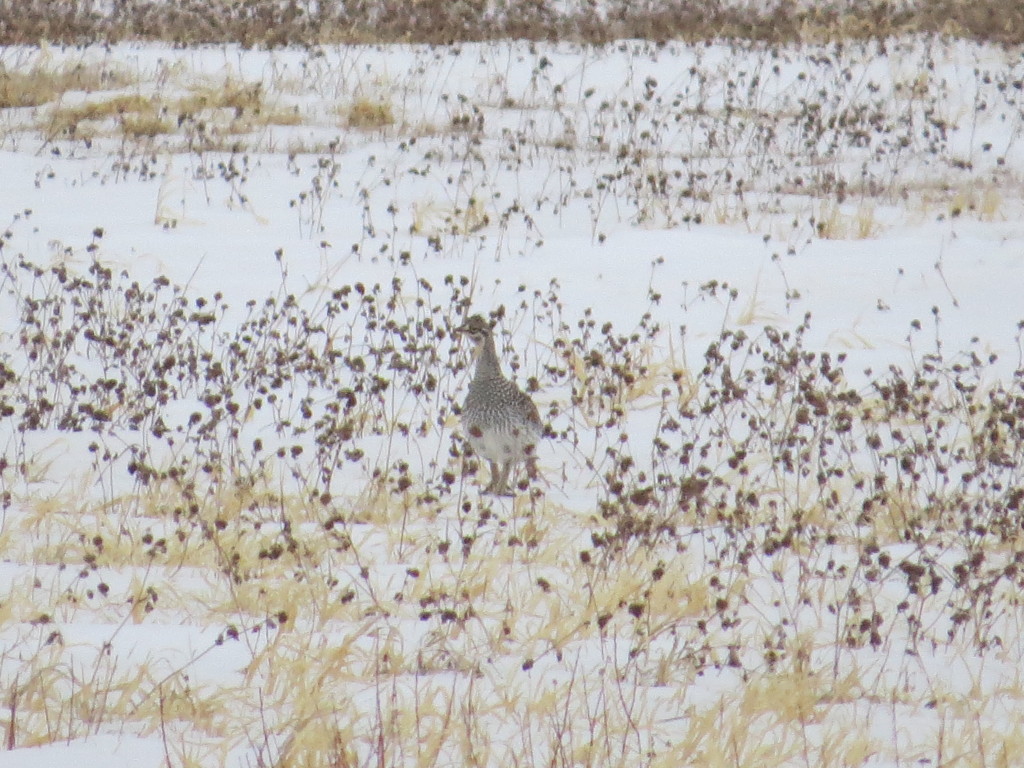 And they were doing their courtship dances! It was an incredible thing to watch even from a distance.
And they were doing their courtship dances! It was an incredible thing to watch even from a distance.
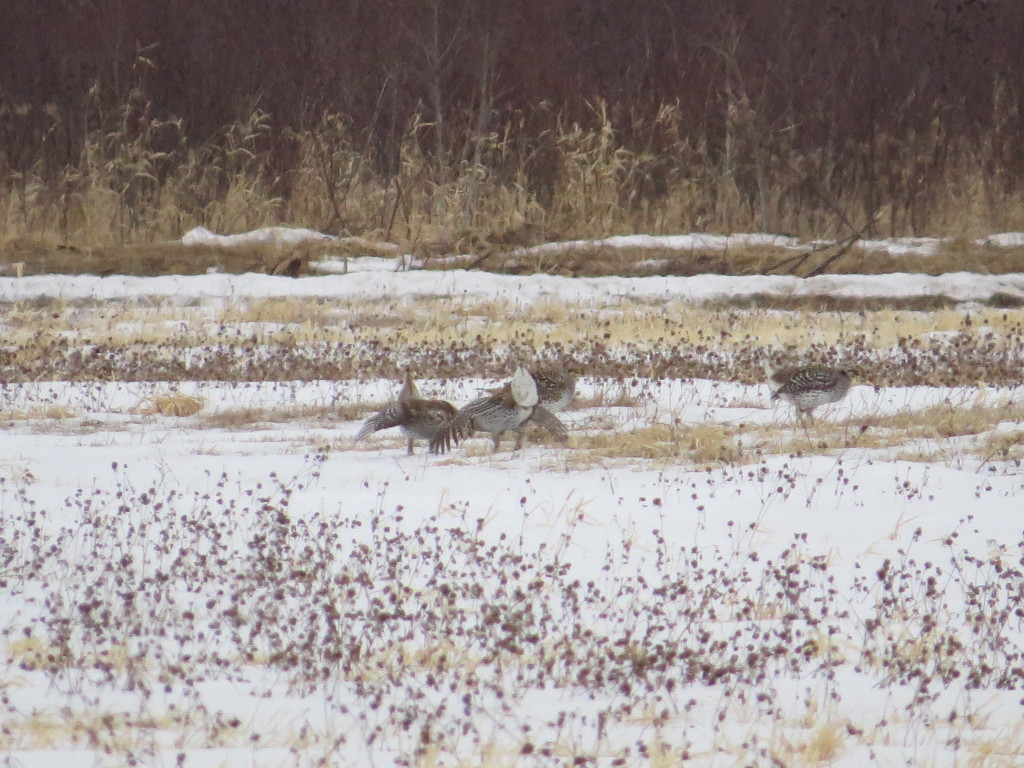
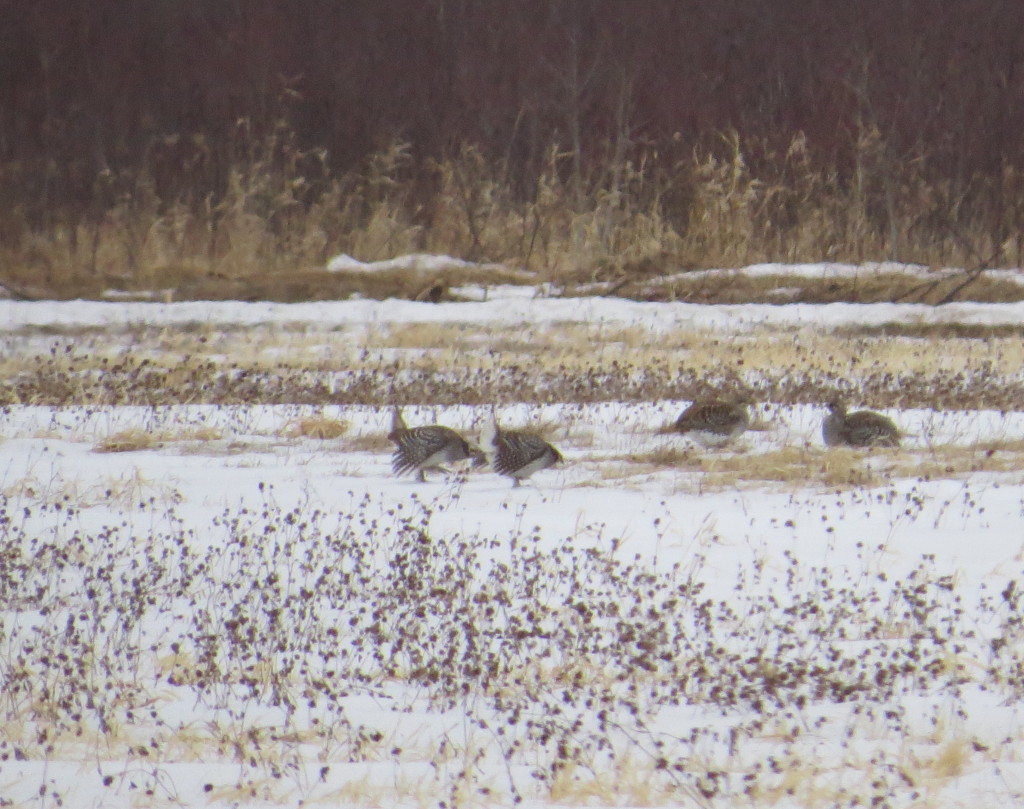
This was a life bird for Evan. It wasn’t even a state bird for me; I had seen a group of 12 or so about 18 years ago pecking grit off MN Hwy. 73 near Sturgeon. So for me it was fun to see this bird as a birder and add it to my state eBird list. Evan and I really enjoyed watching these grouse. We sat together, him on my lap, watching the dances on the camera’s LCD out the driver’s side window. We were quite content to just hang out and see what they’d do. Under the weight of a freshly minted 8-year-old I was reminded of how quickly time passes and how kids don’t stay little long. Sharing this moment with Evan and watching these birds is one I won’t forget.
The previous weekend my friend Steve Gardner saw these same Grouse on the same day Clinton saw them dancing on the lek. However, Steve saw them at a later time in the morning as they were running around the yard of the white house where many people have been seeing them come to the bird feeders. Piecing these two observations together, I knew that eventually the Grouse would head for the white house after their courtship dances. Sure enough, around 8:45, the theatrics were over and protagonist and antagonist Grouse alike hung up their theatrical costumes, slapped backs like old friends, congratulated each other on another great performance, and headed to the bar…er, bird feeders.
Evan and I hopped onto Co. Rd. 29 for better views. The lek is to the left of the garage and behind the row of pines about a quarter mile.
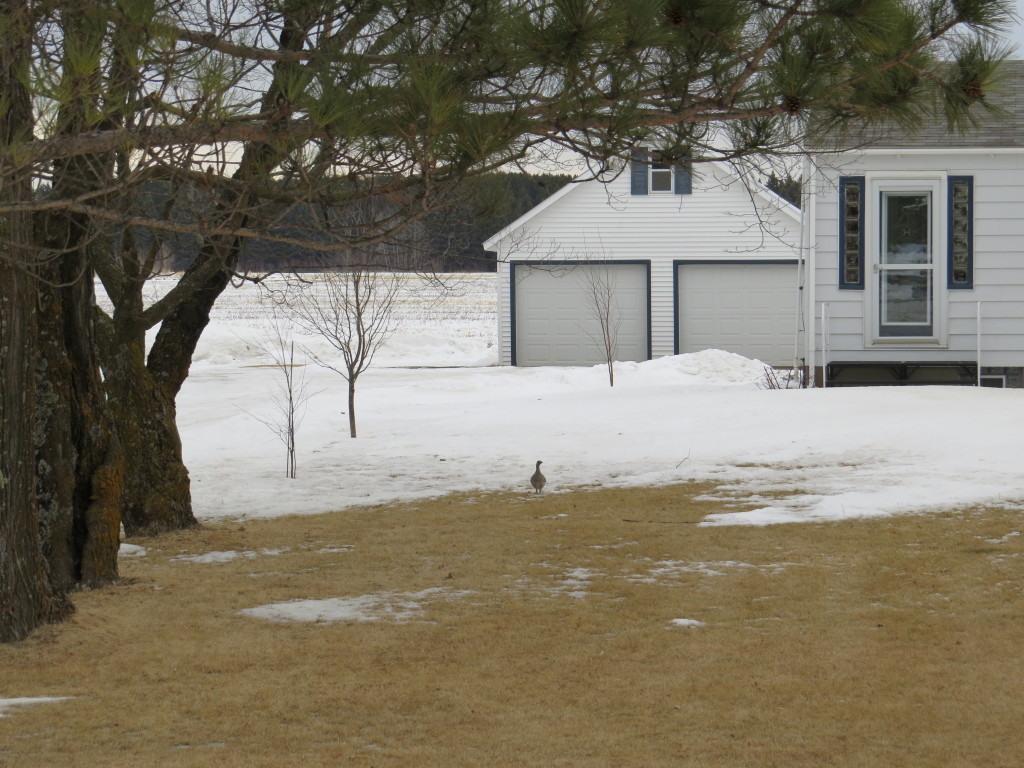
It was a gray day, but we were still able to photo crush some Sharptails. ‘Sharptails’ is a throw-back term to when I hunted them long ago in Montana. It’s just what people called them, and I have trouble letting go of that nickname for the cumbersome official name.
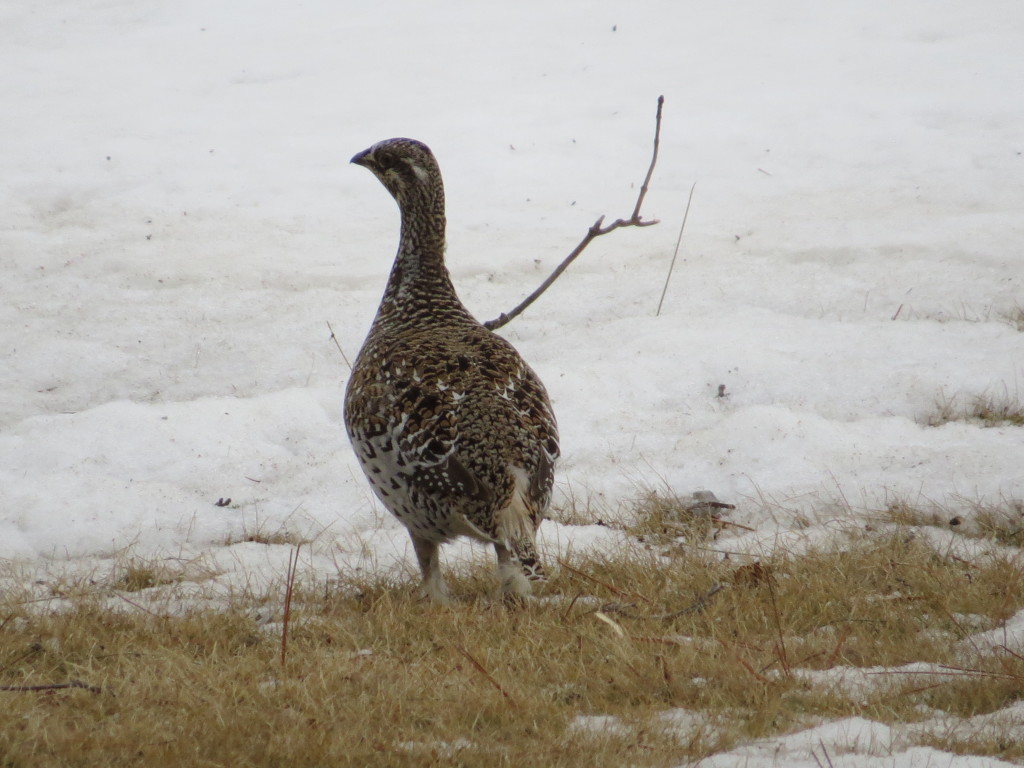
I didn’t get many shots because something spooked the Grouse back to the lek area. Looking at this last picture I took, I’m guessing a raptor of some sort was cruising overhead.
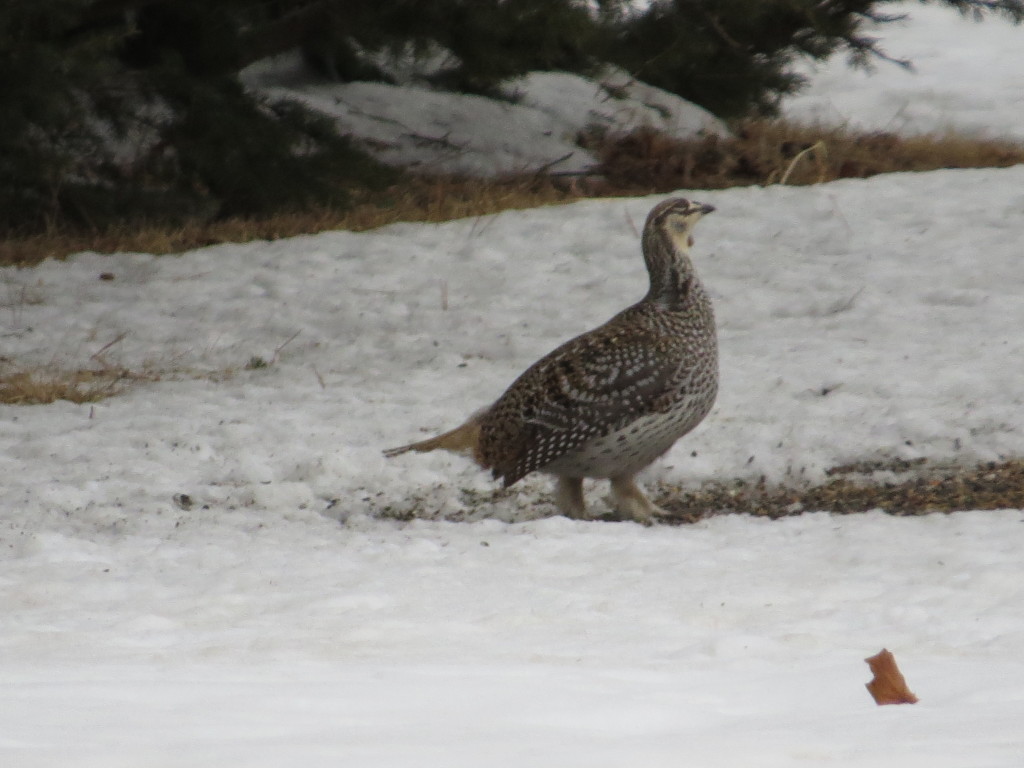
Like the Great Gray, these Sharptails made it easy for us to move on to something new in the Bog. Next stop was the Admiral Road feeding station; Evan needed a Boreal Chickadee lifer, and I wanted more photos as well as a lifer Black-backed Woodpecker that had been hanging out just south of the feeders.
By the time we got to Admiral Road, the overcast sky was gone, and it was a glorious blue-sky day. There were a couple of cars of birders at the feeders. We watched for the Boreal Chickadees for awhile but weren’t seeing them. So I got out and walked the road looking and listening for the Black-backed. An Ohio birder approached me asking what I was looking for, and I learned that he hadn’t seen the Chickadees after a half hour wait. Yikes. Maybe Evan won’t get that lifer today. Just as we were going to give up, though, the Boreals stormed the feeders! Mr. Ohio and Evan lifered at the same time. Evan was about 10 feet away from the feeders and didn’t need me to point out his new bird. So stunning in the now gorgeous light!
Time to move on again. As much as I’d like a Black-backed Woodpecker, I was more anxious to get a Hawk Owl for the winter. I can probably get the resident Black-backed Woodpecker in the summer. On the way to Hellwig Creek (mile marker 29) on Hwy. 53, we bumped into a Northern Shrike and three Black-billed Magpies. How is that you can walk up to these things in a parking lot in Colorado and club them if you choose, and yet I can never get one to stay still for a photo in northern Minnesota?
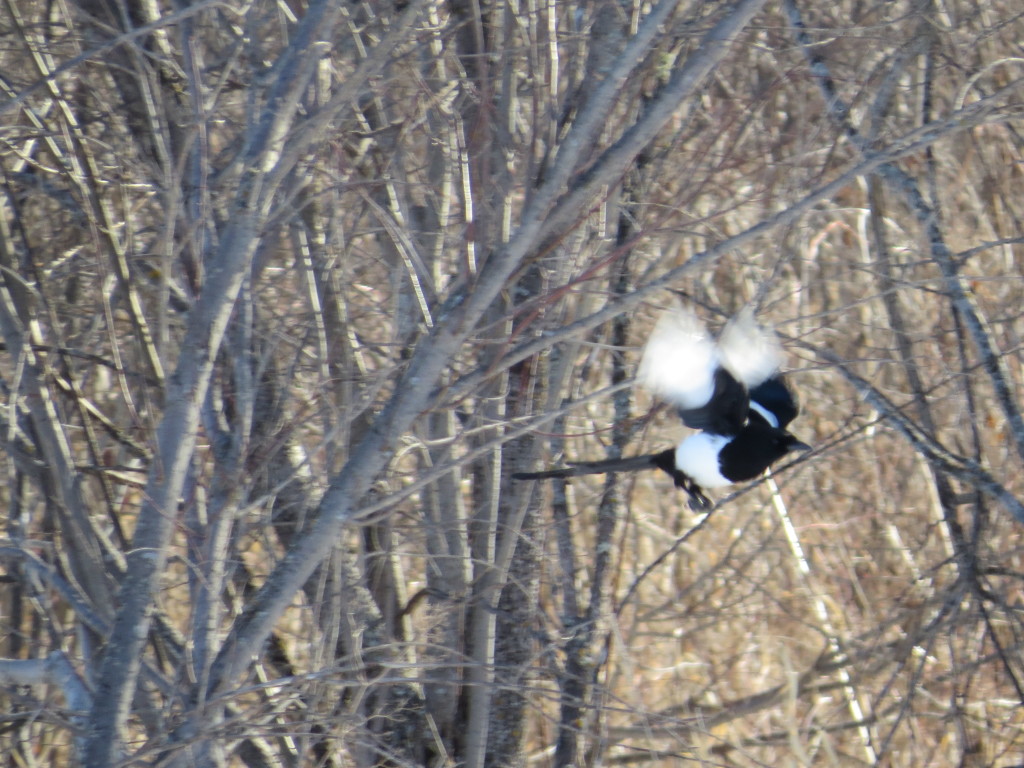
Evan and I were now racing the clock as we went south of the Bog toward Canyon on Hwy. 53 in search of the Hellwig Hawk Owl. Grandma was bringing Marin southbound after a morning of tea parties, nail-paintings, etc to meet us so the kids and I could leave the area before noon to get back home in time for Evan’s piano lesson. Hawk Owls are quite conspicuous when present, often perching on top of Spruce trees. I just could not locate it. Maybe it had gone north already. Nuts! I really wanted to see this owl again. This was one of my main birding goals for the trip.
Evan and I headed north again to meet up with Grandma and Marin, only we were stopped in our tracks by a Timber Wolf crossing the road! It stopped broadside just 30 feet from the car, but I couldn’t get the camera out in time. Instead I got a running shot as it went down the snowmobile trail.
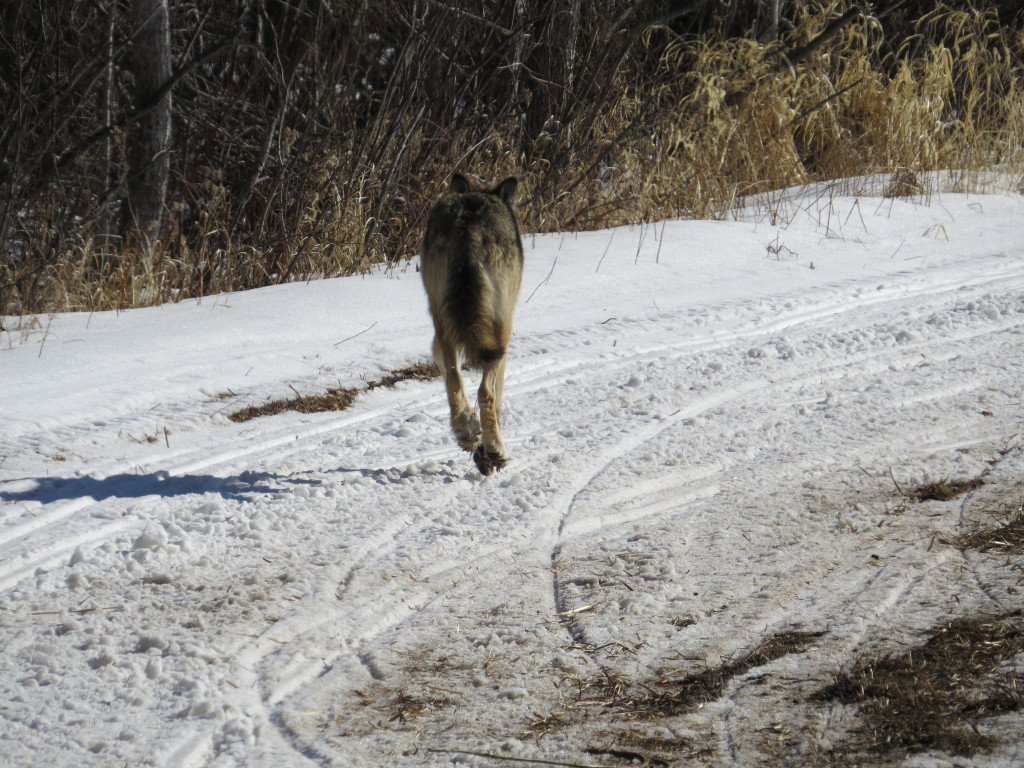
Sadly we discovered the wolf was injured as it carried one paw. Evan was pretty distraught over it, wanting me to call somebody even. I assured him, perhaps incorrectly, that the wolf would be okay. (Though it did look a bit skinny.)
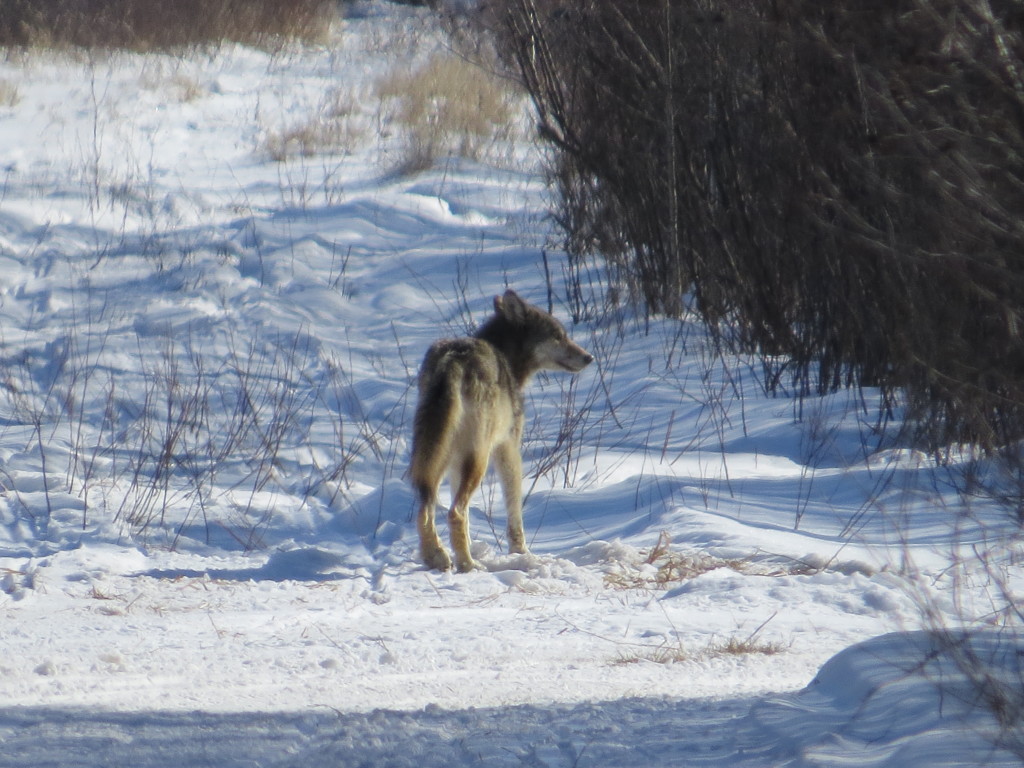
After rendezvousing with Grandma and Marin at the Anchor Lake Rest Area, the kids and I were now headed south. I would be going by mile marker 29 one last time. It was my last hope for Hawk Owl. I texted JG Bennett and Clinton Nienhaus to get more info on which side of the highway it had been seen. JG shot back right away that it was the west side. At least I now had somewhere to focus. As we went by Hellwig Creek, I scanned every Spruce top. Nothing. Then, there! A glob in an Aspen tree of all places was moving! It was Hellwig, the Hawk Owl!! Do you see him? And do you see all those perfect Spruce tops he’s NOT sitting on?
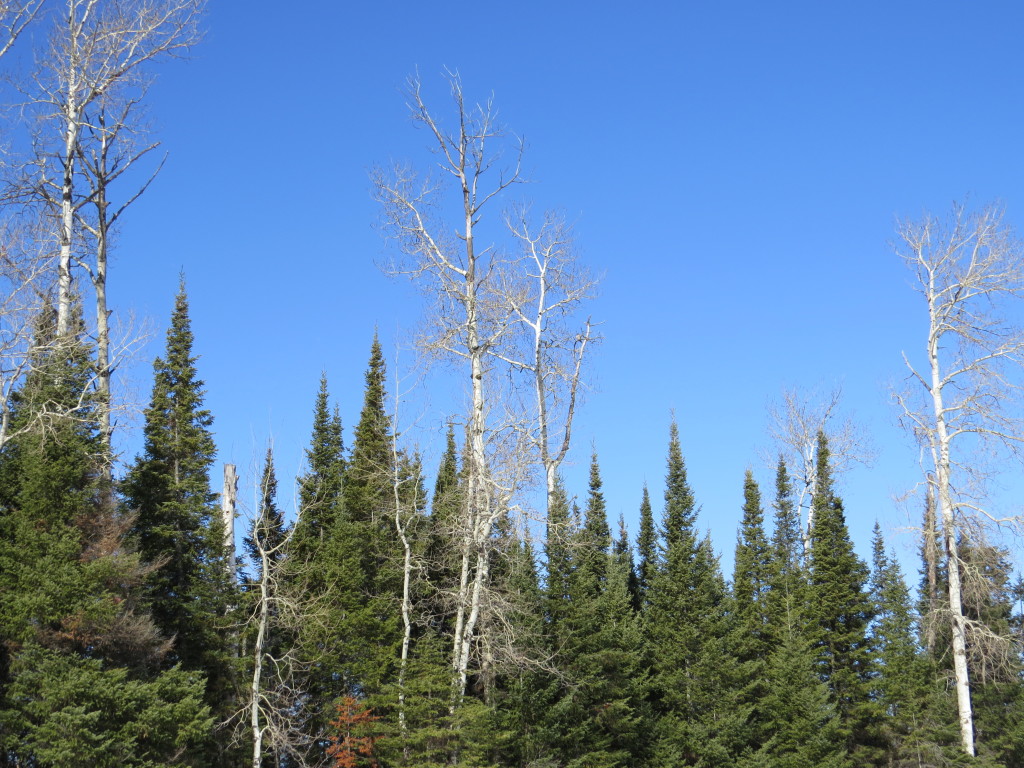
This was my first time photographing a Northern Hawk Owl with a blue sky background. Now if only I could get the classic shot on top of a Spruce with a blue sky!
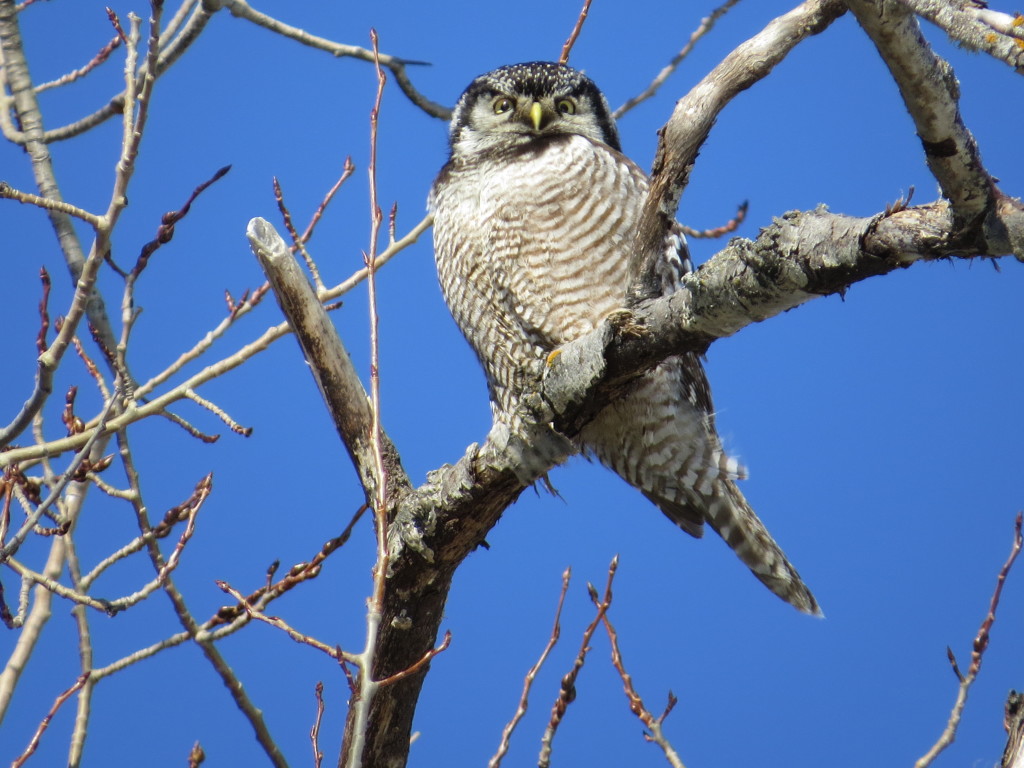
This Hawk Owl didn’t care about anything, especially that I was underneath photographing him. Didn’t bother him one bit. In fact, he went about his business of becoming the cleanest Hawk Owl in the land. These things remind me of cats.
First the feet.
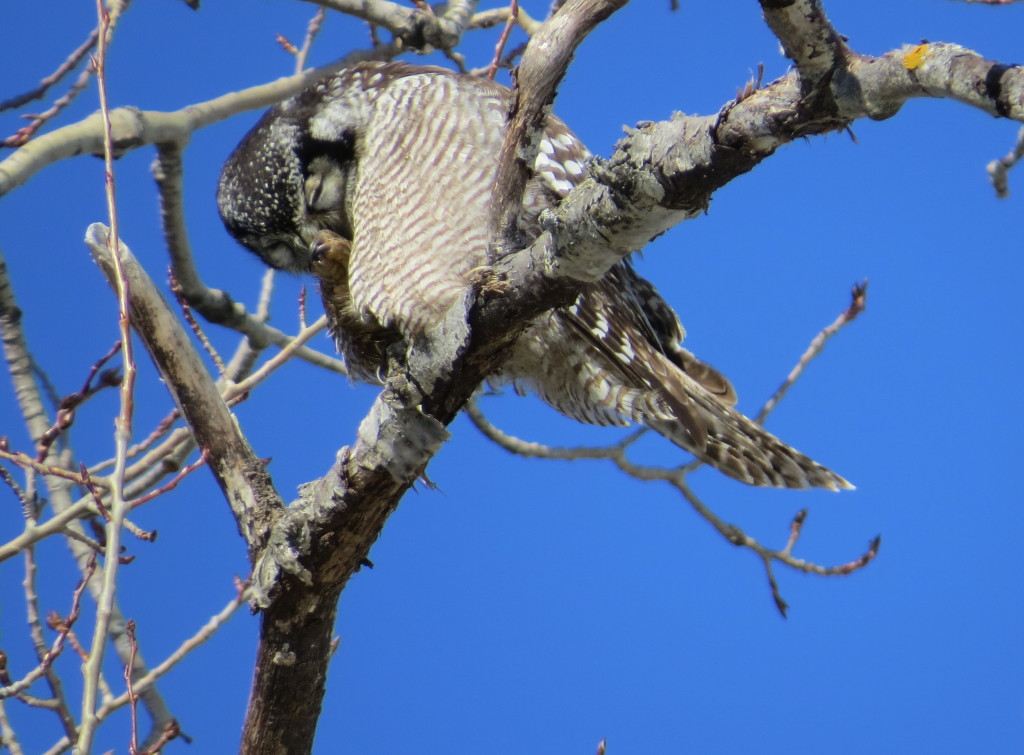
Then the pits.
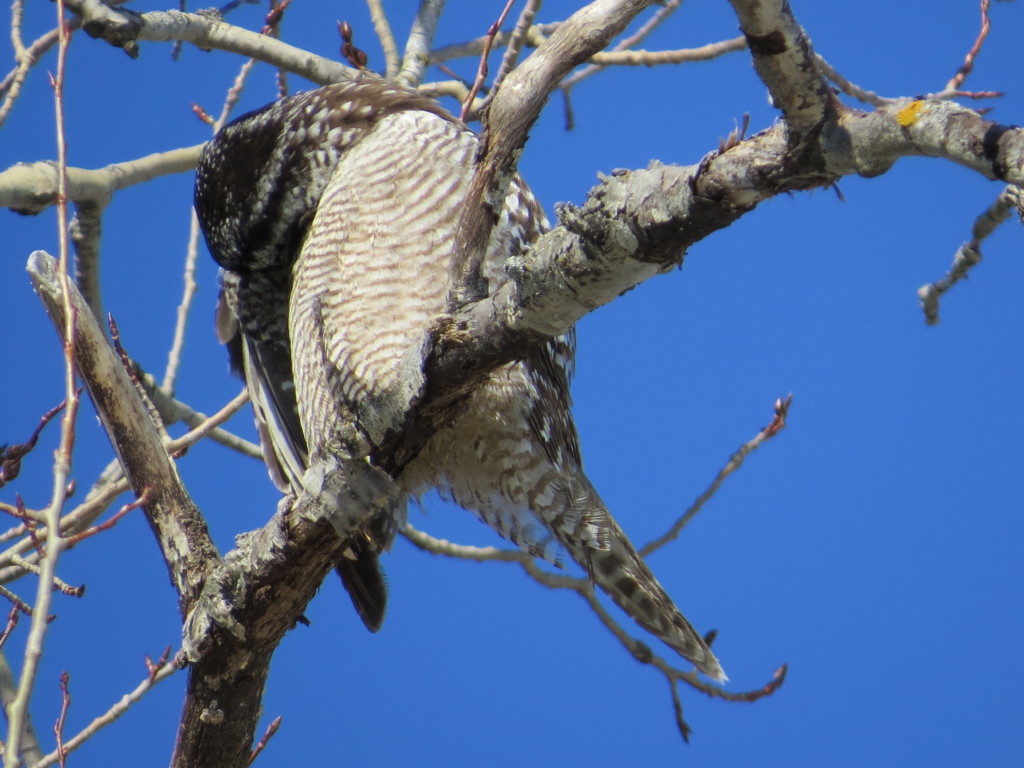
And then the uh, you know.
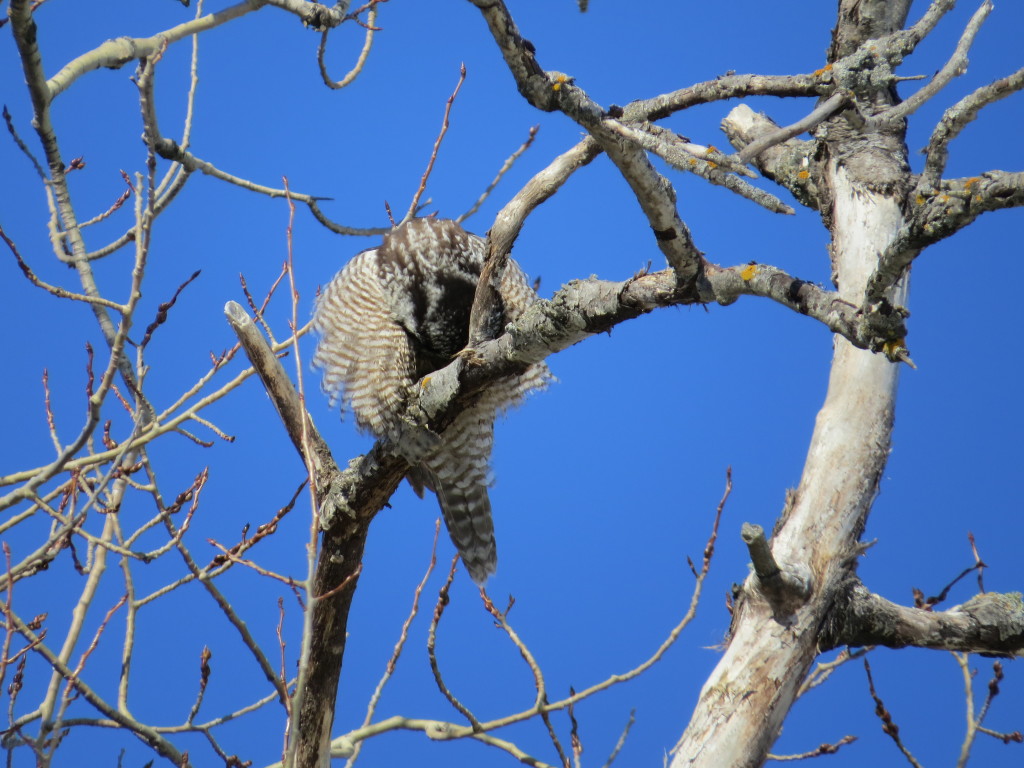
Hawk Owls, like many owls, are birds of many faces and poses.
Here’s Mr. Bean.
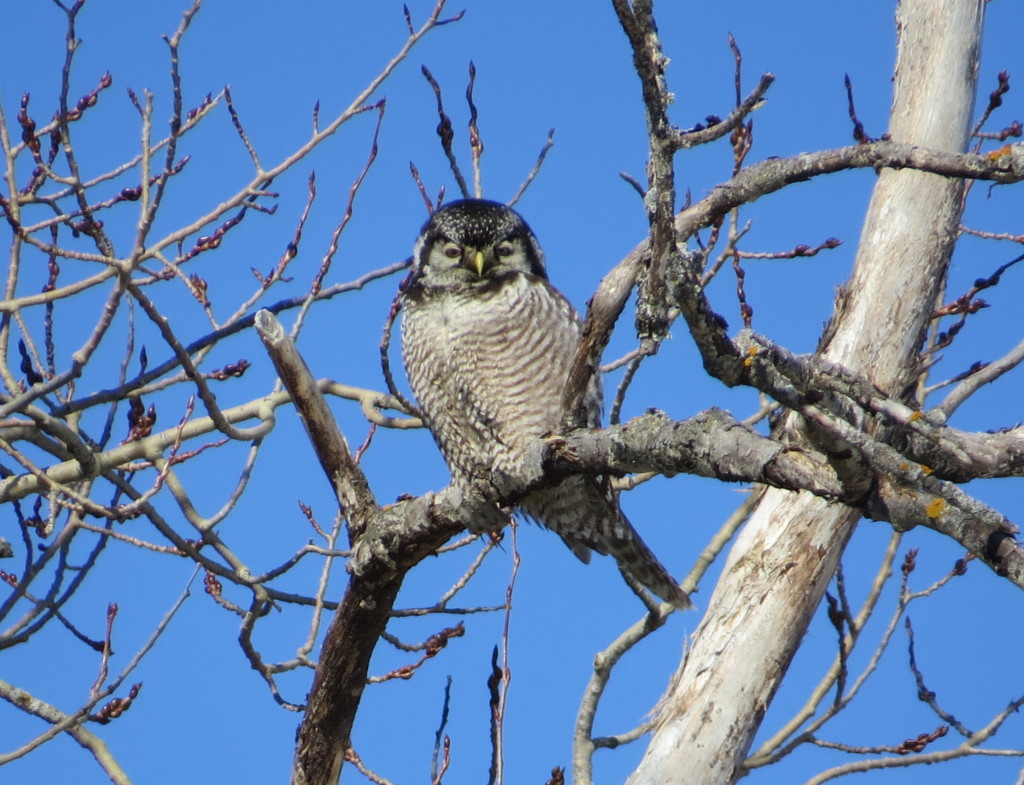
Here’s Oscar the Grouch
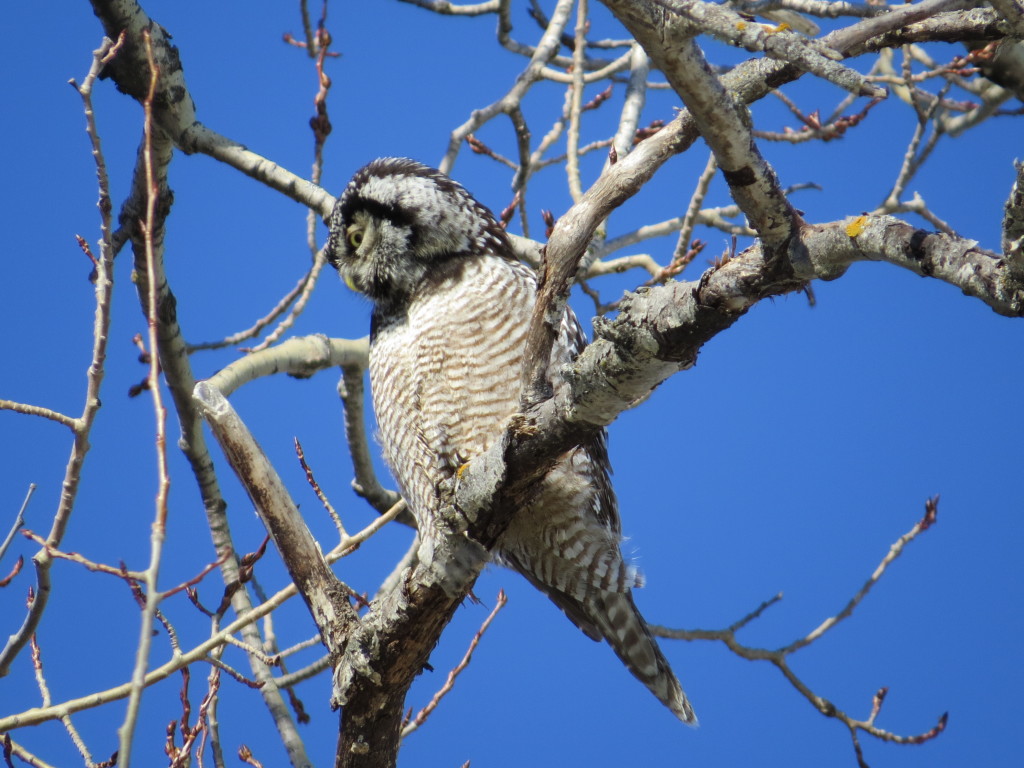
And finally the classic look is its namesake, a bird that looks like an owl but perches like a hawk.
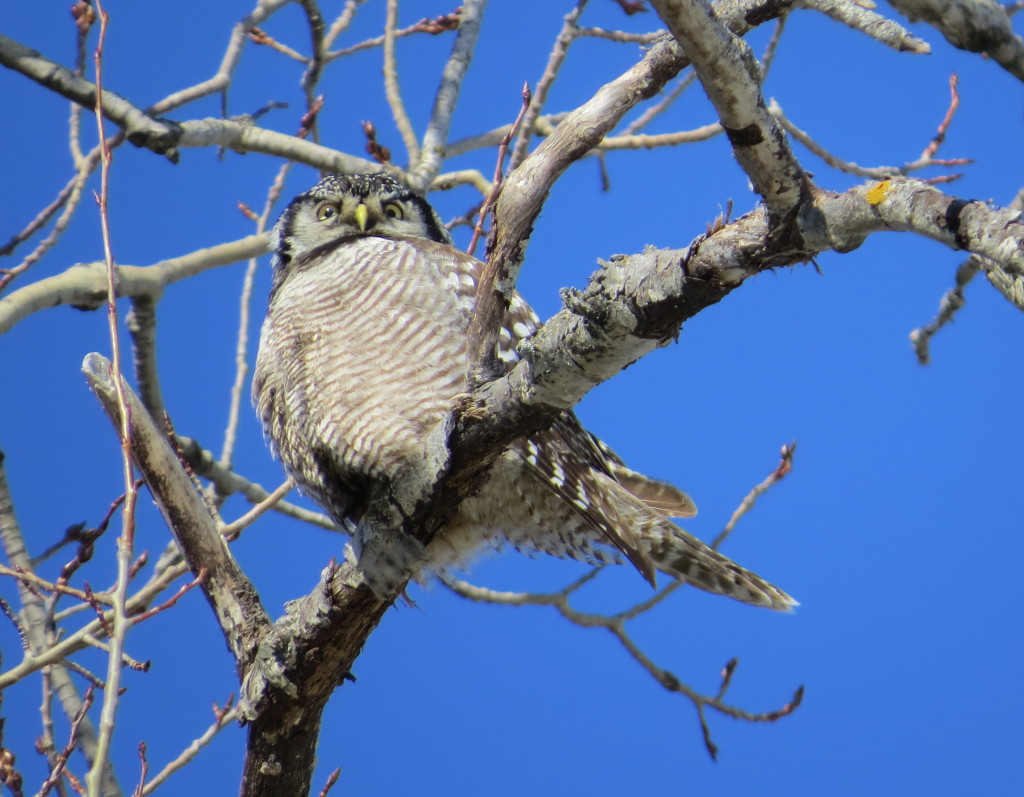
Here’s another short video that captures some of the essence of this awesome owl.
So there you have it. Two lifers for Evan (Boreal Chickadee and Sharp-tailed Grouse), four birding objectives of mine met (lifer Gyrfalcon, photograph of Boreal Chickadee, eBird record of Sharp-tailed Grouse, and year bird Northern Hawk Owl), and sprinkle in a bonus Great Gray Owl and other cool northern birds for taste–I’d say it was a successful end-of-winter field trip up north. And we were home around the time that Evan would have gotten done with school for the day.The northern gulls, sea ducks, and Black-backed Woodpecker will have to wait for another winter trip. For now, though I must tie up some loose ends and prepare for a lifer-fest in Arizona in a couple weeks.
Gyrfalcon
Gyr!
Just as with beer, cheese, and processed meats, occasionally one must step foot in next-door Wisconsin for the finer things in life, and birds are no exception. Last spring their state-record Garganey just over the border drove Minnesota and Wisconsin birders wild. This winter a slightly less cool bird-which by no means diminishes its status!-showed up in the twin-port city of Superior, Wisconsin. This large bird, figuratively and literally speaking, that chose to take up winter residence on the Wisconsin side of the Blatnik Bridge also had Minnesota birders worked up into a frenzy. Yes, we are talking about the Gyrfalcon, a falcon so superior in size and awesomeness to its lesser brethren that seasoned northern birders drop the “falcon” altogether when uttering its name. Gyr (pronounced “jeer”-trust me, I heard it spoken by the state’s top birder) was first caught by raptor bander, Dave Evans, in Superior and word slowly got out that this arctic predator was in town. Better yet is that it had taken up residence at the Peavey grain elevators on Connors Point where it spends much time loafing and enjoying spectacular views of Lake Superior when not feeding on pigeons in the harbor.

I, too, had Gyr fever. I had many false-starts and set-backs for getting up north the past month, but I finally made it happen. It took much planning, namely sending the kids home with Grandma and Grandpa after a double birthday celebration, sending Melissa home to a quiet house, and sending myself solo to Duluth/Superior and beyond. It was win-win-win. Though with some atrocious dog diarhhea episodes at home while 3/4 of us were away, that conclusion may have to be settled far from now by the bird-blogging historians.
But, anyhow, I felt free as a bird as I drove north, much like this Rough-legged Hawk I saw along the way.
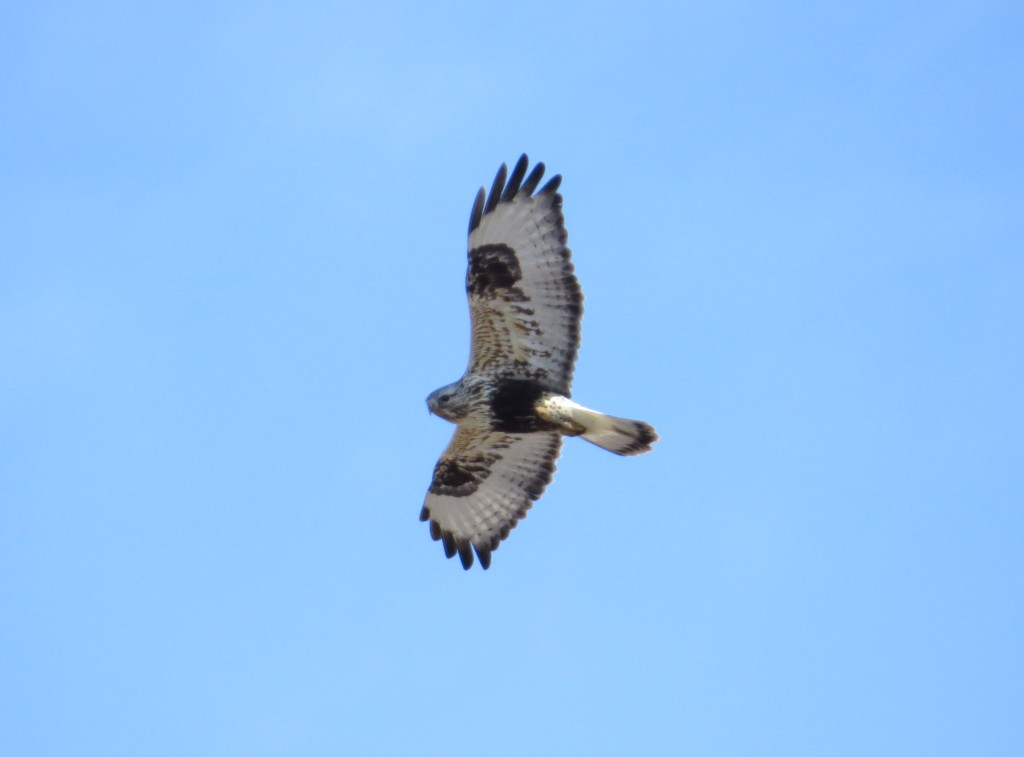
Duluth birder, JG Bennett, knew I was coming and graciously agreed to help me locate Gyr – not necessarily an easy task as many birders have dipped on seeing it. In exchange I’ll be helping him find his Blue Grosbeak lifer this summer–I think I’m getting the better end of this deal. JG called me when I was about an hour from Duluth to tell me that the Gyr was present. Nice guy that he is, he babysat the thing for over an hour until I showed up. Considering the distance from the viewing area and the massive gridiron structure, I was glad he did.

Even in this next photo you can get a sense of the size of the Gyr (look for the bump near the top right).

At times like this I’m thankful for the zoom capabilities of my camera. Quality leaves a lot to be desired, but, hey, no one’s getting killer shots or even great views of this raptor.
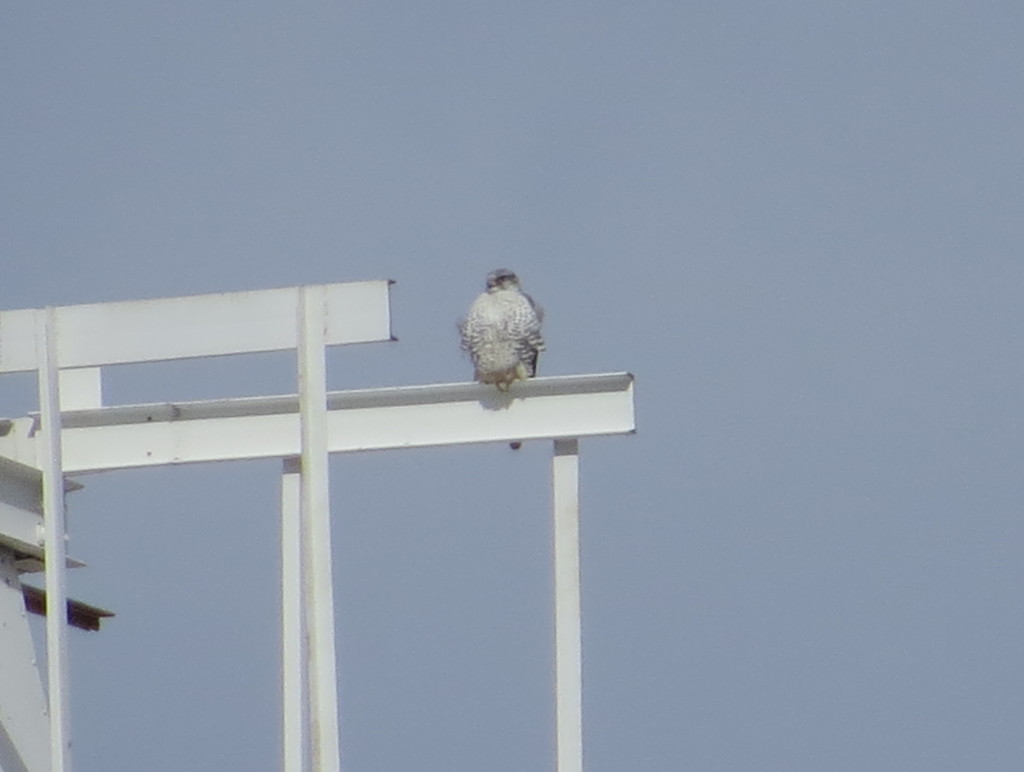
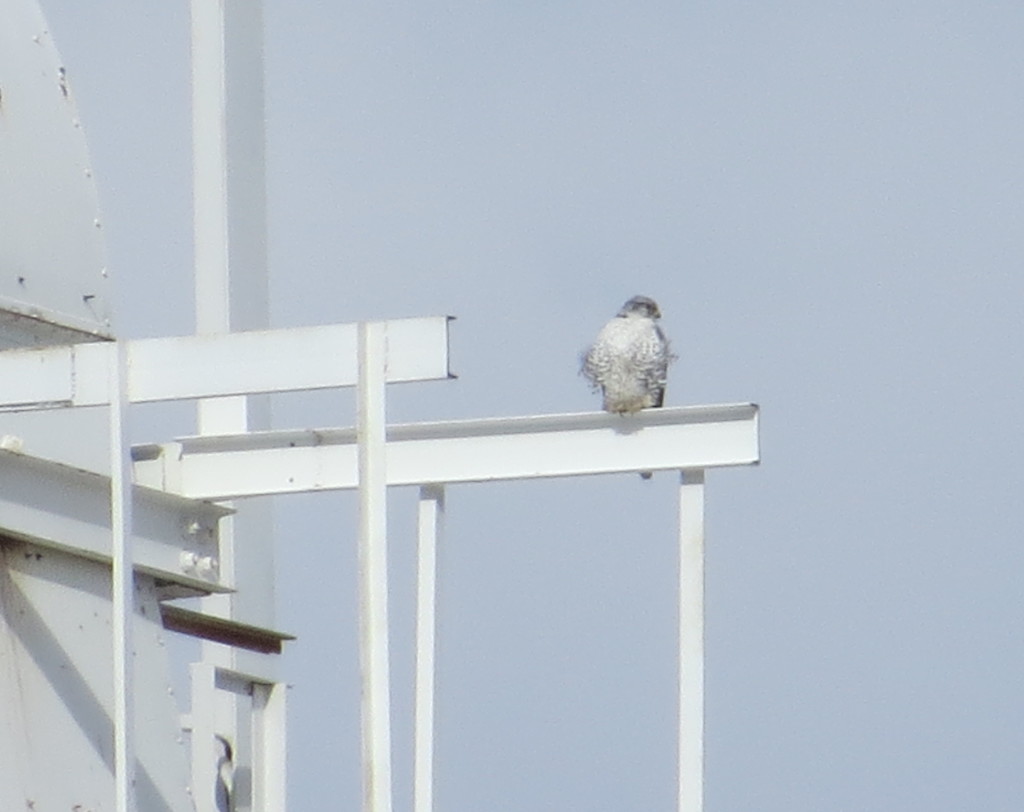 Some fun history on Gyr is that this same individual was caught and banded in 2003 in the Duluth/Superior area. At the time it was a third-year bird. It ended up returning every winter for four years and then did not return until this year! Given when it was banded, the age of this male Gyrfalcon is estimated to be 14 years 8 months–the oldest Gyrfalcon on record!
Some fun history on Gyr is that this same individual was caught and banded in 2003 in the Duluth/Superior area. At the time it was a third-year bird. It ended up returning every winter for four years and then did not return until this year! Given when it was banded, the age of this male Gyrfalcon is estimated to be 14 years 8 months–the oldest Gyrfalcon on record!
I spent about a half hour or so with the bird who never, ever moved off his perch, even when pigeons flew right by his head. By seeing the main target right away, my time was then free to fritter away as I pleased. I had northern gulls to pick up (Glaucous, Iceland, Great Black-backed), but the Duluth shipping canal was froze over, so there went any hopes for gulls or sea ducks. Instead I decided to try to track down one of three Northern Hawk Owls in the Duluth area as it had been over a year since I had seen this cool bird. The strong winds were keeping the owls hidden though. I couldn’t find a single one. Duluth birds in general were giving me the snub, including this Pine Grosbeak.
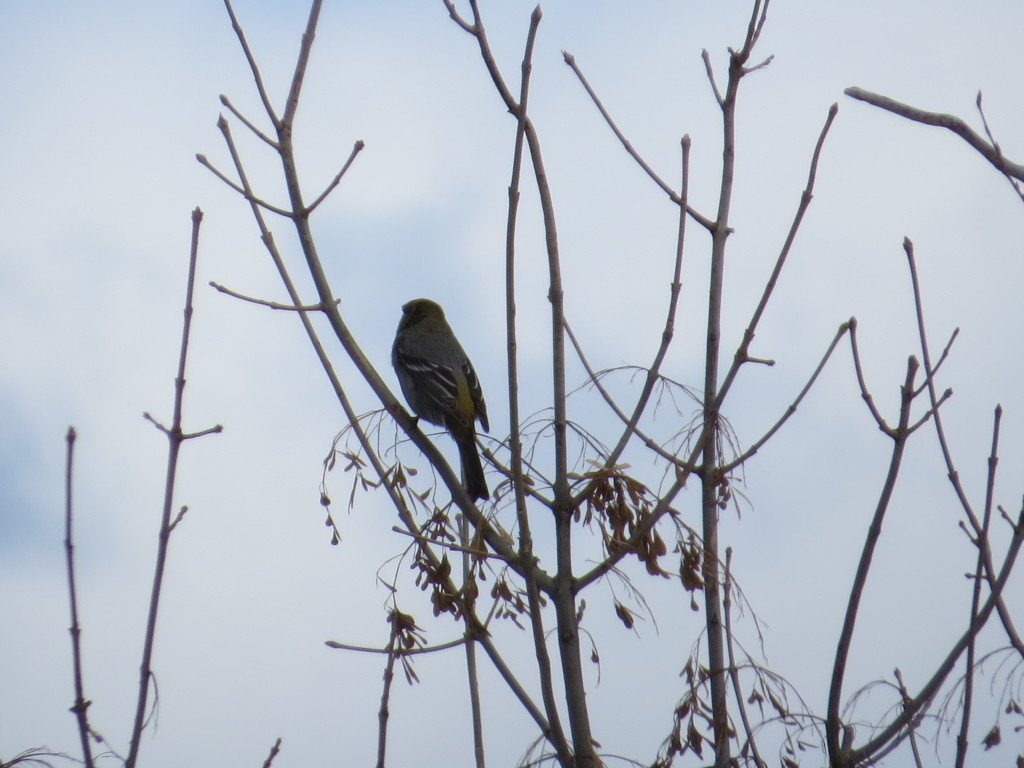
I had one last hope for the Hawk Owl (“Northern” is a bit superfluous and is often dropped by northern birders). One had been hanging out just south of the Sax-Zim Bog near Canyon. Specifically this bird could be reliably found right at mile marker 29 at Hellwig Creek. I decided that the Duluth Hawk Owls were a lost cause, so I might as well try for Hellwig and then use up my remaining daylight hours in the Bog. Hellwig was also a no-show, so it was on to the Bog for me.
I have several unfinished birding projects of sorts for the Sax-Zim Bog–a lifer or two, better photo ops of some, officially getting another on my state eBird list, and so on. Anyhow, one of my top goals was to get a good photo of a Boreal Chickadee, so I made a bee-line to the Admiral Road feeding station. There were the usual suspects around. Gregarious Gray Jays are always up for a photo-shoot.
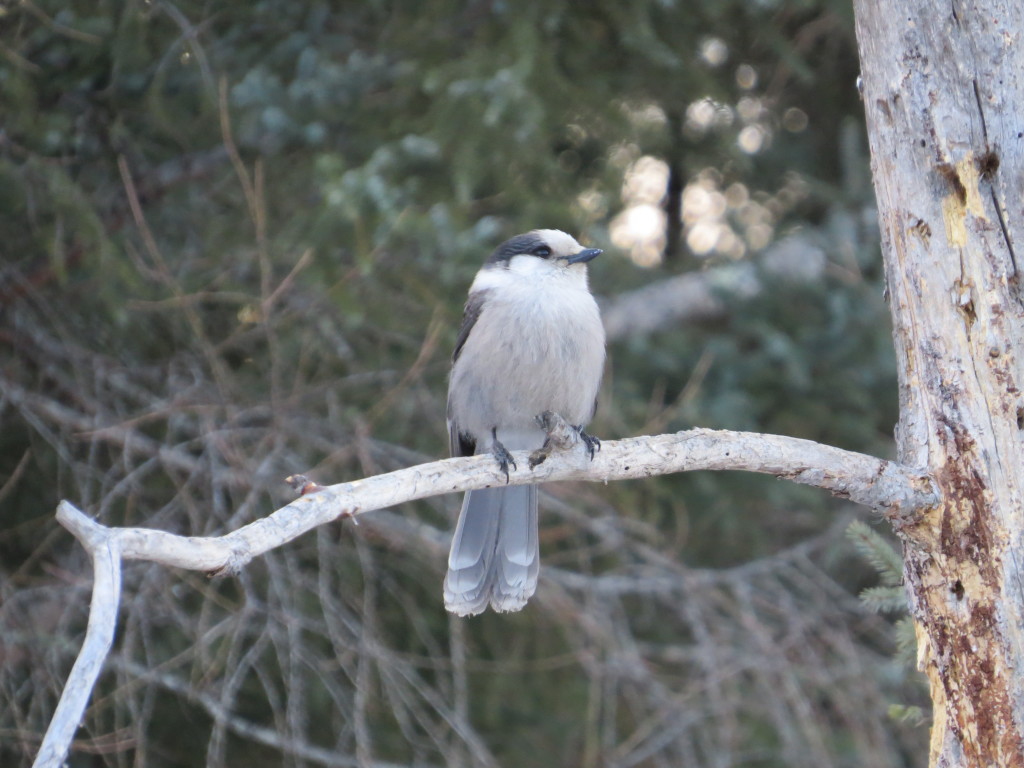
Common Redpolls were everywhere. A couple looked whiter and plumper than the rest. I’m thinking this one looks good for Hoary based on the small, conical bill and faint streaking on the flanks. It had the overall frosty appearance of a Hoary.
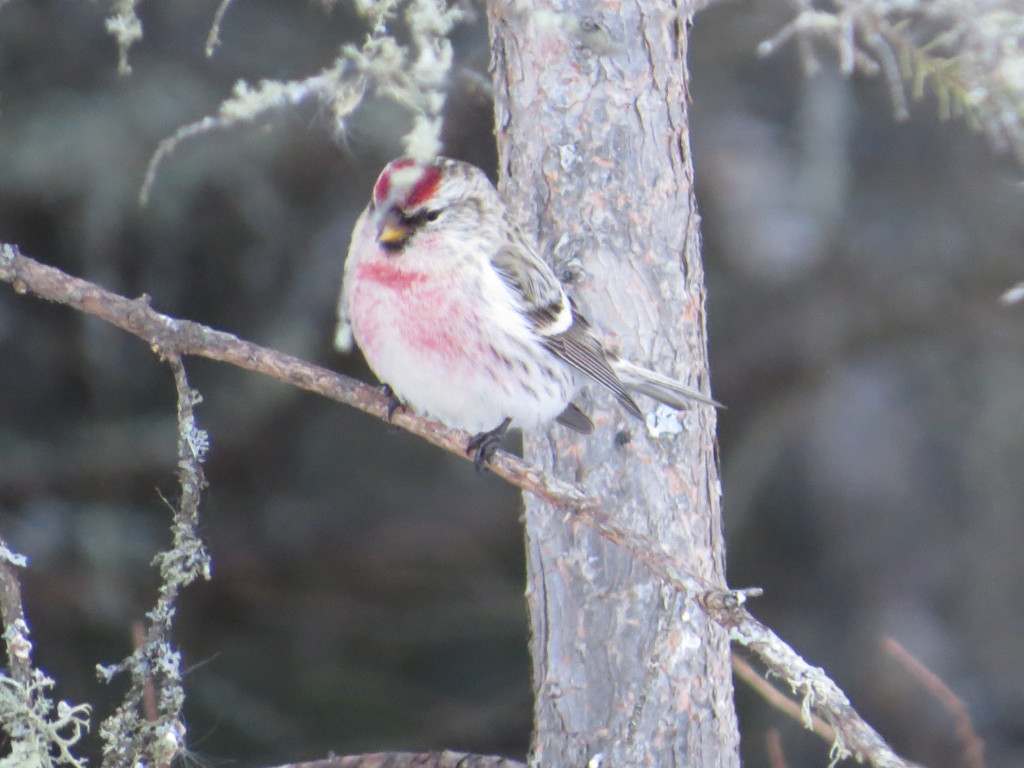
The Boreal Chickadees can be quite finicky. Often birders will have to wait up to a half hour or more for just a flash appearance. That was my experience last year. This year was a different story as two of them were coming out from the Spruce bog constantly in the last hour of daylight to feed on their favorite winter food–peanut butter smeared on branches. Visitors to Sax-Zim are encouraged to slather up some branches with the creamy stuff (and donate their fair share of PB) at the Admiral Road feeders when they visit. It’s crazy, but it works.
This Boreal Chickadee momentarily, and perhaps regretfully, chose suet over PB.
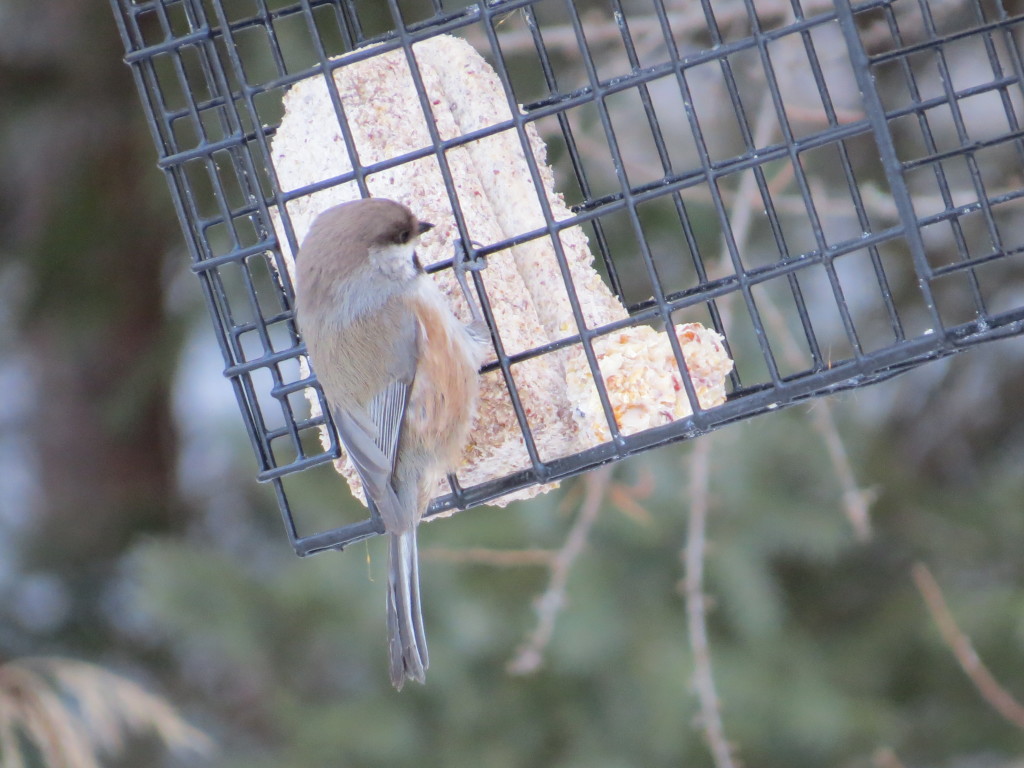
Admittedly I’m a bit smitten with this bird. I’ve never really been able to answer the question of “What’s your favorite bird?”, but this one has to be right up there. I may be a bit biased, but this, in my opinion, is the best Chickadee. Perhaps that’s because it leads a secretive life in the deep, mysterious Spruce bogs alongside Great Gray Owls and Spruce Grouse and is rarely seen or perhaps because it is so visually stunning.
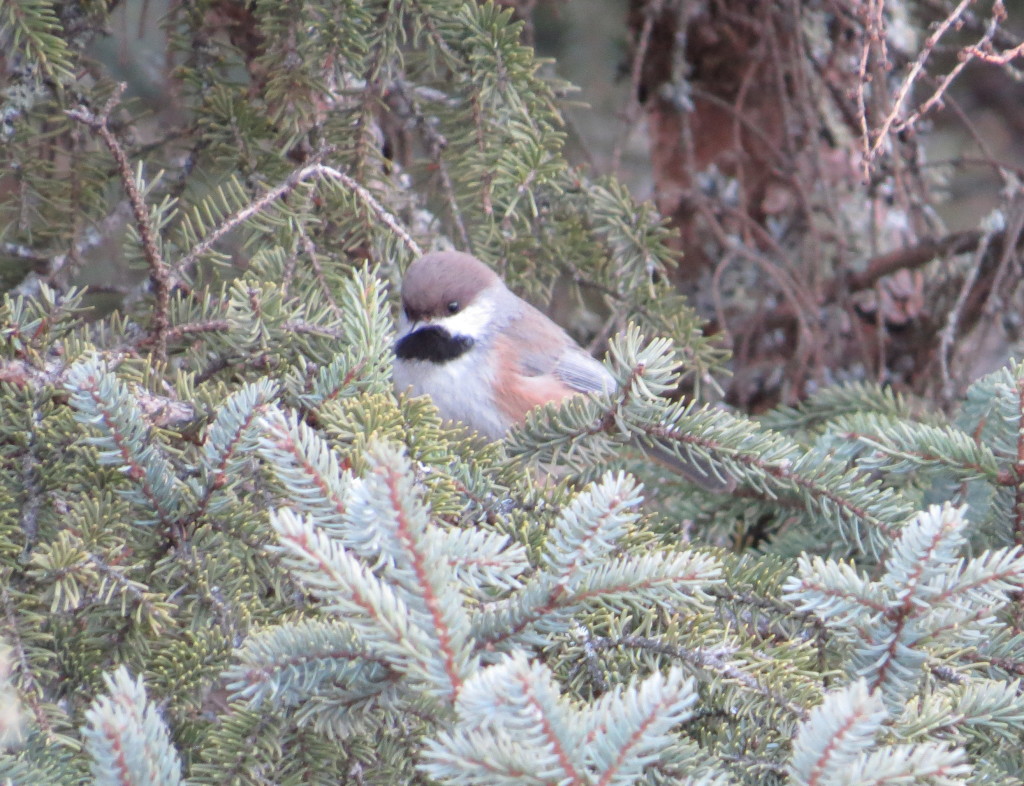
I’m finally at peace with the Boreal Chickadee as I got the photo I wanted–even if it does have a little peanut butter in it.
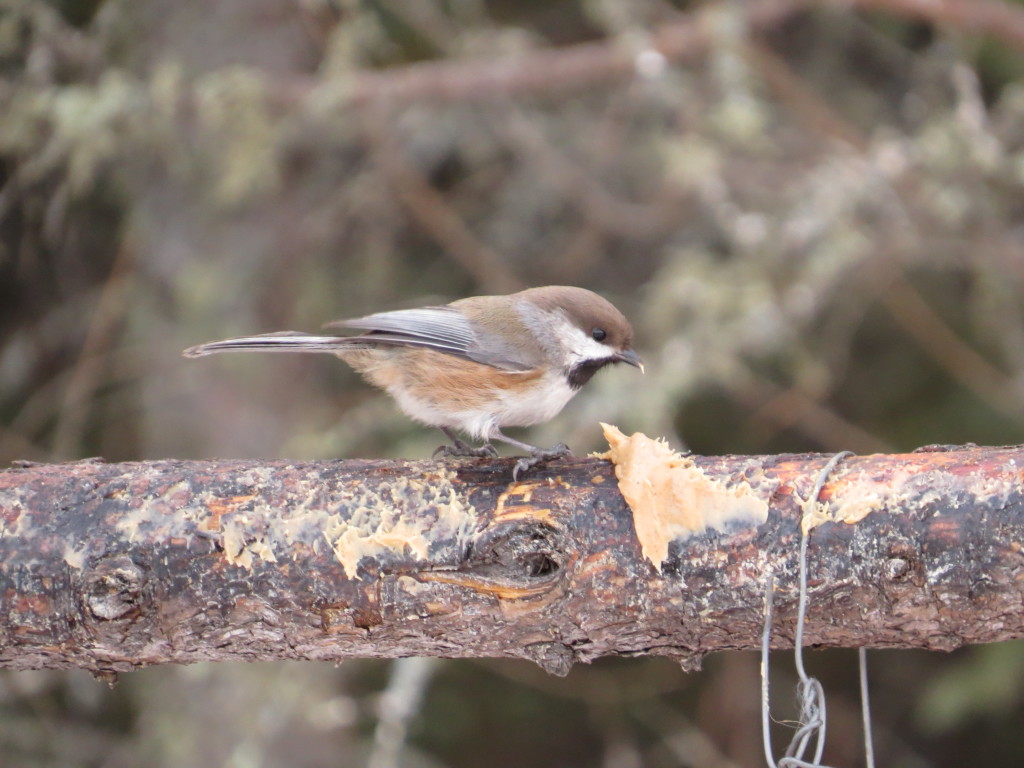
After hanging out with the Boreal Chickadees, who, by the way, are just as tame as their Black-capped cousins, I headed to Grandma and Grandpa’s to spend the night with the kids and prepare for the next day of birding which is arguably the best day I’ve ever had in the Sax-Zim Bog. Stay tuned…there will be videos!
Winterfowling – A Black and White Affair; No Kids Please
Things have been pretty bleak on the prairie lately as far as birds go (or as far as anything goes, actually). The Snowy Owls packed their bags and left long ago. Birds of the field have been in short supply or absent altogether. Adding insult to this injury is that it has been extremely cold these past few weeks as temps have been well below zero. Hoth is looking like a pretty good vacation destination these days both for its scenery and temps.
So what’s a birder to do? Look at waterfowl, of course! Wait, what? Isn’t it a frozen wasteland here? Birders know a lot of crazy, cool stuff about local, natural phenomena that the vast majority of area residents know nothing about. One such phenomenon is knowing where open water exists in the county during the winter months. When I got into birding a couple years ago, I was blown away to find out that several species of waterfowl have been recorded on past Willmar Christmas Bird Counts. Heck, I was blown away to find out we had open water. I mean, every bit of water is seemingly, or should be, in a solid state, right?

“Let’s drive our truck on the lake by the open water,” they said. “It’ll be fun,” they said.
The further I went down this rabbit hole of birding, the more secrets I’ve learned. One of those secrets is that small numbers of Trumpeter Swans overwinter in the Spicer/New London area. I was reminded of this when local birder, Coralie Jacobson, posted on Facebook that she saw a bunch of swans on the outflow of Green Lake at the northeast corner.
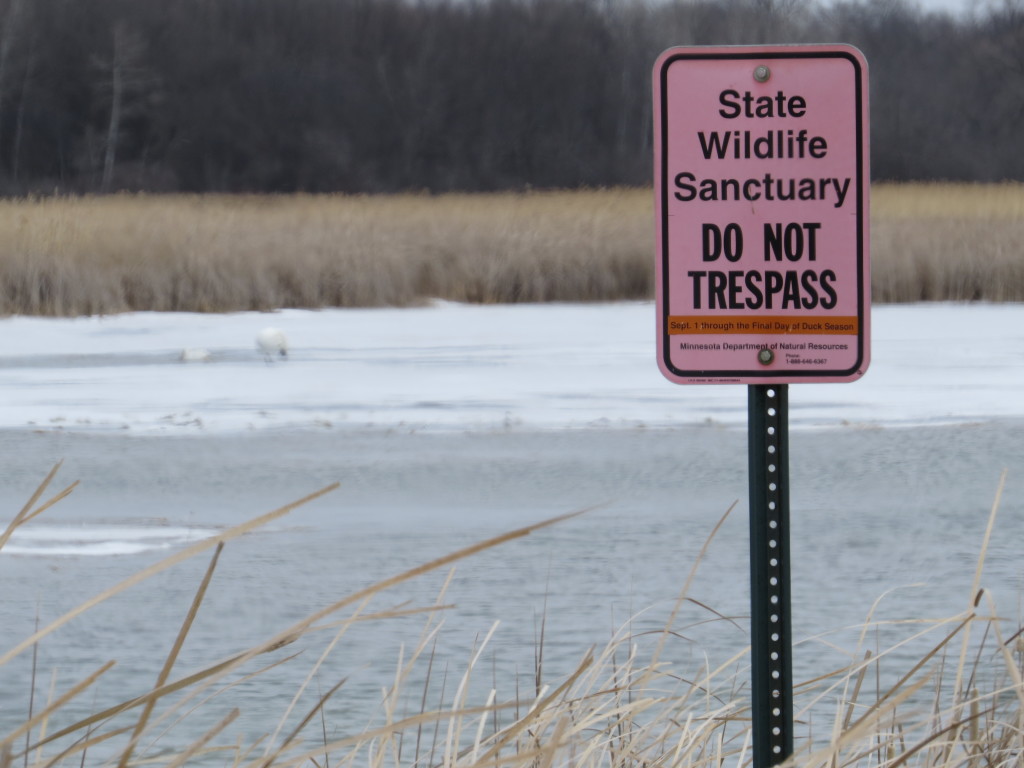
I’ve seen plenty of Trumpeters in the county, but seeing them in February is something I had never done and needed to document for eBird. It was certainly the cure for the winter birding blues. A couple weeks ago I drove up to Green Lake and was not disappointed. In all, I counted 19 Trumpeter Swans. These DINCs (Double-Income No Cygnets) were enjoying quite the love fest, being all exclusive from the other swans.
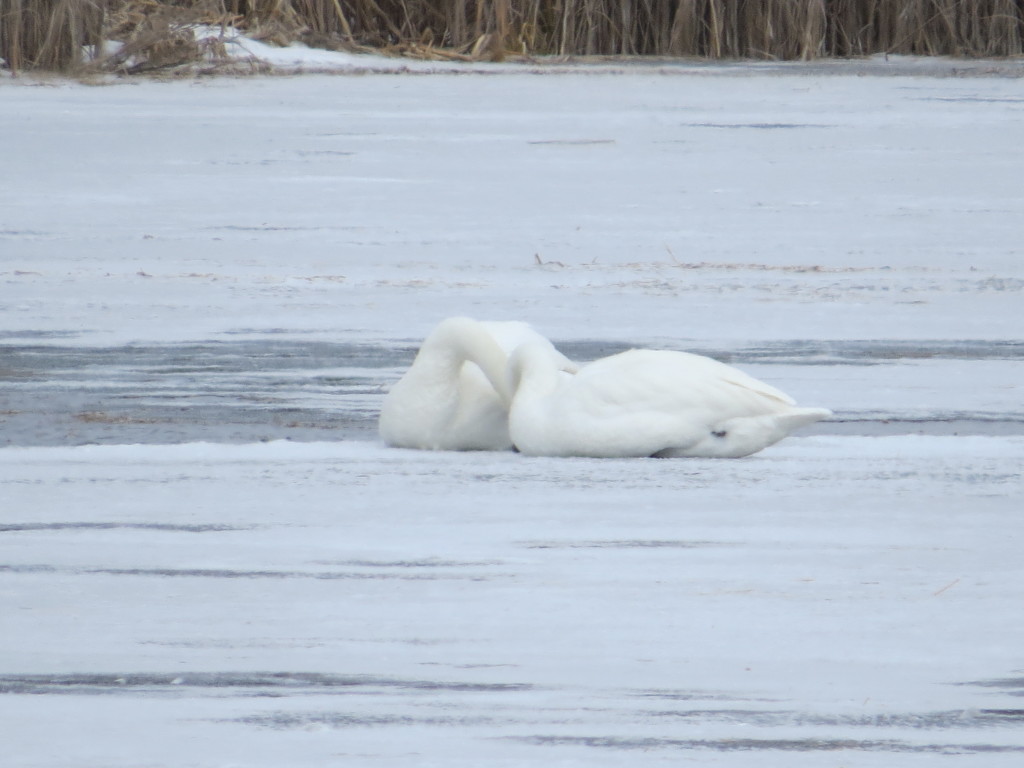 When not necking and acting like that adorable couple that makes people cringe, they were striking contortionist poses and looking awfully dapper in their crisp black and whites.
When not necking and acting like that adorable couple that makes people cringe, they were striking contortionist poses and looking awfully dapper in their crisp black and whites.
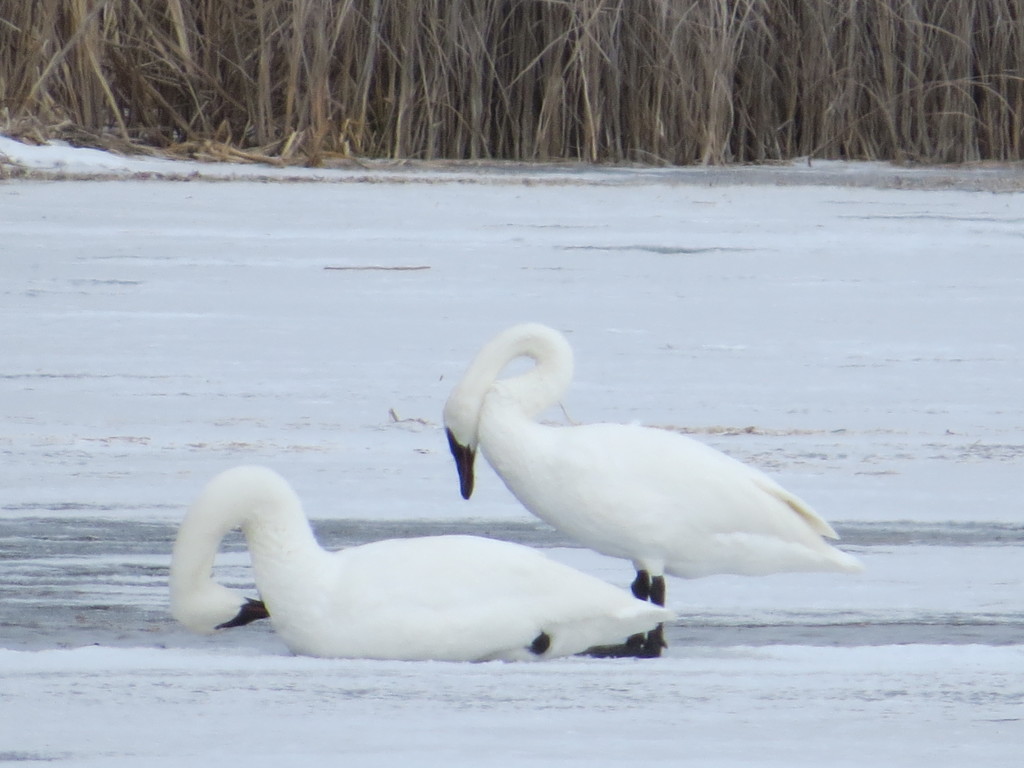
Meanwhile at the other end of the Trumpeter relationship spectrum and at the other end of the outflow, this harried set of parents was leading the distracted life of a zone defense against three rambunctious teen-age cygnets. A date night might be in order.
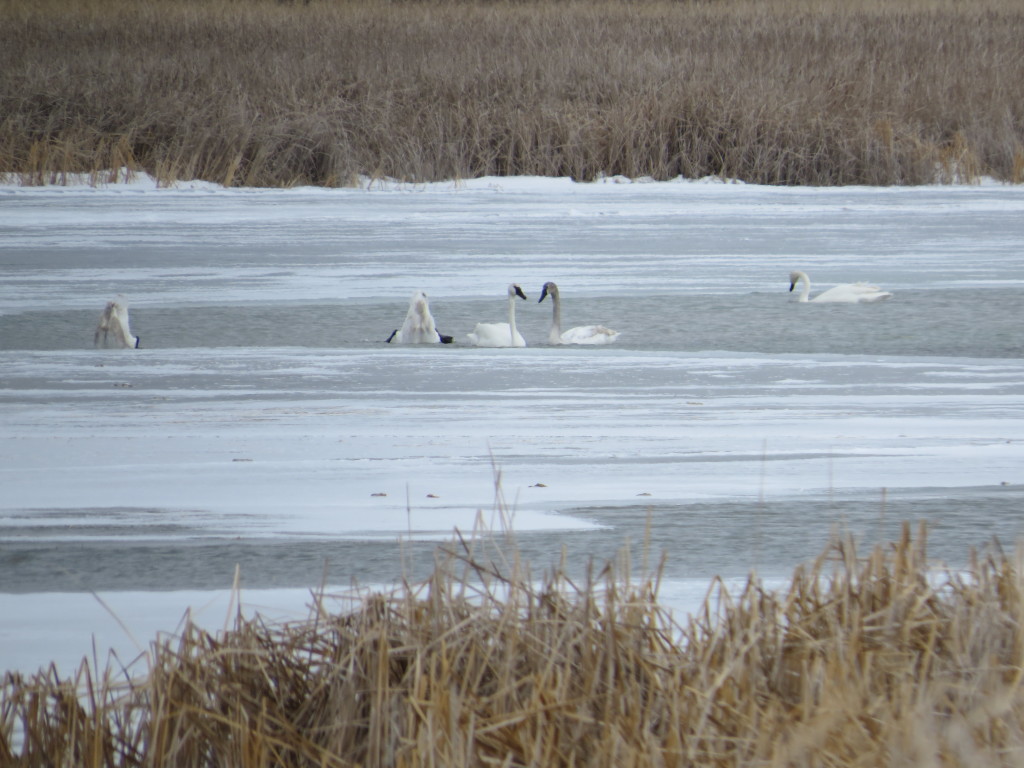
It turns out that the outflow of Green Lake is not the only open water around these parts in the winter. The Crow River right in downtown New London also stays open just beneath the dam at the Mill Pond and along Central Avenue. In late November 2014, Coralie Jacobson found herself an incredible lifer on this little stretch of river in town–an American Black Duck associating with about two dozen Mallards. This species has been something of a nemesis bird for me, and it’s a remarkable bird for our area. Occasionally one or two will be seen by somebody during spring migration or in the late fall if there is open water around. I have frozen my fingers and face scanning through thousands of Canada Geese and Mallards on Foot Lake trying to pick one out that Steve had found in late 2013. Another time I was minutes late for getting to a location of a sighting. And this particular duck that Coralie found? I think I made a half dozen trips to New London looking for this bird, hoping to finally add it to my county list and record a new Kandiyohi species for eBird. Joel found it no problem. Counters for the CBC found it no problem. I had lots of problems finding it. I had so many failed attempts and it was getting deeper and deeper into winter that I had completely given up on it, settling for licking my Black Duck wound along with the still open, festering wound of missing a county Long-tailed Duck by an hour last fall.
Last week after I dropped Evan off at school on Monday, I went for a drive-about in the northern part of the county-a land I haven’t explored much. The Black Duck was far from my mind since it was last seen two months ago. This solo venture was birding desperation, plain and simple. I didn’t even know what I was really after. A 2015 county Northern Shrike? Pileated Woodpecker year bird maybe? Perhaps a Snowy Owl even though I’ve used up all my SNOW luck for a decade? It felt hopeless and was even less interesting than it sounded. I decided to turn it into an eBird expedition, making notes of birds numbers/species/locations. It was something to do, something productive anyhow.
My travels brought me by New London, so I thought I’d swing by the Crow River on Central Avenue to see if there were any Mallards to document. I noticed that there were about 30 Mallards or so. Interesting. The ducks were located at a bend in the river that was not easily seen from the dam or from Central Avenue. After some maneuvering I finally got into a position with the morning sun at my back where I could see the ducks. The conclusion of my quick scan was Mallards-every one of them, but truthfully I wasn’t even thinking that the Black Duck was a remote possibility. It had to be gone.
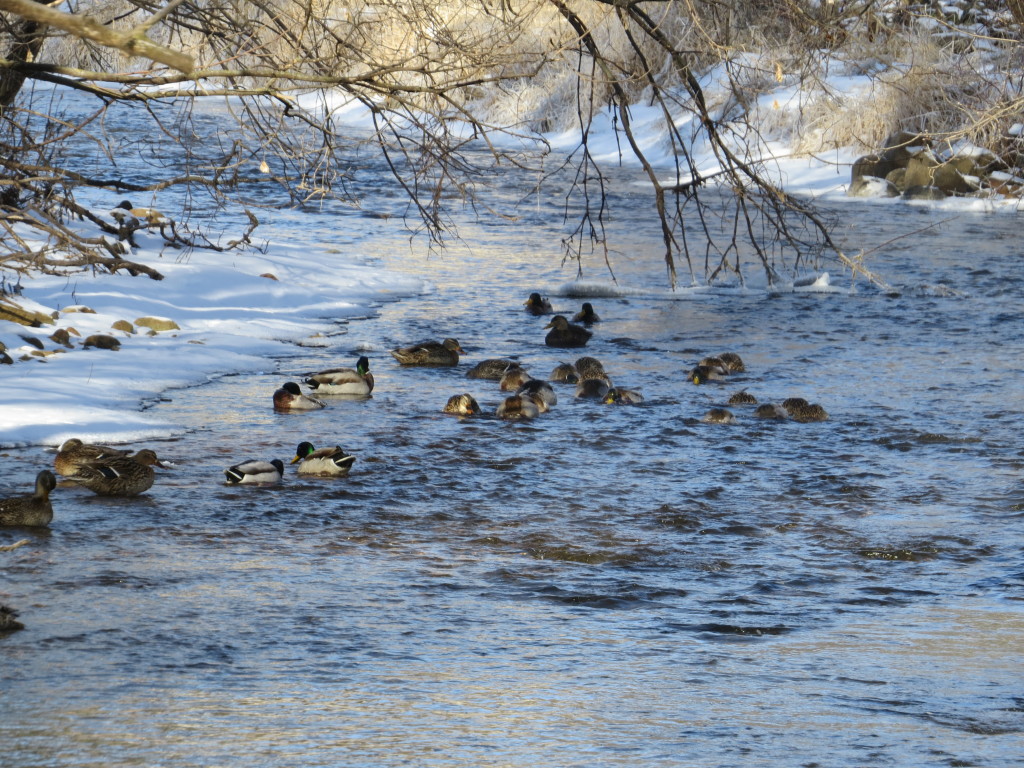
Anyhow, I decided I would glass the Mallards and try my best to get a careful count of males/females for eBird since it was a manageable number. Most ducks were facing upstream with their heads constantly under water foraging for food. It’s kind of hard to count ducks that look like rocks.
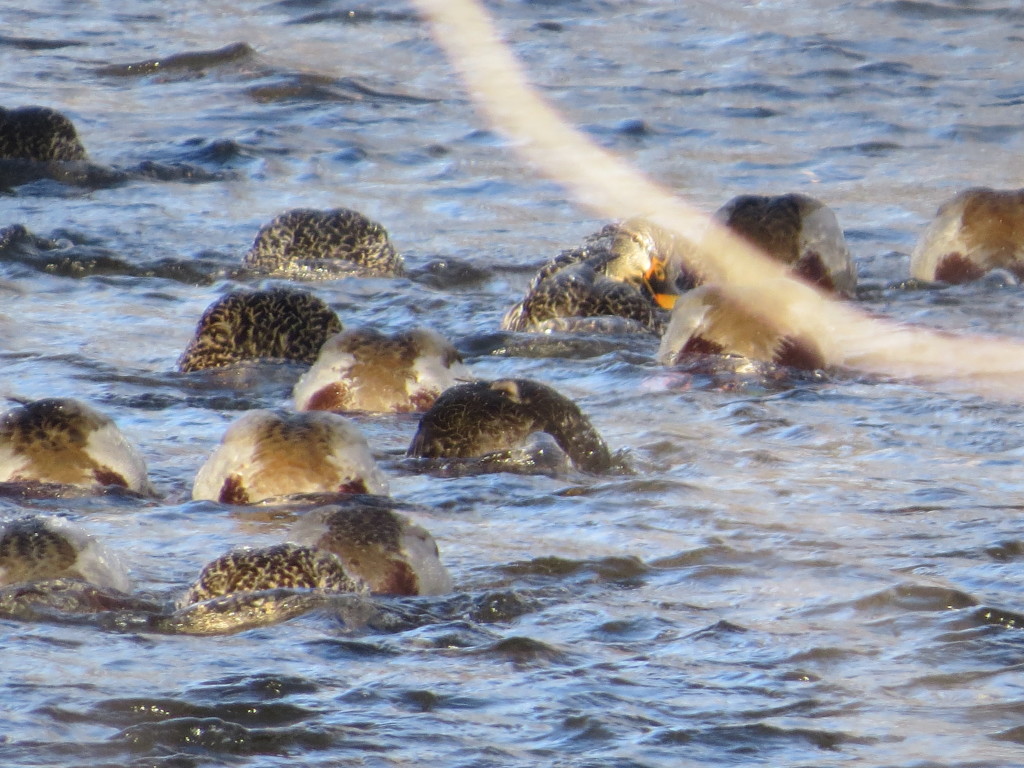
As I moved my binoculars from one bird to the next, one duck lifted its submerged head. I saw a black cap and an olive green bill, and I literally laughed out loud. There it was. Finally. Had I not eBirded, I may have been long gone not knowing the Black Duck was right under my nose. It felt SOOO good to finally see this bird here at home. It was an A+ bird for a dull winter day–even better than if I’d found a Snowy Owl. The icing on the cake was finding an overwintering Belted Kingfisher, an eBird rarity that I was unfortunately not able to photograph.
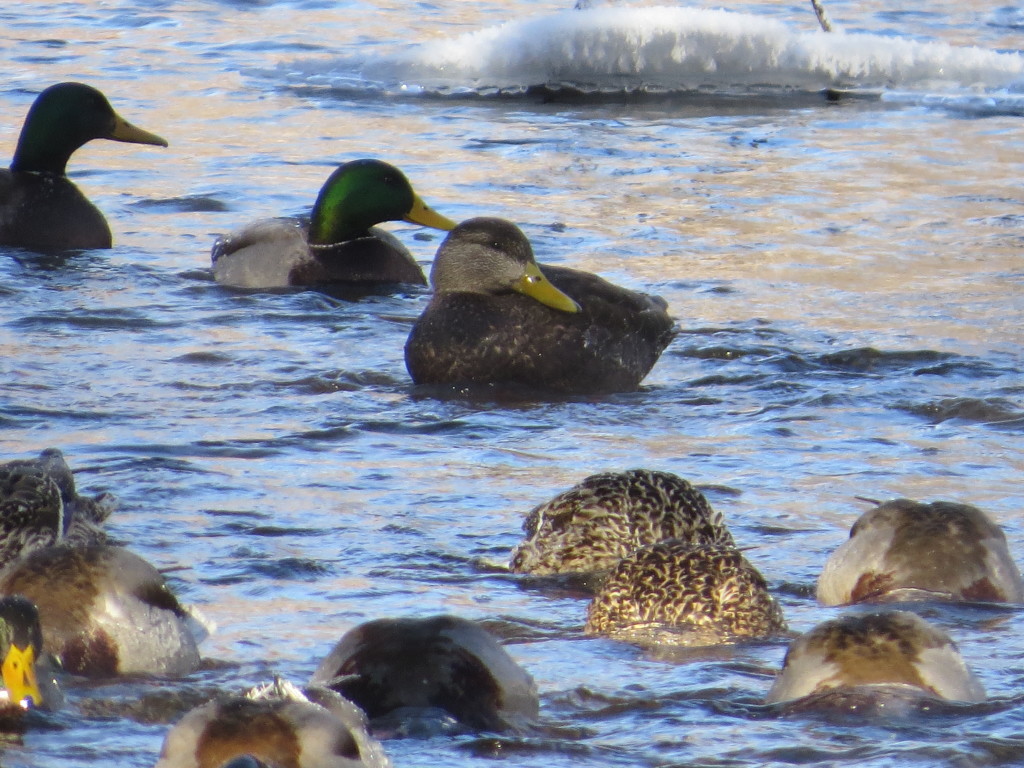
In my early birding days I had anxieties about differentiating an American Black Duck from hen Mallards. How silly.
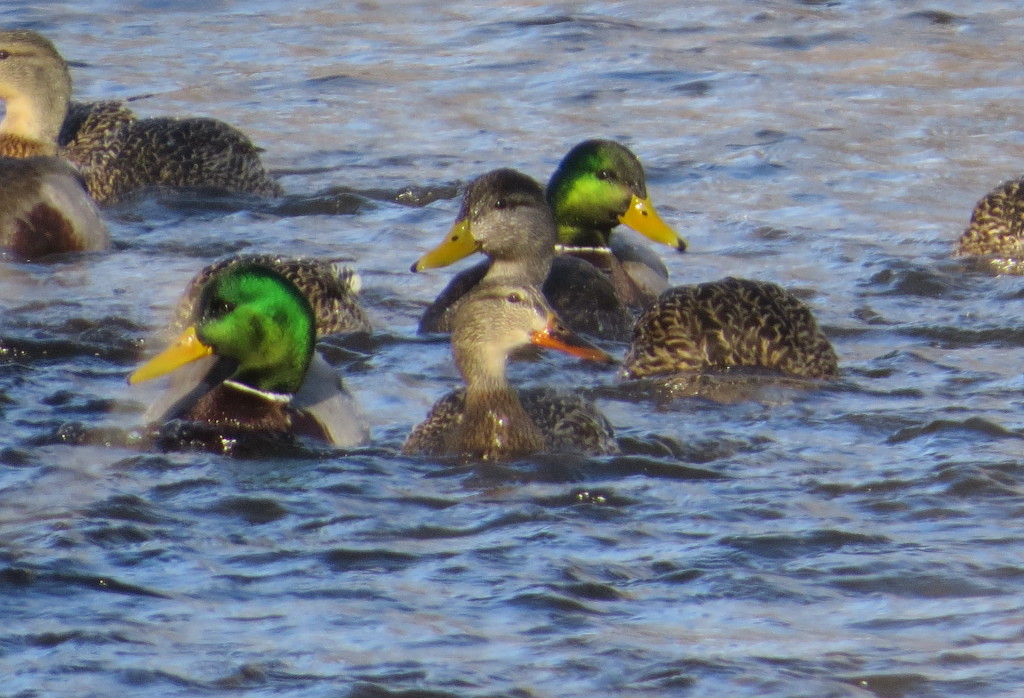
Ever wonder why they call it a Black Duck?
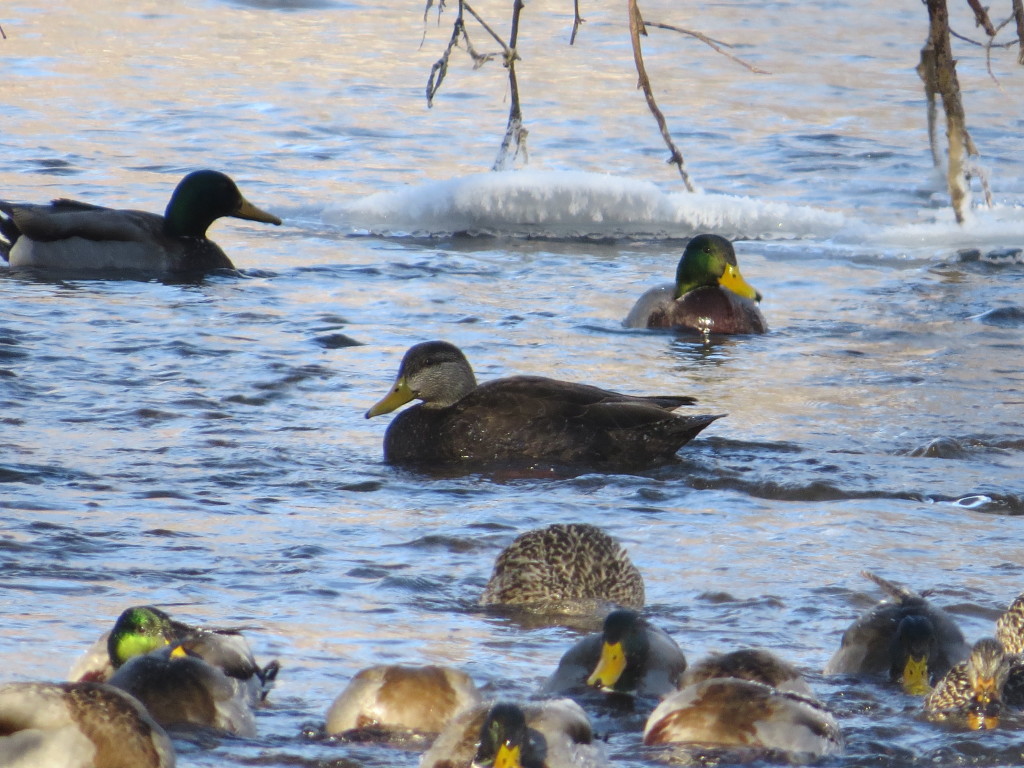
Wintefowling is tremendous fun but is not for the faint of heart, those with poor circulation or the beardless. That said, it seems that winter’s last hurrah is waning and that warm temps are on the way. Pretty soon there’ll be open water aplenty and waterfowl galore. The truth is I’m going to miss these quiet winter waterfowling days when the few, the proud ducks are concentrated in tight spots. Only the cool ones come in the winter.
By God, that eBird list for Plateau State, Nigeria is just gonna have to wait!
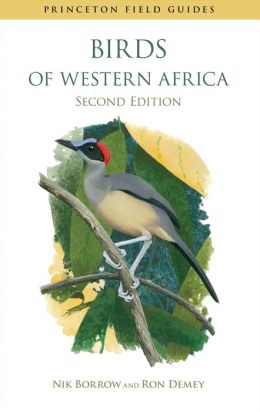 All birds, at least in the mind of a birder, are not created equal. There are birds we never get tired of seeing, often because of their rarity or beauty or both. Yet others we outright scorn and dub as “junk birds” because of how exceedingly common and drab they are. Then there are those gorgeous, out-of-reach birds we only dare to dream of seeing before our birding days are done, like the Garganey. I already had that particular dream come true, but on February 20th I witnessed something far greater. Admittedly this post has little connection to birding beyond the title and this intro, but one thing I’ve never explicitly told you readers is that one of my primary purposes in writing blog posts or writing the annual humorous Christmas letter is to capture and preserve snippets of my family’s history. Pictures of the kids, quotes of things they say, and stories of the things we do together are often included for our own remembrance as much as they are for entertainment/readership value. It is in that vein that I’m blogging today–because I want us to look back on a monumental day in our lives and remember–remember the pain and the joy. So read on if you like or stop; it does not matter to me. I will say, though, that most birders I know like being surprised by really cool phenomena, whether or not feathers are involved.
All birds, at least in the mind of a birder, are not created equal. There are birds we never get tired of seeing, often because of their rarity or beauty or both. Yet others we outright scorn and dub as “junk birds” because of how exceedingly common and drab they are. Then there are those gorgeous, out-of-reach birds we only dare to dream of seeing before our birding days are done, like the Garganey. I already had that particular dream come true, but on February 20th I witnessed something far greater. Admittedly this post has little connection to birding beyond the title and this intro, but one thing I’ve never explicitly told you readers is that one of my primary purposes in writing blog posts or writing the annual humorous Christmas letter is to capture and preserve snippets of my family’s history. Pictures of the kids, quotes of things they say, and stories of the things we do together are often included for our own remembrance as much as they are for entertainment/readership value. It is in that vein that I’m blogging today–because I want us to look back on a monumental day in our lives and remember–remember the pain and the joy. So read on if you like or stop; it does not matter to me. I will say, though, that most birders I know like being surprised by really cool phenomena, whether or not feathers are involved.
5:30 AM, Friday, February 20th
When my alarm went off announcing the beginning of another work day, I quickly woke and checked my phone for any birding updates that may have trickled in during the night. After all, a Gyrfalcon and Harlequin Ducks had been in play and as of the previous evening, I was contemplating a fast trip north after work. What I saw on my phone, though, horrified me–a missed call from my mom at 4:50 AM. Immediately I thought something must have happened with Dad. With quicker heartbeats, Melissa and I nervously listened to the voicemail. My mom was indeed distraught and sobbing, but it was not about my dad. Mom told us how our brother-in-law, Bayo (pronounced “Bio”), who is a missionary in Nigeria, had been very sick recently and that he had been taken to the hospital where doctors concluded he either had cerebral malaria or meningitis. I didn’t know much about those diseases, but I knew enough to know that most people don’t come back from their rapid, deteriorating effects. Melissa and I said a quick prayer, but in my mind Bayo was already dead. Adrenaline, fear, sadness, and morning grogginess were creating a toxic mix in my mind. Selfish thoughts and fears of having to travel to a country that is often plagued with religious violence and terrorism were my instant companions. I had to clear my head before I called mom back. I showered, let the dogs out, and got in the first sips of coffee. Then I called my mom in Arizona, but there wasn’t much to say on either end, just mutual sadness.
I sent out a request on Facebook for our small group members to pray. Then with heavy hearts Melissa and I continued with our day of getting kids to school and going to work. Distracted and distraught, we kept waiting for updates. At 7:40 mom emailed that it was bacterial meningitis (something we later found out was incorrect information). I busied myself at work with any menial task I could find before students arrived–cleaning whiteboards, straightening desks, etc. My first hour students were taking a test, so I just sat at my desk numb, checking for updates. After what felt like an eternity, the hour was over and I was now in my prep hour. At the urging of my mom, I called my sister, Mary Beth. In all my years of knowing her, Mary Beth has been an unshakable rock, a stoic eldest sibling who has endured countless losses to AIDS and other tragedies. Now as I listened to her, I was shaken to hear her utterly broken and scared: “His eyes are open but he doesn’t see me! He doesn’t see me!” It was at this point that I lost it too–something that was still somewhat abstract from half-way around the world suddenly became very real in hearing my sister’s voice. Only long after the fact did I learn just how horrifying the details of his rapid demise were. Mary Beth witnessed his neck snap back 90 degrees as he went into convulsions and foamed at the mouth. His eyes bugged out and his chest heaved rapidly to try to get breath, like a ‘wild, drowning man’ she later recalled. My conversation with Mary Beth that morning was very short, but several times she pleaded, “Just pray, okay?”

I felt it was over for Bayo. I didn’t think praying would do any good. Yet because she asked me, I prayed–angrily and full of doubt. At this point I wasn’t concerned with what would happen to their ministry, and I knew Mary Beth would eventually be okay; I was mostly upset that my nephews and niece were about to lose their dad. Never mind my own feelings of loss. But along with hundreds of people from every corner of the globe who knew about Bayo’s ordeal through social media, I prayed.

The rest of the morning was a blur. I’m sure I wasn’t much more than an overpaid babysitter in the classroom. I wasn’t thinking of a recovery–far from it. I was trying to remember where my safety deposit box key was so I could retrieve my passport. I was trying to figure out how I could possibly make a trip work. My mind was a mess. One minute I felt like dumping this silly birding and blogging hobby completely; the next I was debating how acceptable or not it would be to look at birds if I did end up in Africa.
It was strange to not be able to talk with Melissa who was at the other end of the building, also keeping up the charade of teaching on this day. We exchanged short, sad emails, but that was it. We did see each other during the morning’s Snow Week activity, but not a word was uttered about it even though we both knew what thought prevailed on each other’s minds.
At 12:15 I got a text update from mom: “He has viral encephalitis. He needs a miracle.” Dear God, it really is over, I thought.
Mary Beth later said the doctors believed that was the right diagnosis but that they didn’t have the medicine for that disease, possibly in all of Nigeria. She recalled one doctor saying, “We have cast our bread upon the water. We have given him an anti-viral medication, an anti-bacterial medication, and even an anti-fungal medication.” In other words, they had done all they could do.
It was now a waiting game. I went through my afternoon in a continued fog, struggling to get through my day as I waited for that final update. Around 2:00 I called my mom, and she informed me that they were working to get Bayo medically-evacuated to South Africa or Kenya. Wait, what was going on? Wasn’t it hopeless just a couple hours ago? I heard nothing further, so I called mom again around 4:00 on my way home from work. She told me that she and my dad had now made the decision to travel to Nigeria. Still there wasn’t much news about Bayo. That final update wasn’t coming.
Around 5:30 I texted my sister giving her our support. We now had our family of four together and had decided to eat at our favorite pizza place. Like our hearts, the kitchen at home was also a mess from Pinewood Derby construction the previous night. Needless to say, we didn’t feel like cooking. As is often the case, this non-chain restaurant was extremely quiet as most customers opt for delivery and carry-out. While we ate, my sister responded to my text: “Thanks. Keep praying! He’s still in a rough spot.”
Little did we know at the time just how symbolic the quiet restaurant and gentle snowfall outside really were (I even remarked about the snowfall being peaceful-something it rarely is on the wind-swept prairie and something I never say). On our way home I got another text from Mary Beth that Bayo’s breathing, pulse, and temp were stabilizing! His temp had dropped from 104 to 98.6! The doctor was shocked.
Unlike the confusion and chaos of the beginning of the day, the night was now calm and quiet and was going out with a whimper. The negative updates and negative outlooks had disappeared; hope was winning! Bayo continued to stabilize, and by the next day he was alert and talking, and his personality was coming through! His kids got to see him, and he recognized all of them. There appeared to be no brain damage or loss of cognitive function, later proved by a completely normal EEG. Bayo was eventually still evacuated to Nairobi, Kenya where he continued to improve greatly each day while the doctors tried to determine the cause of his ailment and monitor his rapid, seemingly complete recovery. Bayo is alive! I still can hardly believe it. We witnessed a miracle, and Mary Beth (and all of us) attribute it to the power of prayer.
So, I don’t know if or when I’ll ever see African birds, and I couldn’t be happier. Meanwhile, though, I’ll be studying. The good folks at Princeton University Press are sending out a review copy of A Guide to the Birds of Western Africa. Stay tuned for that as well as some great birding that’s happened since my last post.
2014 – The Biggest Year I Never Dared to Dream
What’s this, you say? A re-cap of 2014’s birds halfway through February? Right now heads are shaking as they contemplate my foolishly late posting. Well, to the detractors, I say the timing couldn’t be more right. For you see, I did not rush to compile a “Top Ten” list in the waning hours of 2014 when the pressure of an artificial deadline might cause errors in judgement. No, these ideas have been marinating and brewing for the most authentic and satisfying post possible. Actually, the reality is that the birding has finally just flat-lined here in February and all this extra time has allowed me to steal a lot of cool ideas from those who have posted before me.
2014 was a monumental year–a year that will, in all probability, never, ever be matched again. I do not anticipate doing future “Best of” posts, but I would be remiss if I did not commemorate the year that gave so much and so freely. Though the word often loses its meaning in today’s vernacular, no other word is more qualified to describe 2014 than “epic.” Evan and I began the year with a hefty-number of life birds, 200+. So how many new birds could a person reasonably expect to add in a new year at this stage in our birder development? 30? 40? 50? No, we blew those figures out of the water. I lifered 96 times and Evan 74. Yes, we traveled out of state a couple times, but most of those life birds were found right here at home in the great state of Minnesota. The numbers don’t tell the half of it. The actual birds included in those numbers are beyond anything I could have dreamed for us. The stories of the finds, the chases, the hunts are dripping with adrenaline. In fact, it was only just recently that my resting heart rate dropped below 120 BPM.
We’ll get to all that excitement in a bit, but first one must be grounded and look at the ugly side of birding.
Worst Birding Experiences of 2014
Far and away, this award goes to the Least Tern chase to Luverne. I suckered the kids into going on an overnight camping trip with me to Blue Mounds State Park to see this bird. My wife suckered me into taking along my dog. Now I’ve been to Blue Mounds before, so I promised the kids a great place to swim and a really cool city park in Luverne. Long story short is that the drinking water at the park had e. Coli, the swimming reservoir was drained from a broken damn to due heavy spring flooding, and that beautiful city park was completely destroyed in that same flooding. Not only did I have disappointed children and an overcrowded tent with two kids and a lab, but an overnight rain and lighting storm caused us to take shelter in the van at 4 AM and try to get some sleep. The next day I was desperate to replace two balding tires before our return trip. I found a dealership to do the job, and my plan was to take a walk around town with the kids and dog while it was being done. Unfortunately a downpour caused the three of us and the dog to take shelter in the one-car showroom while we watched Sponge Bob on a 6 in. TV and waited for our car. Oh, and that Least Tern we were after? Missed it by 15 minutes. Not even all the Common Nighthawks, Blue Grosbeaks, and Red-headed Woodpeckers we saw could salvage this trip.
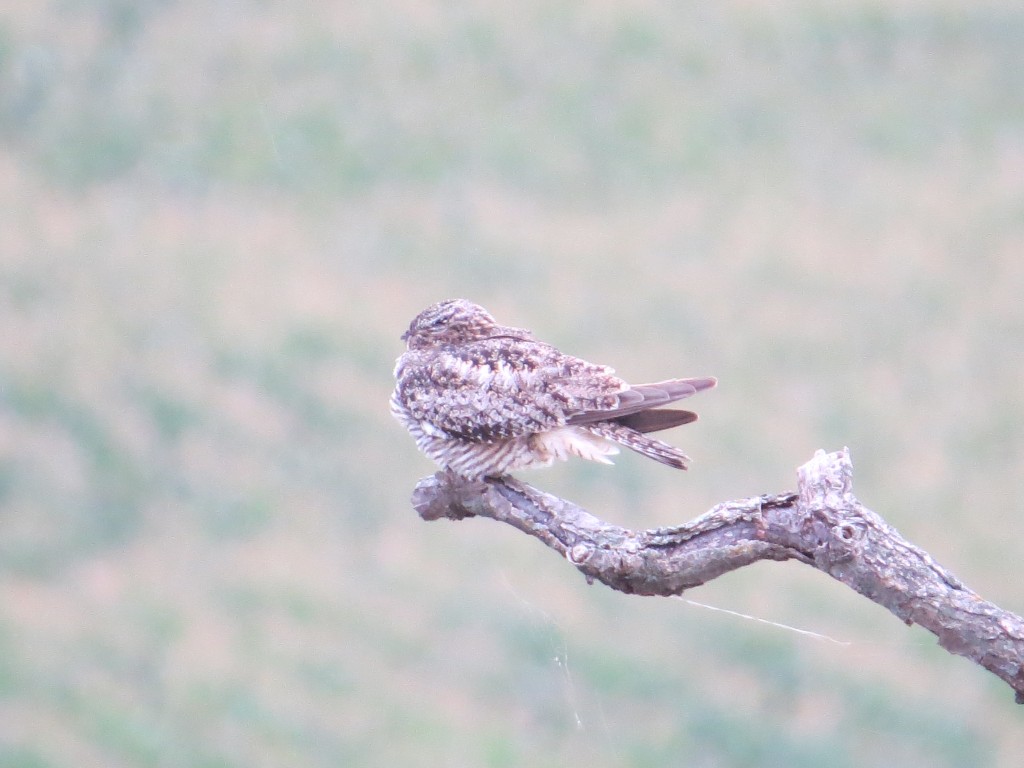
2014 also saw a few engagements with local law enforcement in the name of birding, mostly for the perfectly acceptable birding reason of speeding to get to a bird. However, one low point was getting “stopped” at the Pennock sewage ponds. I distinctly remember being shocked to see flashing red lights in my rearview while driving a dirt path around the ponds and then watching as the officer nervously approached my van from behind with his hand on his holstered gun. Even after I explained I was just birding, he ran my license, checked my insurance, etc. And when I thought it was all over? He stayed to watch me watch birds. Not enjoying the company, I left…and discovered a back-up squad car with two more officers on the other side of the pond! I guess a dirty mini-van at a rural sewage pond does seem a bit shady. But on an unrelated note, how about them nice treads on those tires?!

Thankfully I didn’t end up tased or have my accompanying daughter placed in child-protective services so that we could go on to better days ahead.
Best Birding Experiences of 2014
2014 saw plenty of travel and with it, plenty of great birding. Last March we made our first annual trip to Maricopa, Arizona to visit my snowbird parents. The trip allowed us to pad the life lists with a couple dozen lifers and meet up with Phoenix birder/blogger Laurence Butler for some memorable Sonoran Desert birding. In July we took a road-trip to Colorado to visit my Aunt Carol and Uncle Jon. Birding the Badlands of SD and the Wet Mountains of Colorado pushed the life list even higher by about another 20 birds. Not only did we go cross-country this year, but I went on several chases across the state with local birding friends Randy Frederickson and Steve Gardner and met many friendly MN birders at the stake-outs of the rarity after rarity. 2014 was ripe with such birds. I think Randy added a half dozen state birds; usually he’ll get one every couple of years or so.
As fun as all the traveling was and all the great birding it brought, the best birding experience occurred in August when I had to attend a training in St. Paul for work. This afforded me the opportunity to bring along my family for a mini-getaway. It also afforded me the opportunity to check out an extremely accommodating and wildly popular Least Bittern at Wood Lake Nature Center. It took a little bit of effort on the part of some other birders to help us all see this cool bird just 6 feet away from the boardwalk on which we were standing.
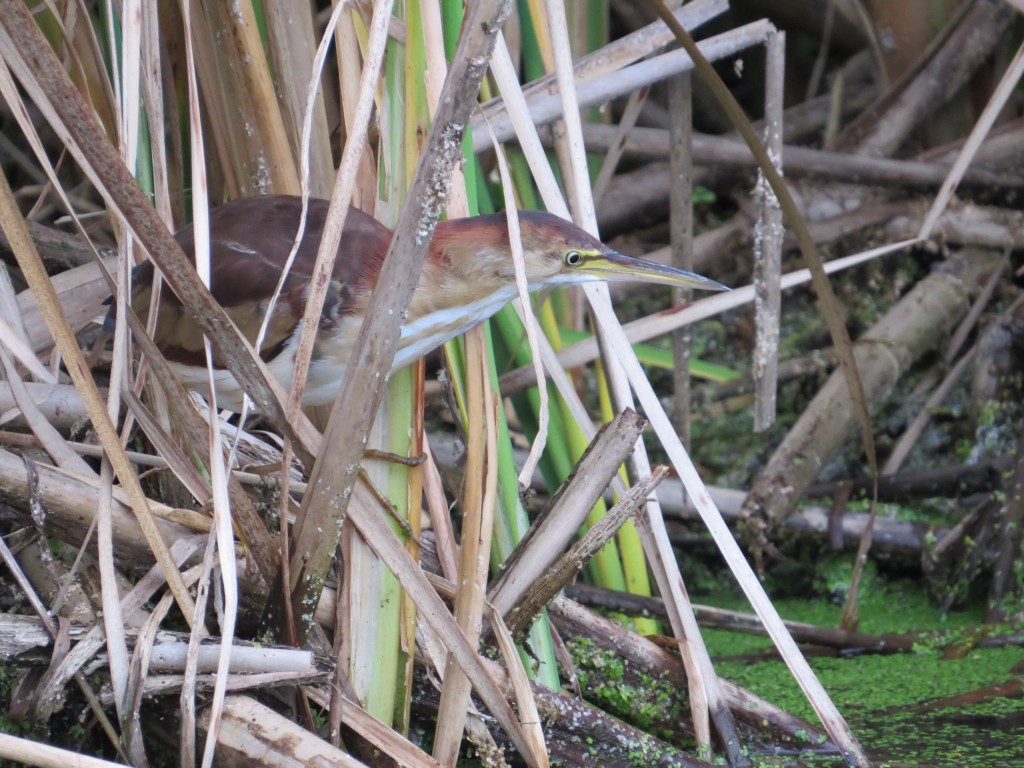 And one of the birders who helped us find this bird was none other than Stan Tekiela!
And one of the birders who helped us find this bird was none other than Stan Tekiela!
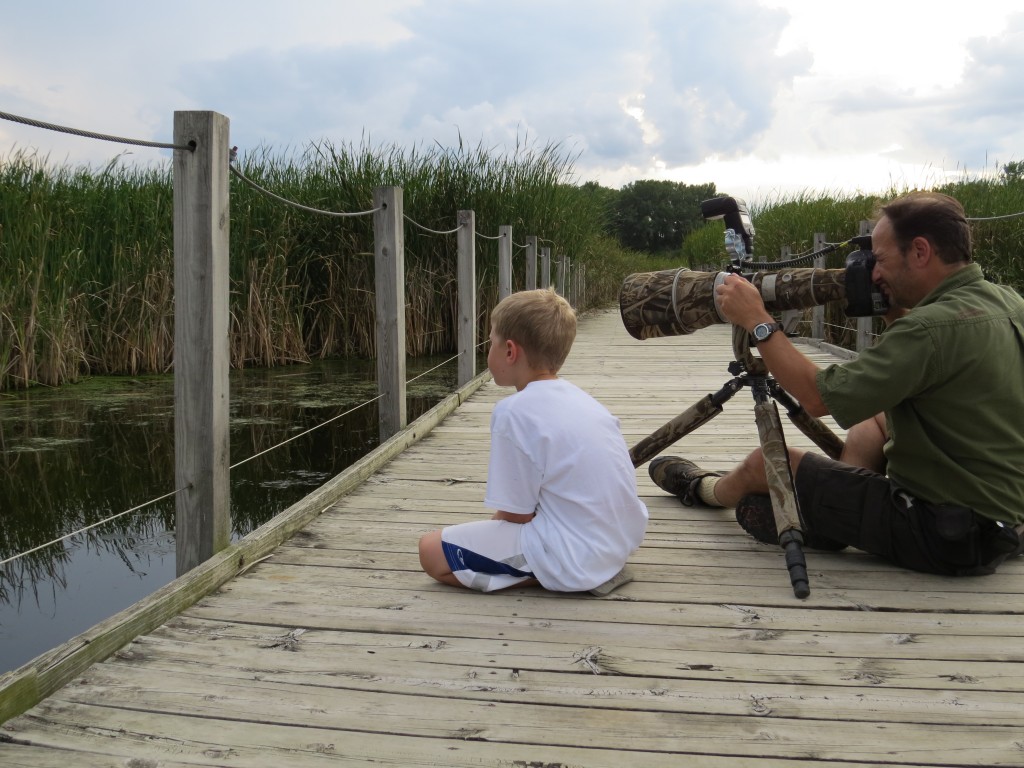
It was a joy to watch Evan as he was really digging this lifer, just watching it and watching it. The whole family was having fun watching this Bittern and the other wildlife. And Stan turned out to be an incredibly nice guy engaging Evan in a conversation about Bitterns and excitedly calling us back to look at a Raccoon. Evan had no idea who he was talking to at the moment. His eyes got to be the size of dinner plates when I told him later on. It was a memorable experience like none other.
Rarest Personal Finds of 2014
You can imagine how hard it was for me to make a Top-10 in a year with nearly a hundred life birds. I struggled to whittle down the list. So here is a tribute to some really cool (I mean REALLY cool) finds I had this last year. All these birds were previously undiscovered by others. You might consider it cheating as I’m extending my Top 10 by including these birds, but remember that 2014 was epic. I posted to the listserv so much that people either love me or loathe me. My luck was enough for a lifetime of birding. I’m still pinching myself. These birds are ordered from least rare to most rare and surprisingly none made the final cut for Top 10. Any bird marked with an * means that it had the bonus distinction of also being a lifer at the moment of discovery.
7. Eastern Towhee – Kandiyohi County – an Occasional bird for the county and a solid find for a county that mostly consists of prairie and fields.
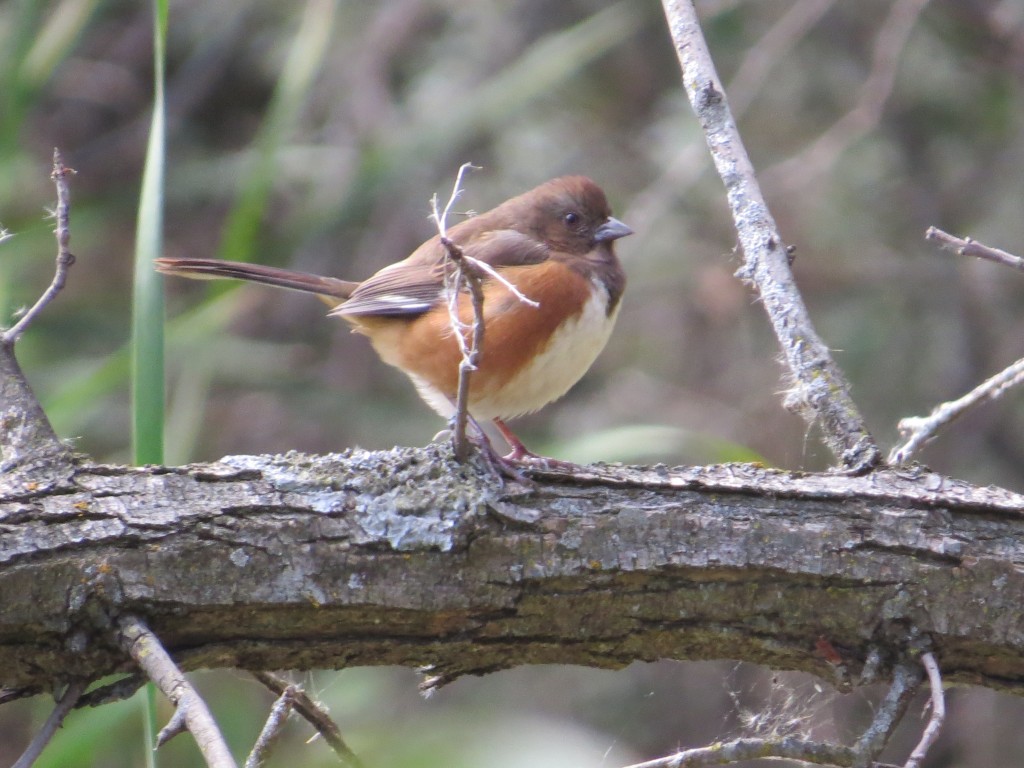
6. Western Kingbird* – Kandiyohi County – also Occasional. This was just a plain ol’ feel good find, an East meets West kind of bird.
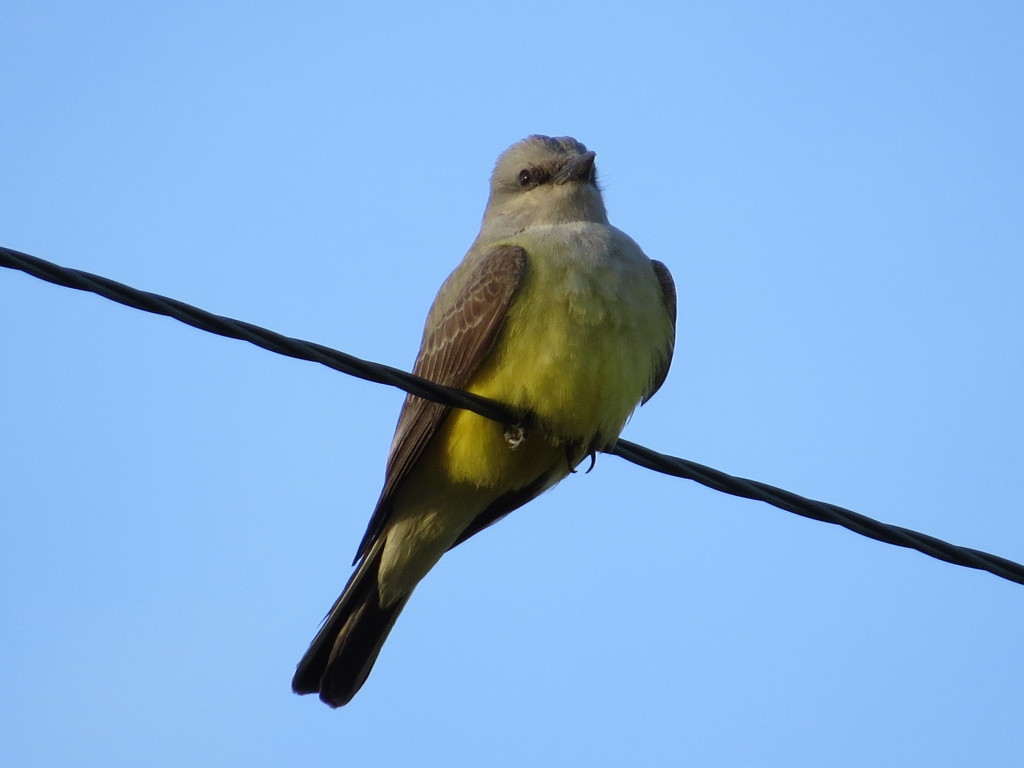
5. Swainson’s Hawk – Kandiyohi County – Occasional. Ditto above.
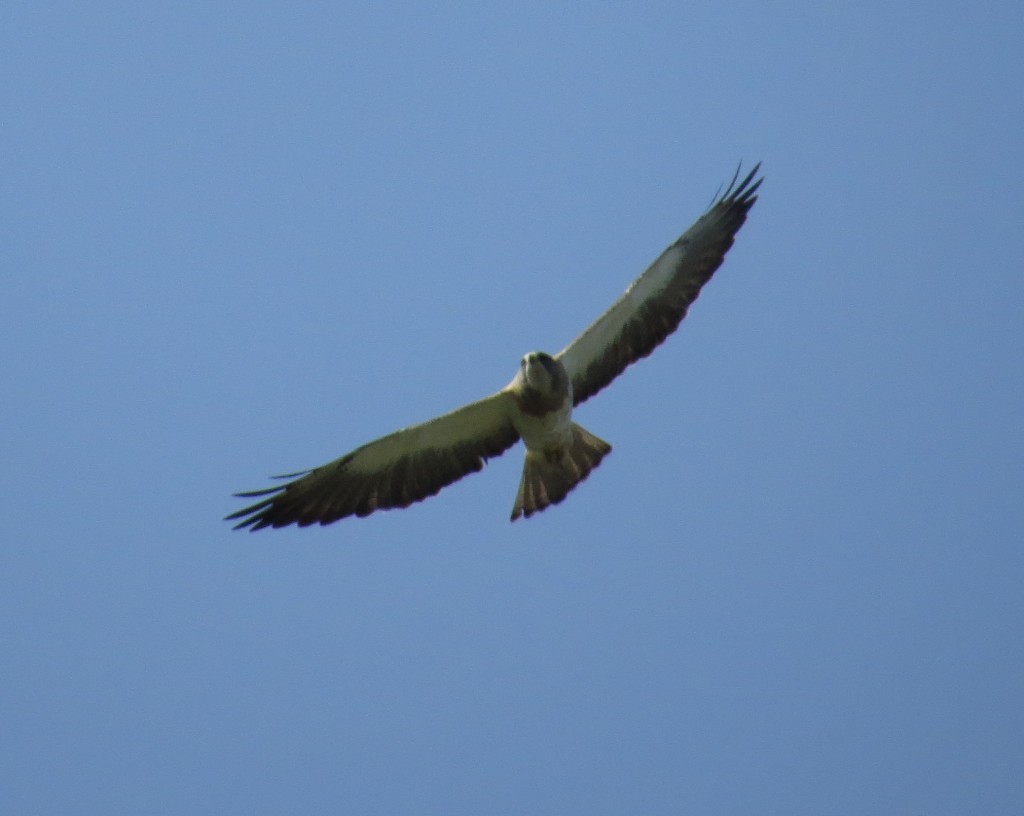
4. White-winged Scoter – Kandiyohi County – Occasional. I went Snowy Owling and got a Scoter hunch when I drove by Green Lake. I had the good fortune of that hunch being right. This Scoter brought in dozens of birders, some just getting a county tick, but many others getting the more important life tick. And in a Patagonia Picnic Table-Effect of sorts, one of those county listers also turned up a Long-tailed Duck when viewing this White-winged Scoter and yet another found a Snowy Owl! I missed the former by an hour and drove right by the latter. The agony of defeat still burns, but hey, it’s good the home county gained an even greater birding reputation.
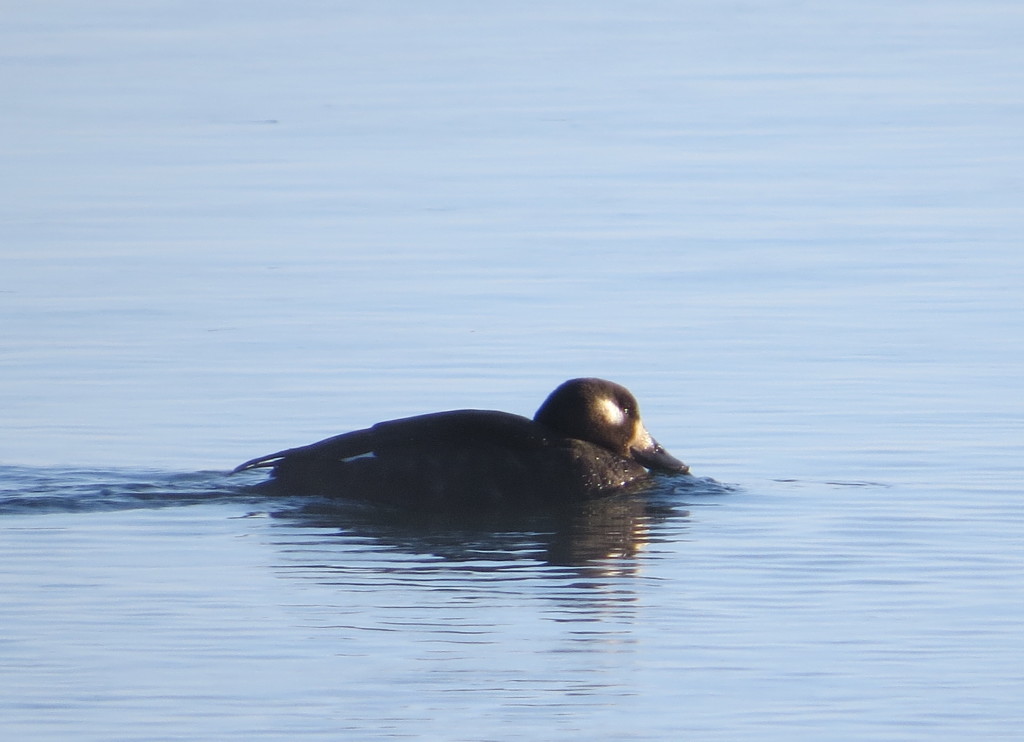
3. Mute Swan* – Renville County – First MOU official record for Renville County. I dismissed it in my peripheral vision as a pelican or Trumpeter Swan. I only gave it a look after my wife asked what it was. Wow, I should listen to her more often. BTW, not a bad bird for a trip to see the accountant is it?
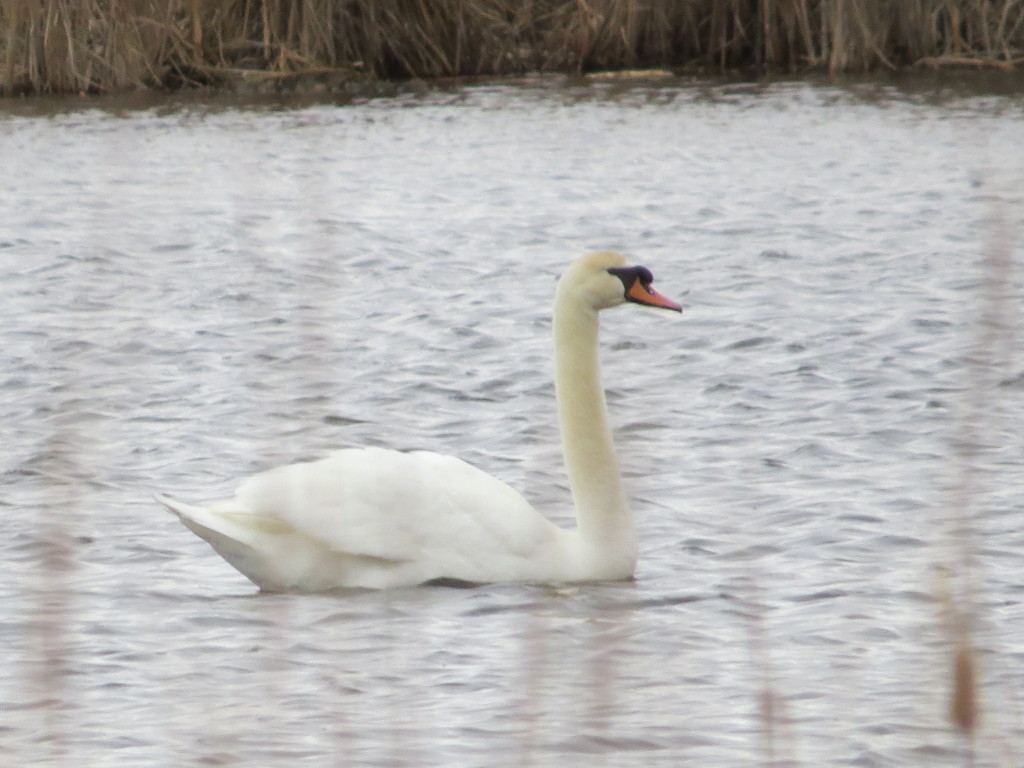
2. Spotted Towhee* – Kandiyohi County – Considered a Rare Regular for the state, showing up once or twice annually. It has been seen in the county before, but this one was the first official MOU record for Kandiyohi County. This one really got the blood pumping when I found it.
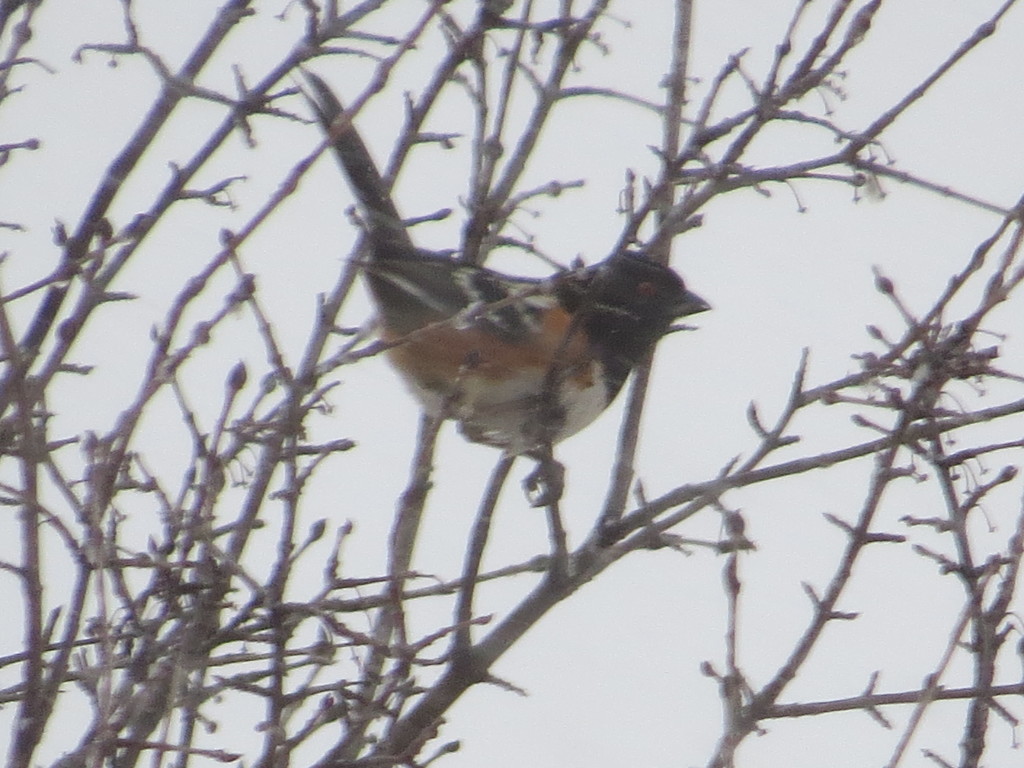
1. Lesser Black-backed Gull* – Kandiyohi County – Also a Rare Regular for the state but this one was the first official MOU record for Kandiyohi County. Unlike the Spotted Towhee, though, not even the Kandiyohi birding greats of Randy Frederickson, Ron Erpelding, and Joel Schmidt have seen this gull here at home. Unfortunately, it didn’t hang on for anybody else.

Biggest Upsets for not making the Top 10
Again, more Top 10 stretching. Any of the aforementioned birds could have easily made Top 10, but there are even more phenomenal birds that missed the top honors that are listed below. Seriously, you have to wonder what’s in the Top 10 if these birds didn’t make the cut.
10. Harlequin Duck – If only you’d been mature, little drake, you’d be right near the top!
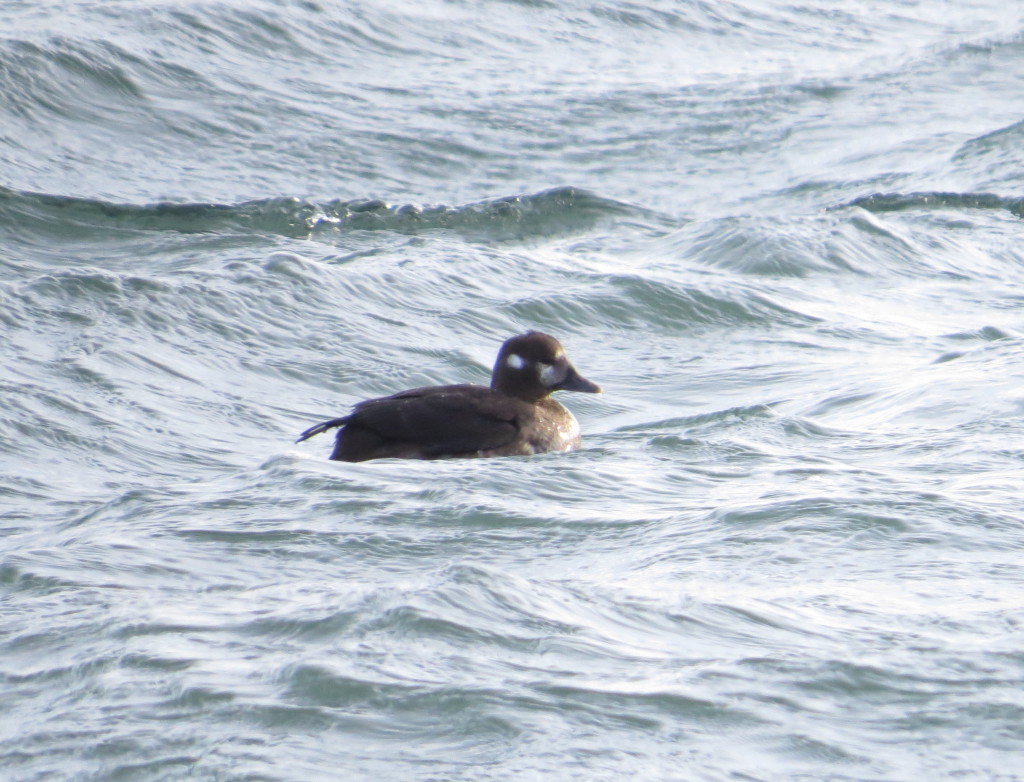
9. Eastern Screech Owl – How does an owl lifer miss the top spots? Maybe if it had opened its eyes or been a red-phase… Regardless, here’s a shout-out and thanks to Tony Lau for sharing his yard bird!
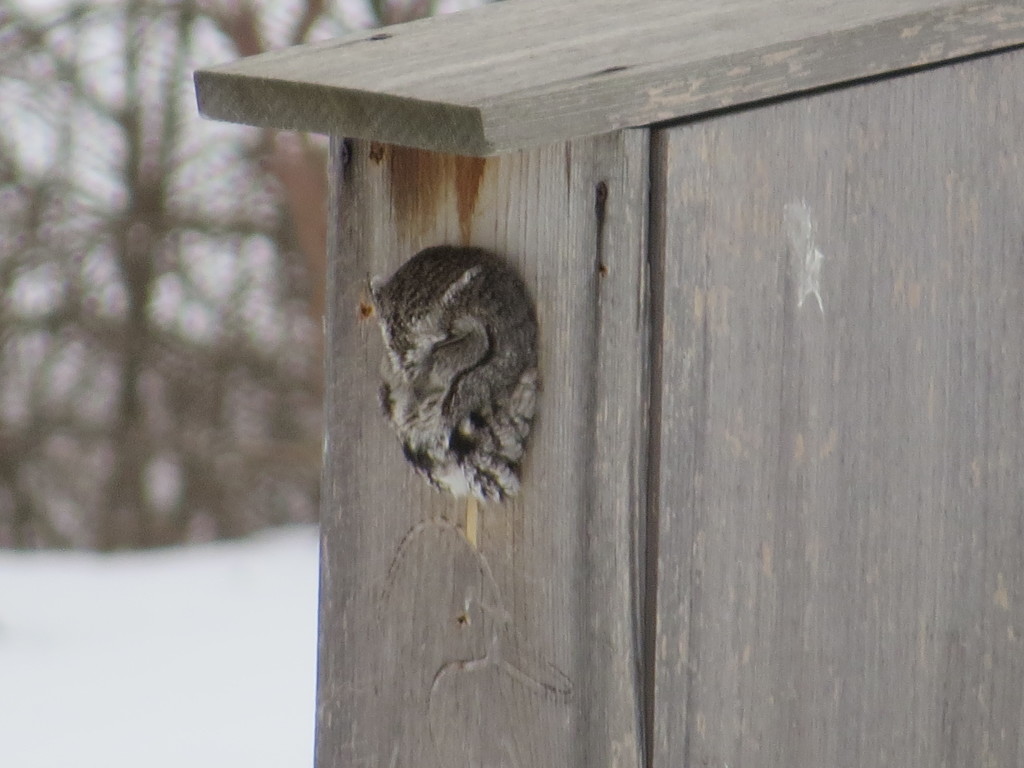
8. Prothonotary Warbler – A great, great warbler for MN and quite the looker too!
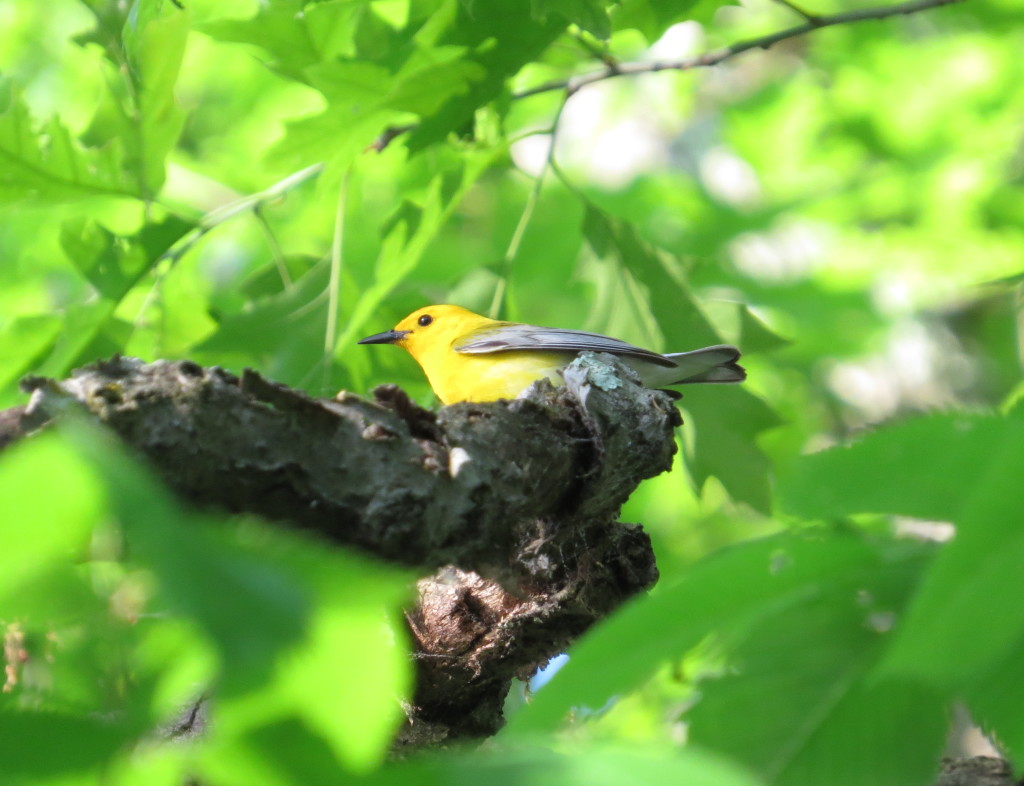
7. Hooded Warbler – This warbler nests in extremely small numbers in certain parts of the Twin Cities metro area. I made a special trip just to look for it, and I saw three in one day.
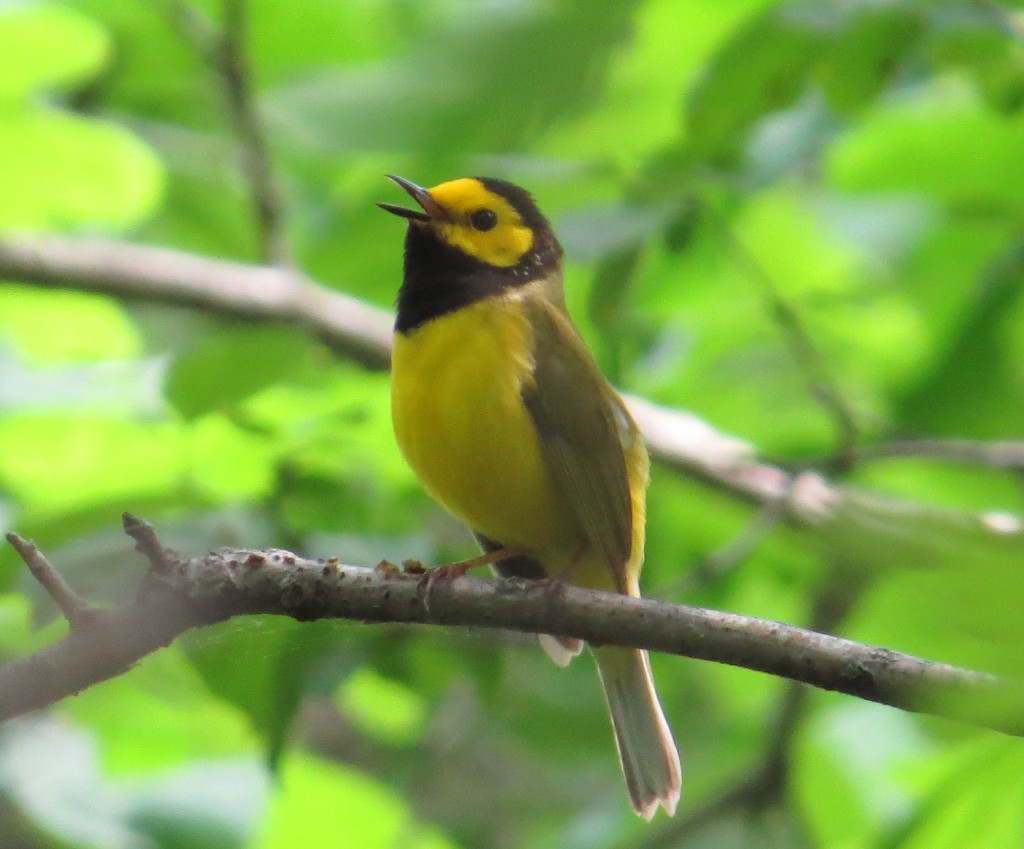
6. Greater Prairie Chicken – Crazy, right? This was a bonus find when hunting for one of the top birds.
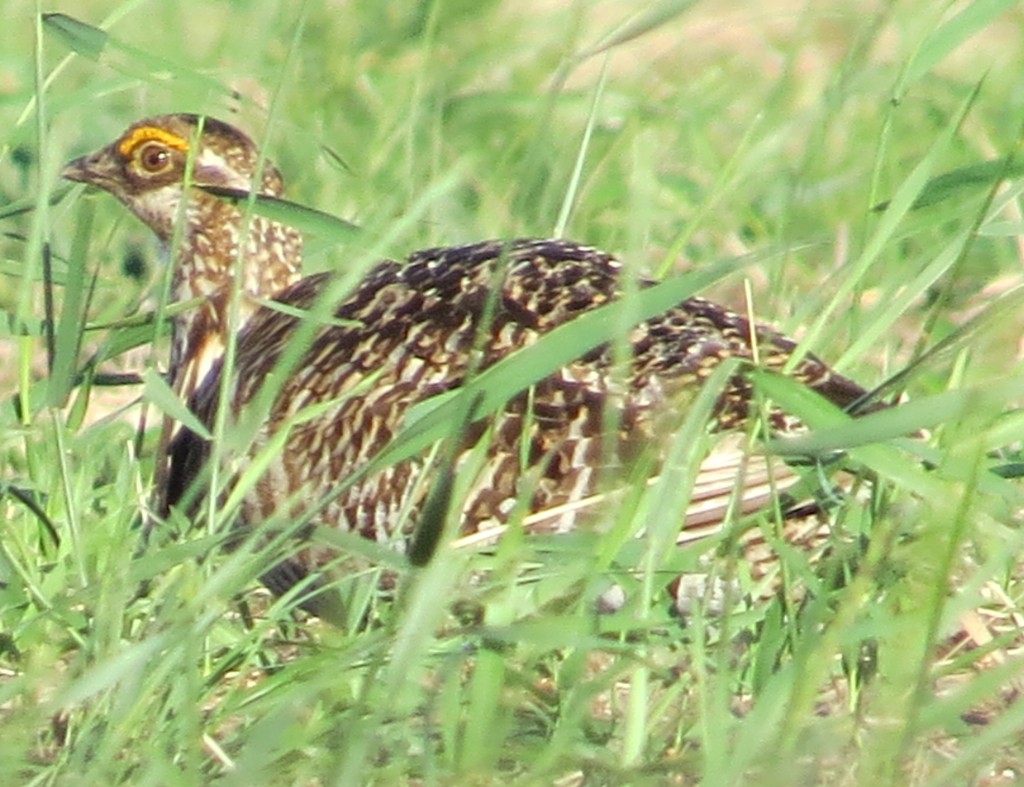
5. Vermilion Flycatcher – Gorgeous, gorgeous bird and Target #2 for the AZ trip. Again, crazy.
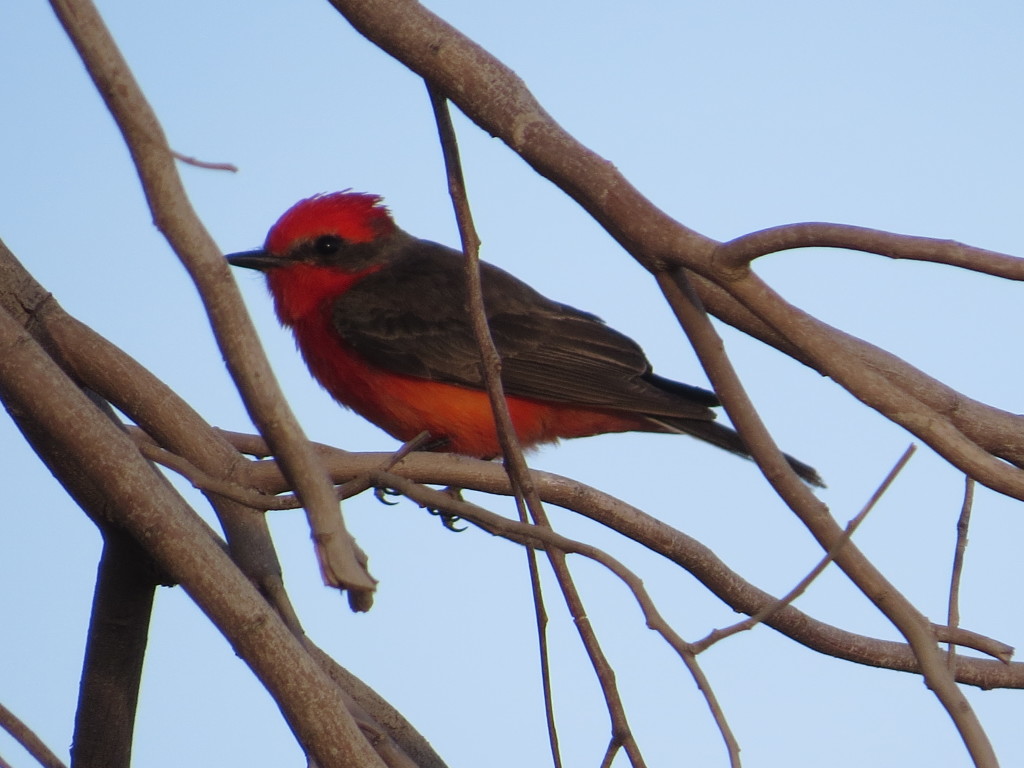
4. Varied Thrush – Any other year it’d probably be in the Top 10, but not even bonus points for showing up right here at home was enough to get it in the top tier.
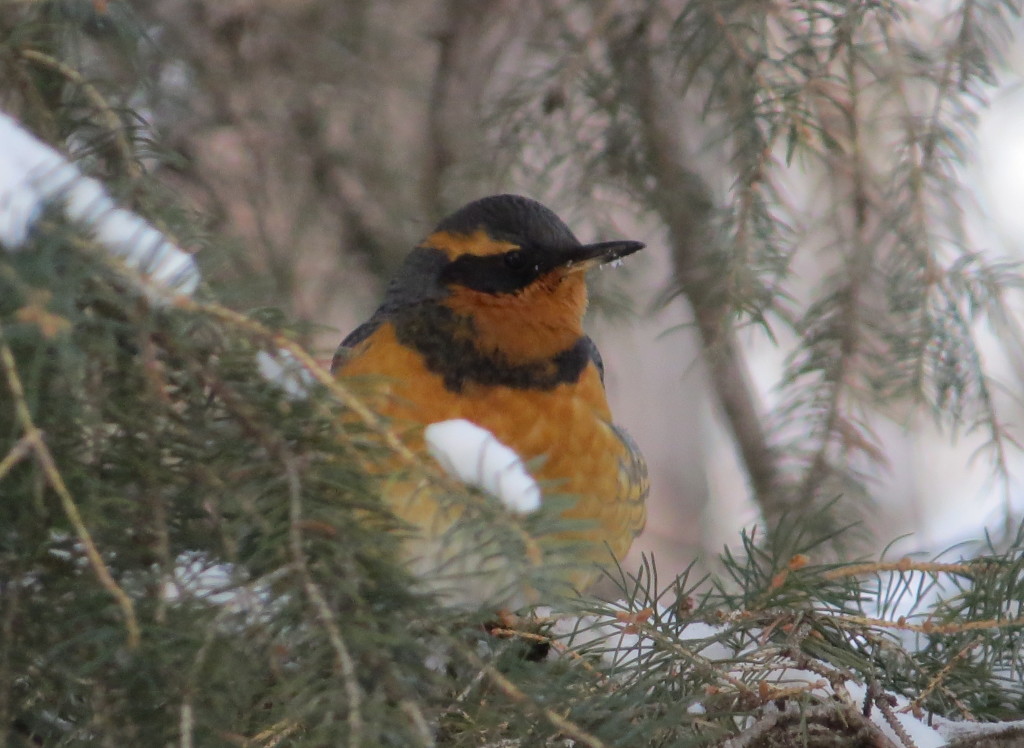
3. Eurasian Wigeon – Casual in Minnesota. I saw one. Kinda.
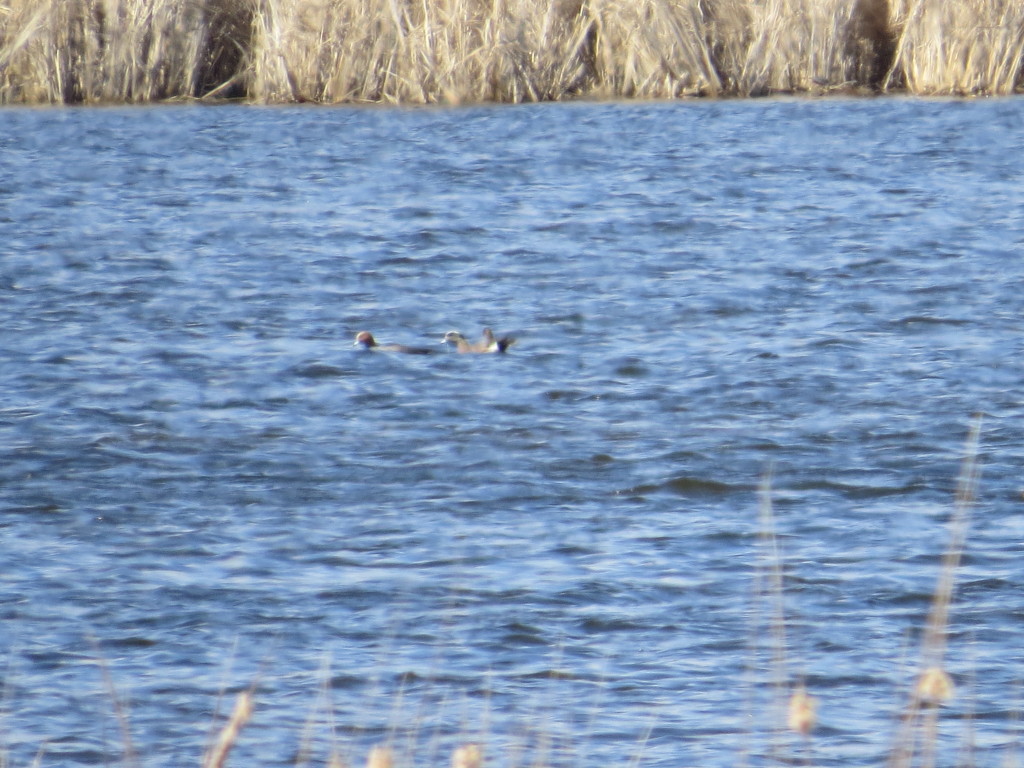
2. Common Eider – Not even making its first reappearance on MN waters since the 1960s could land this duck in the Top 10.
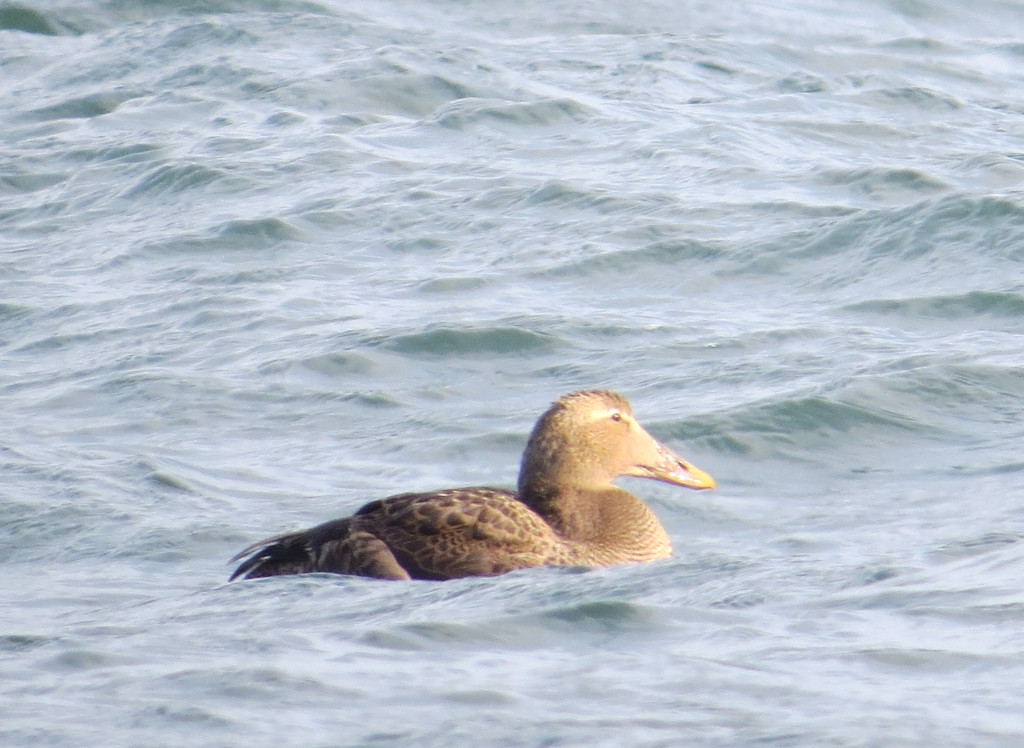
1. Wood Stork – Minnesota’s second state record. Its rarity is the only reason it’s in this list. Since this bird is ugly, here is a more fun picture of people enjoying that ugly.
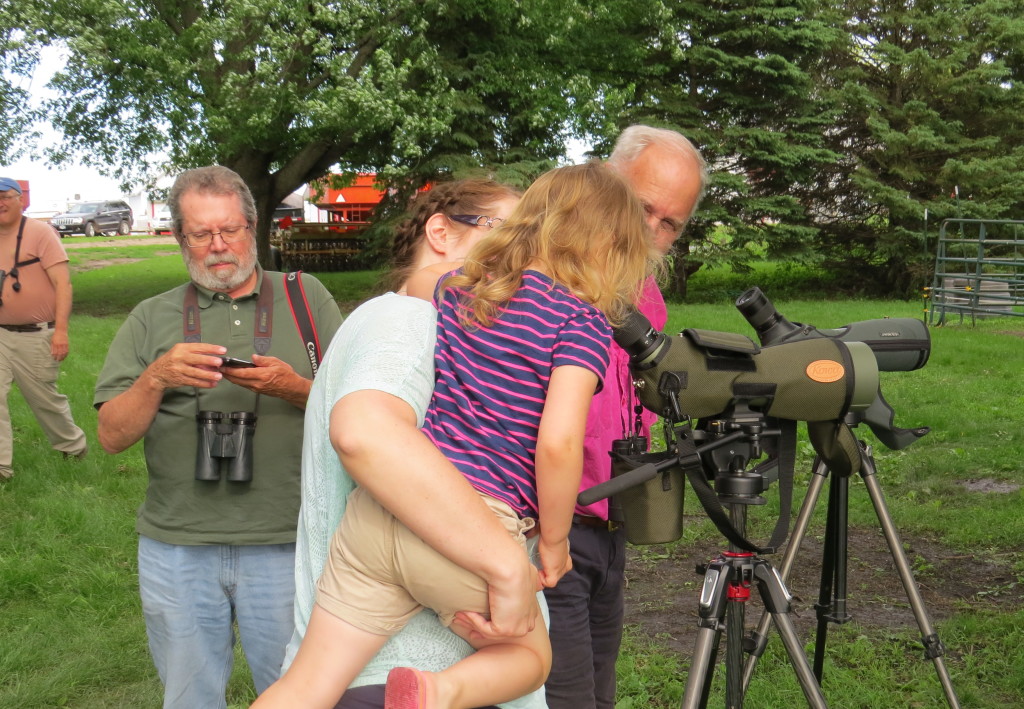
THE Top 10
So here is what you’ve all been waiting for–the real Top Ten. You might find yourself a bit surprised by my choices, but keep in mind that the bird itself is only half the fun–often circumstances, the birding company, or the hunt itself influenced my decisions. The list is not indicative of the rarity status of these birds. A surprising twist to this Top Ten is that nearly half of the birds are not even lifers (Indicated by an *)! Moreover, a great majority of these birds were found in-state.
10. Snowy Owl*
Now hold on a minute, I know you’re sick of these things on this blog and wondering how, in their great abundance, could they make the cut? Snowy Owls added life to both the dull winter landscape and the business-as-usual halls in which I work in 2014. When I got my lifer in late 2013 and learned of the impending irruption last year, I sent out an all-staff email requesting coworkers let me know of any sightings. That opened the floodgates. I was opening email after email of sightings, taking calls, listening to wild-eyed students and giddy staff members tell me about yet another sighting. It was an incredibly fun time. The owls made for instant ice-breaker conversations with all kinds of people. Though I never found my own Snowy Owl in 2014, I was able to point many people to their first which was quite a thrill. Additionally, driving anywhere became fun as every pole top or barn roof could hold a Snowy. And the amount of down time for Snowy Owl hunting was a mere 7 months as they were back in early November to begin an echo flight of last year’s irruption.
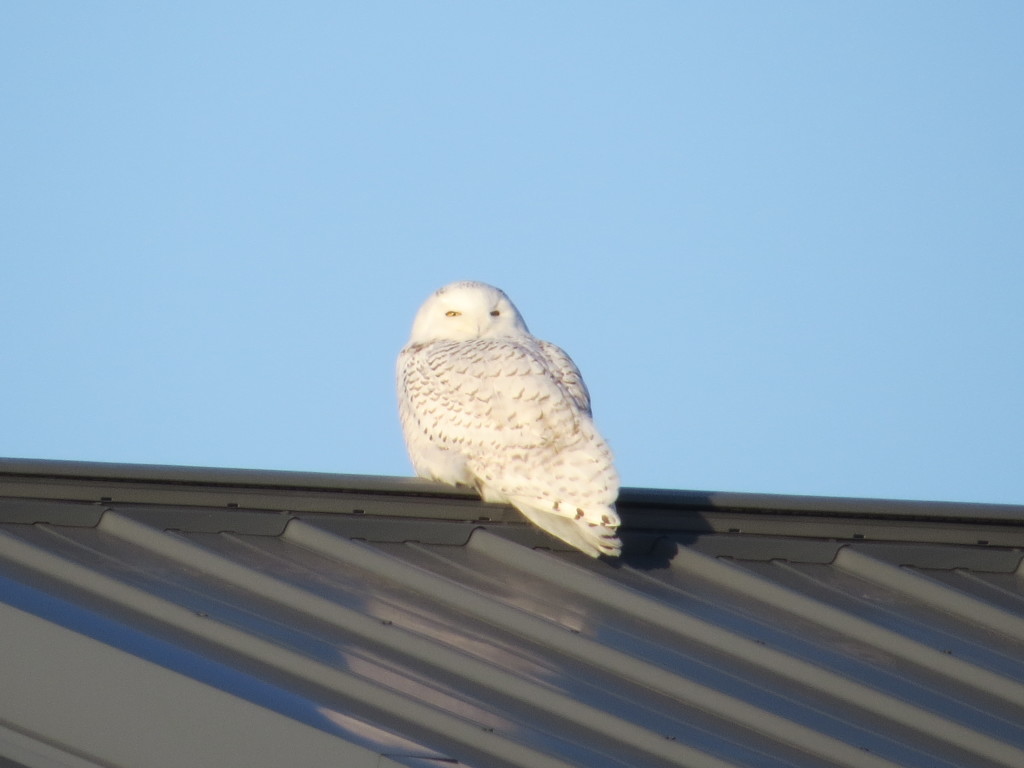
9. Black-billed Cuckoo
This is an uncommon bird and nowhere near rare for the northern half of MN during the breeding season. Still, it is an extremely elusive bird. Evan and I found our lifer quite by accident. We went for a four-wheeler ride on my parents’ property and stopped to play a tape of a Northern Parula only to be answered by the exotic sound of the Black-billed Cuckoo. We eventually were able to lure it into the open for some good views using playback. It was haunting how that bird moved and watched us from the shadows. And the sound of that thing is the craziest and most awesome bird noise I’ve heard. How could I have grown up in the northwoods and never heard or seen this bird? I know how. They hide like ninjas, watching your every move as you walk through the woods.
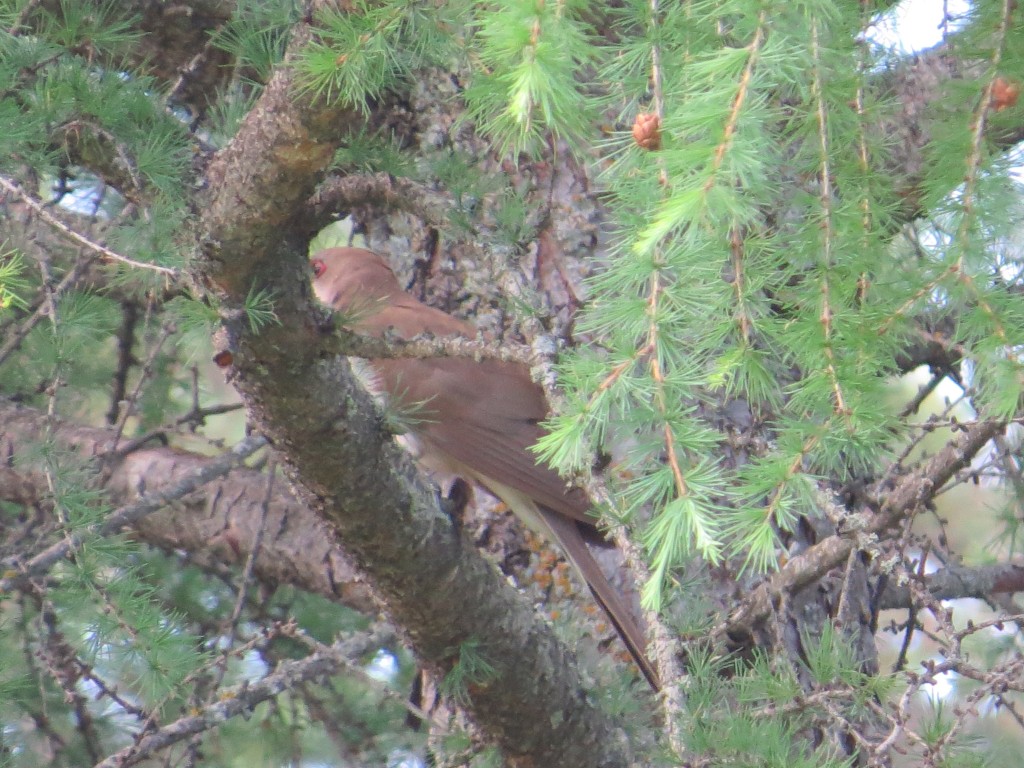
8. American Avocet
Ever since Evan and I got into birding, we talked about the awesomeness of the American Avocet. It just stands apart from all the other shorebirds with that black and white plumage with the crazy orangish head and neck, not to mention the long, upturned bill. Not only did we finally see this bird in 2014, but we found our lifer ourselves right here at home–the best way. I’ll never forget seeing it and then hustling down the sewage pond embankment to tell Evan. His eyes got huge, and he scrambled to get out of the car. We ended up seeing this species on three separate occasions in the county last year. Such a bird! Such a year!
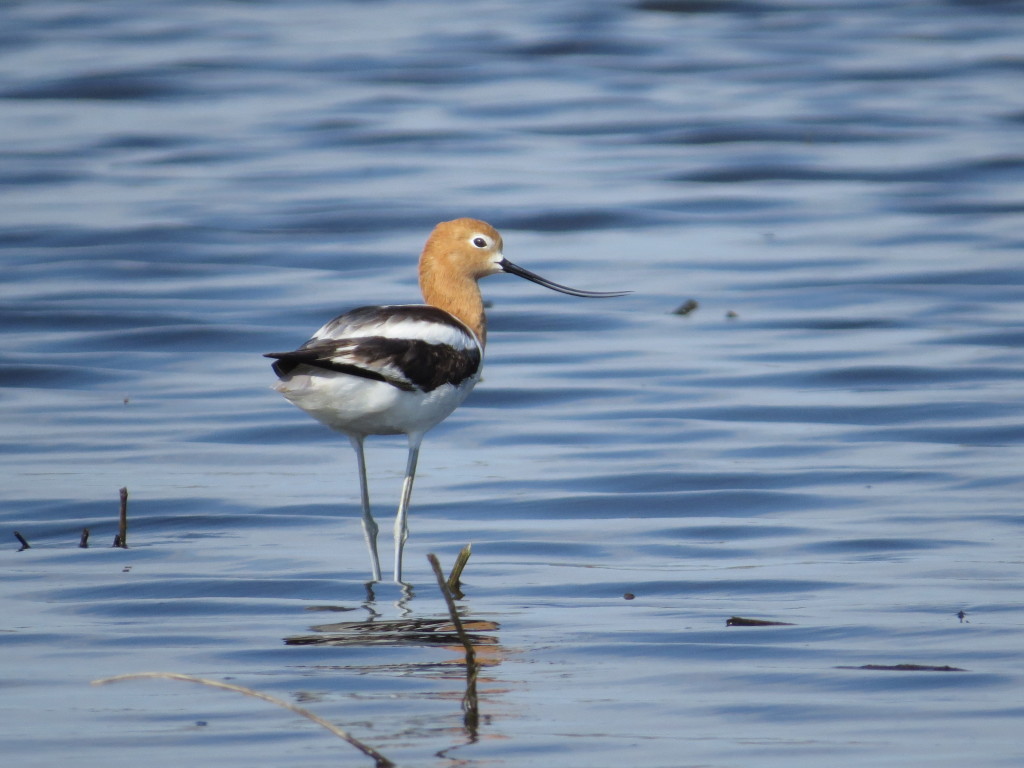
7. Cerulean Warbler*
This was not a life bird, but it was a special treat to see one at our very own Sibley State Park right here in Kandiyohi County, and I finally got some killer photos of the bird. This was now the third Cerulean I’d ever seen, and I cherish each sighting as this bird is fighting for its future on two continents. Evan’s seen this species a couple times now, but I hope that this beautiful, buzzy warbler will still be around for his kids and grandkids.
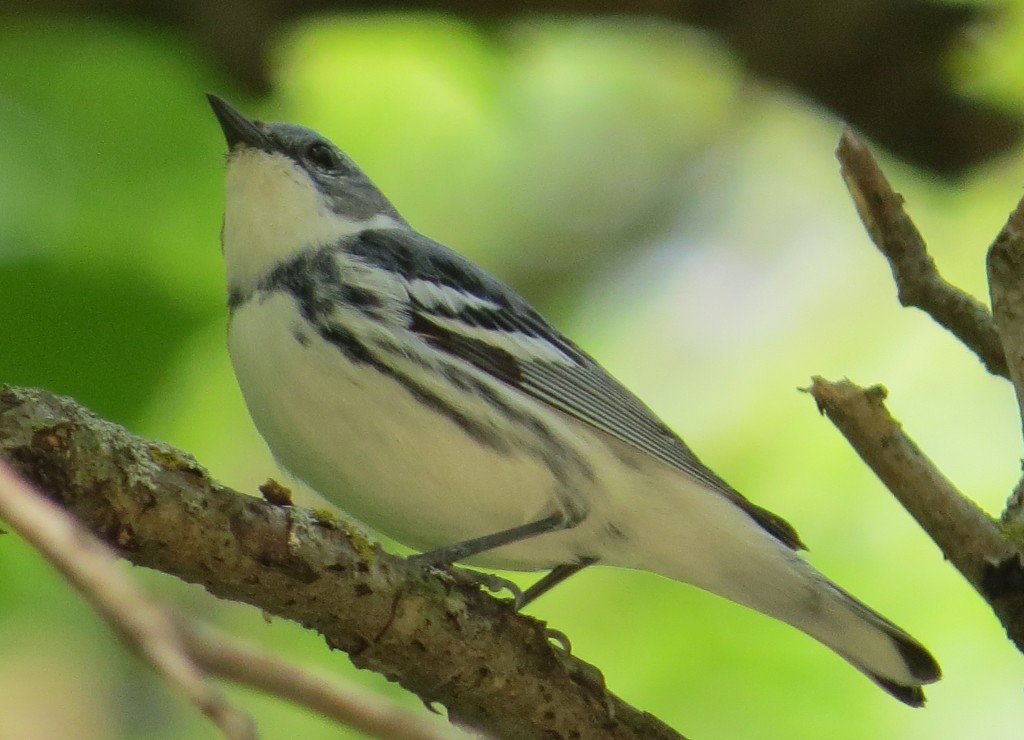 6. Chestnut-collared Longspur
6. Chestnut-collared Longspur
This striking Longspur is a state-endangered species. Only a handful of pairs nest annually on a small tract of land known as the Felton Prairie IBA just east of Fargo. Steve Gardner and I finally made the trip this summer just to look for this bird. Picking up a bonus lifer Greater Prairie Chicken and seeing plenty of Western Kingbirds, Loggerhead Shrikes, and Marbled Godwits was pretty neat and all, but we nearly dipped on the main attraction at Felton Prairie. This guy was a buzzer-beater, showing up just 15 minutes before the deadline Steve and I had set to go home. This bird did not disappoint us in its looks.
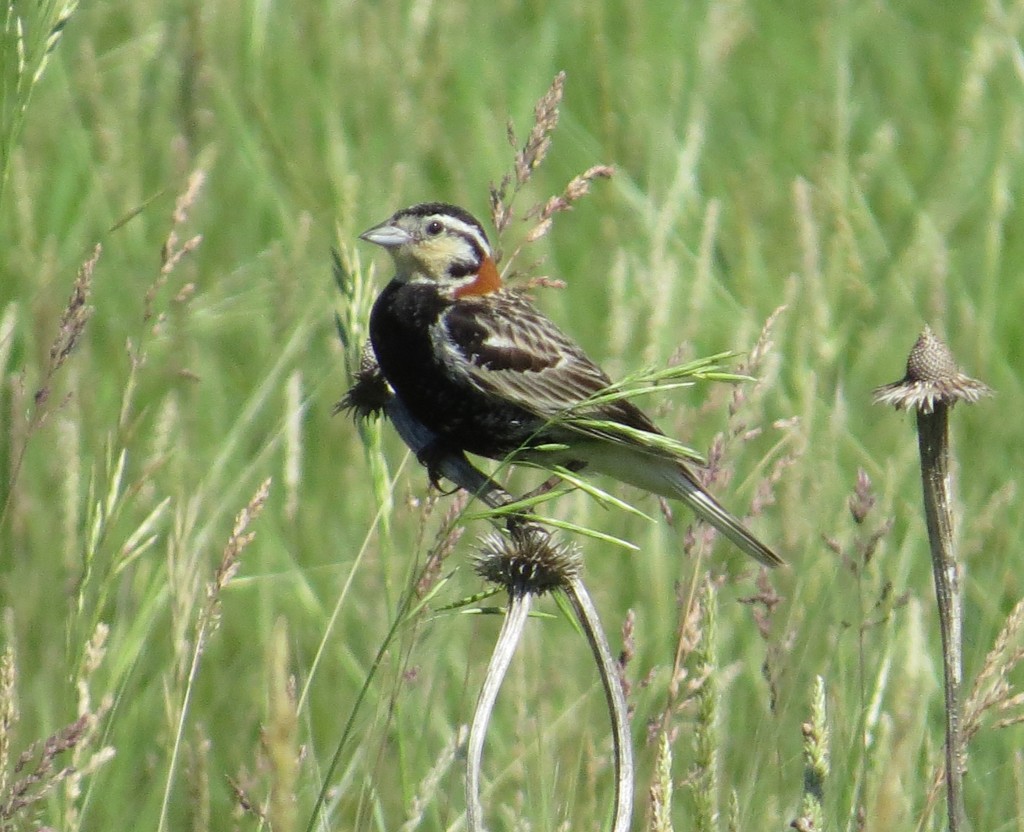
5. Spruce Grouse*
This bird was a buzzer-beater for 2014 and slipped into this list at the eleventh hour. This was the first Spruce Grouse I had seen since circa 1999. Even Minnesota birders drool over laying eyes on this beautiful gnome of the deep spruce bogs. I happened upon this one while driving the short distance between my parents’ house and my in-laws’ house in the final days of 2014 while we were home for Christmas. It felt so good to finally see this bird again and be able to photograph it.
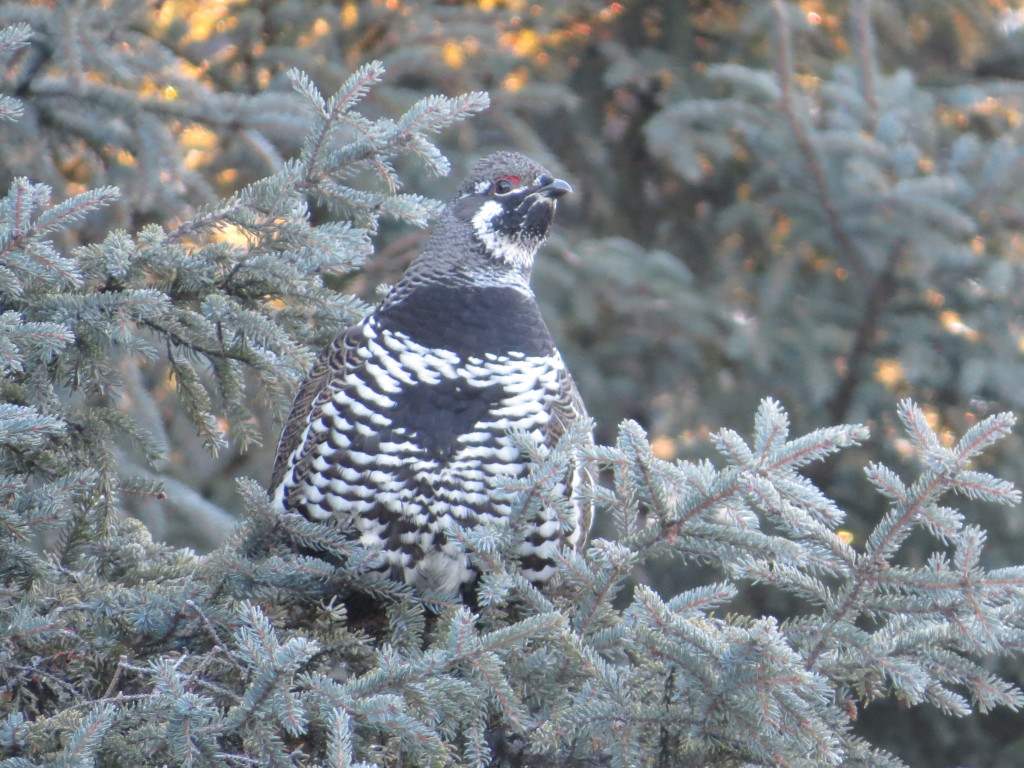
4. Long-eared Owl
I had the great pleasure of birding the Phoenix Mountain Preserve with Laurence Butler when we went to Arizona last March. As we talked plans ahead of time to bulk up my life list with some desert species, Laurence mentioned the possibility of the rare Long-eared Owl prize. I honestly thought, ‘Pssshht. Whatever-like we’ll see ever that.’ But inwardly I was secretly excited too. As someone who connected with birding because of the thrill of the hunt, it was a magical experience to wind our way through a tree-choked gully in the Sonoran Desert with the possibility of coming face-to-face with an owl that is coveted everywhere. Then it happened. One exploded into the air in front of us leaving throbbing hearts and cursing mouths in its wake. Eventually Laurence and I pinned it down and stared right into those yellow eyes. It was a mountain-top high on the valley floor.
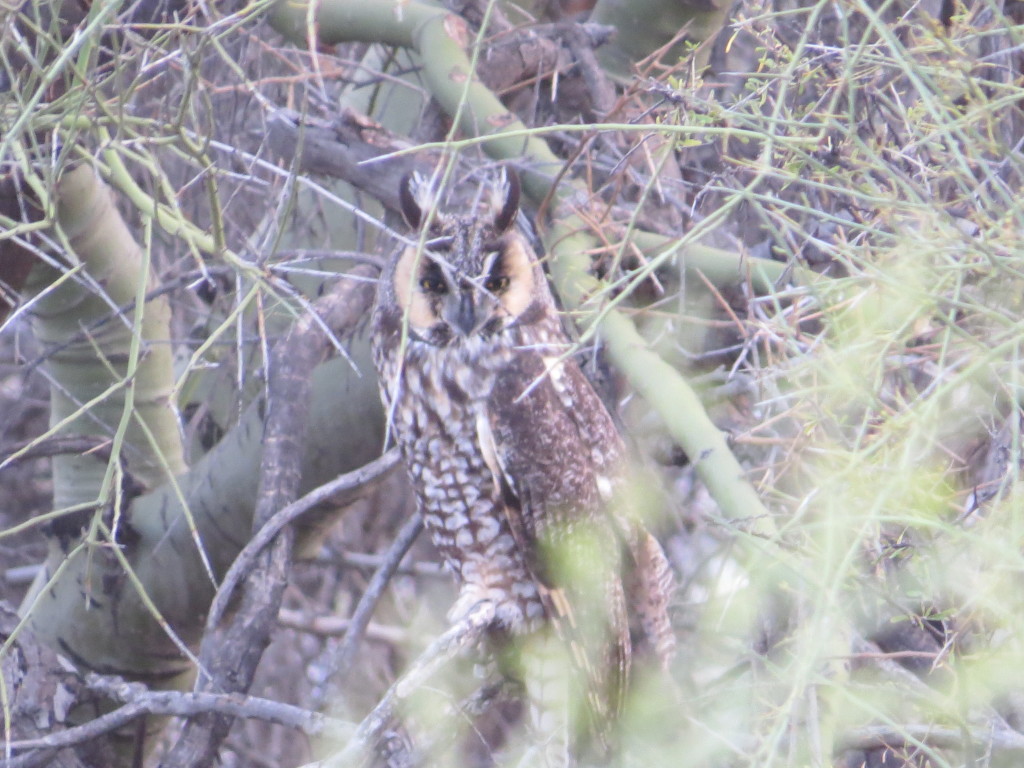
3. Blue Grosbeak*
Yes, Josh, it’s a beautiful bird, but c’mon, #3?! This is a bird I dreamed about seeing when I first saw it in the Kaufmann Field Guide and noticed that the very southwestern tip of MN was in its range. Eventually I learned it’s a reliable find at Blue Mounds State Park which is where we got our lifer in 2013. Getting deeper into birding, I was finding out that they are actually found much further north and east of that tiny corner of the state. My curiosity was peaked after seeing them in Cottonwood and then when Joel had said he and Randy had seen a family of them a couple years ago just 25 miles away from Willmar in Renville County. So I investigated the site and struck out. However, I noticed a gravel pit in the vicinity and stopped to check it out since Blue Grosbeaks have an affinity for such desert-wash environments. I rolled down the window and was almost instantly greeted with the sweet, sweet sound of BLGR.
When I got home I looked at the gravel pit with satellite imagery and discovered that the tract of gravel pits stretched for nearly four miles being intersected neatly with a county road every mile. I had to go back! And so I did. And I found a Blue Grosbeak on every county road that intersected that gravel tract for a total of four Blue Grosbeaks over a three-mile stretch. As a bonus, another birder following up on my reports turned up a 5th one. We were no longer dealing with a far-flung, slightly out-of-range individual bird or two. Instead we had a thriving population of Blue Grosbeaks in Renville County which is far north and east of where they are supposed to be. And they are only six miles south of Kandiyohi County!
Finding rare birds by chance is great fun, but investigating a theory and having that theory validated with multiple birds was a birding achievement that I prize more than any of my rarities mentioned in this post. Contributing data to a possible range expansion is exciting stuff. I cannot wait to check on them again this summer.
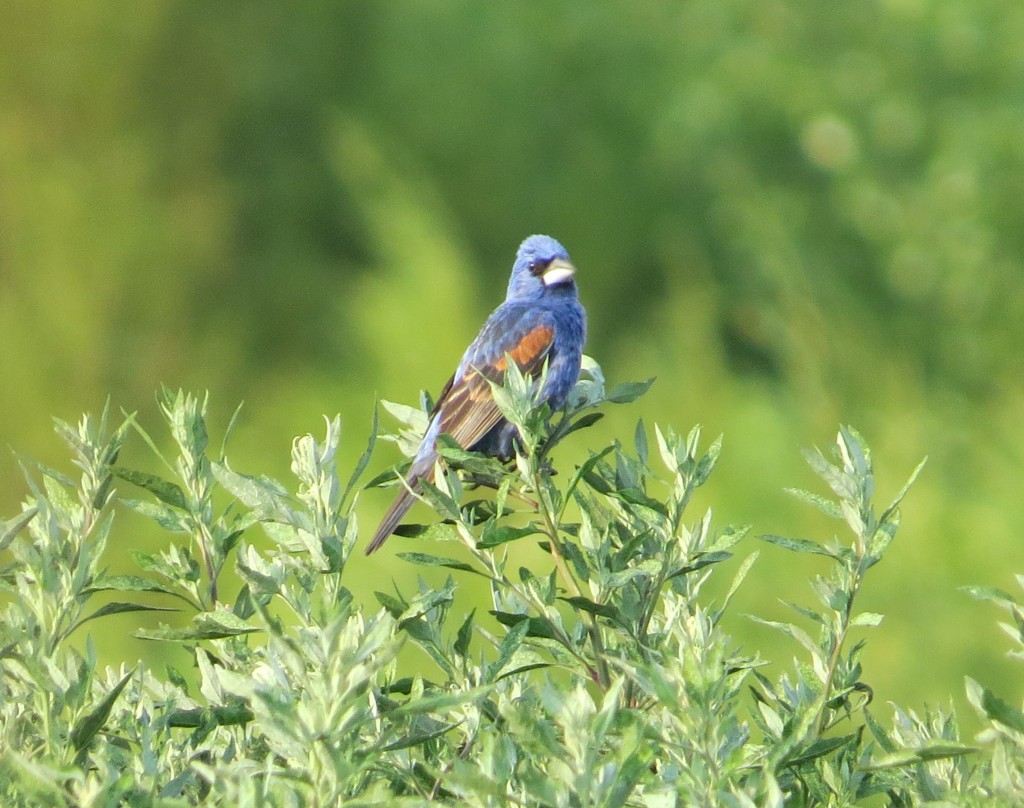
2. Burrowing Owl
Since Melissa has taught the novel Hoot for years and since Evan and I are birders, this owl has a special connection with our family. It was the one bird that we simply had to see in Arizona above all others. Laurence had told me Zanjero Park was pretty much a lock, but my dad, the chauffeur, went rogue and opted to drive us along random roads in the countryside south of Maricopa. As zero new birds were being seen, especially not the Burrowers, I thought the day was going to be lost. So then a quiet, non-aggressive Norwegian stand-off ensued complete with beatings around the bush and passive-aggressive attempts to commandeer the situation.
“I think Zanjero could be a sure thing.”
“It’ll be more fun to find our own.”
Folks, let me tell you, always listen to your dad and kiss your wife because as my heart was sinking in despair along with the setting sun, Melissa hollers from the backseat that she found one! And another and another and another. Dang! The fun didn’t stop there either. I finally found a couple, and even my mom found herself one. We had eight Burrowers in all! Let me tell you, these Scandinavians were rocking that van with whoops and hollers. It was a fun, memorable experience for the whole family.
In all, we saw 12 Burrowers on our trip with a pair even within biking range of my parents’ house.
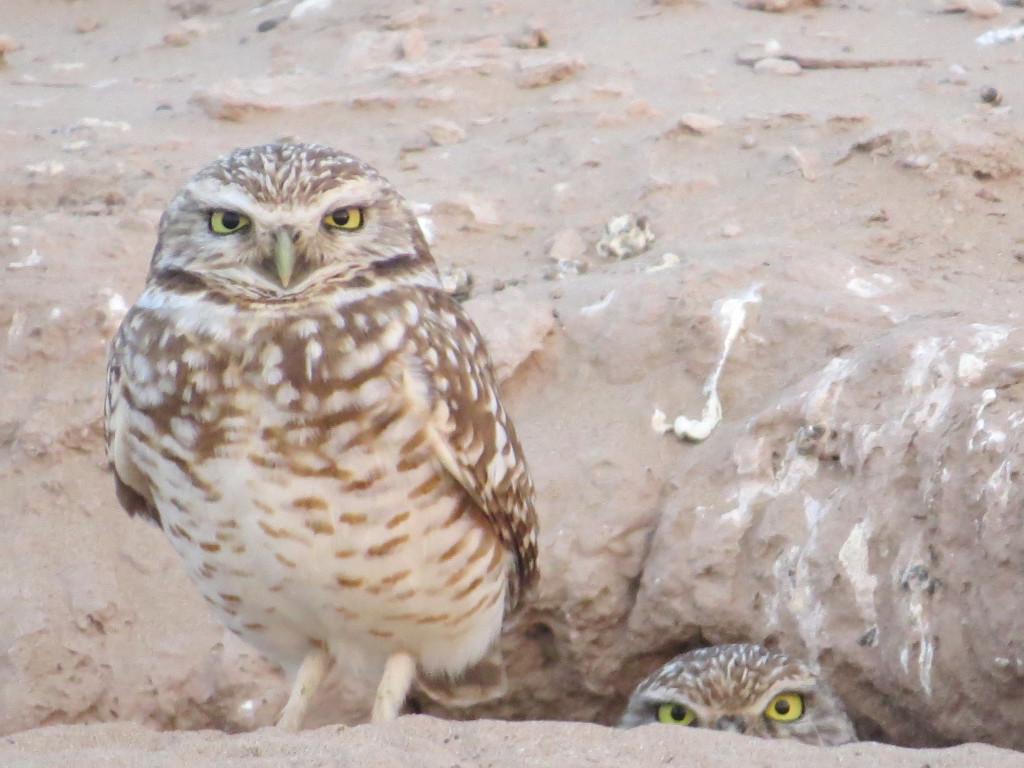
1. Garganey
You’ve seen the kind of birds we put up in 2014. Honestly, could this spot be held by anything other than Wisconsin’s first state record of a Garganey that Evan and I went to see? If you look up the word “serendipity” in the dictionary, you are bound to see a picture of a Garganey. Kaufmann writes that it can show up on any marsh in the spring. How awesome and hope-inspiring is that?! Plus it is a gorgeous duck that I had been yearning to see someday before my time is up. And if seeing a Garganey wasn’t a thrill enough, we went on this adventure with long-time birding great, Ron Erpelding, and got to witness someone who has amassed over 50 years of birding and over 675 life birds see this bird for the very first time just as Evan and I were seeing it. It was life bird #678 for Ron. Not even the cats-and-dogs rain could detract from our joy that drenched us when we watched this bird just 15 feet out the car window. It was, by far, the best bird of 2014.
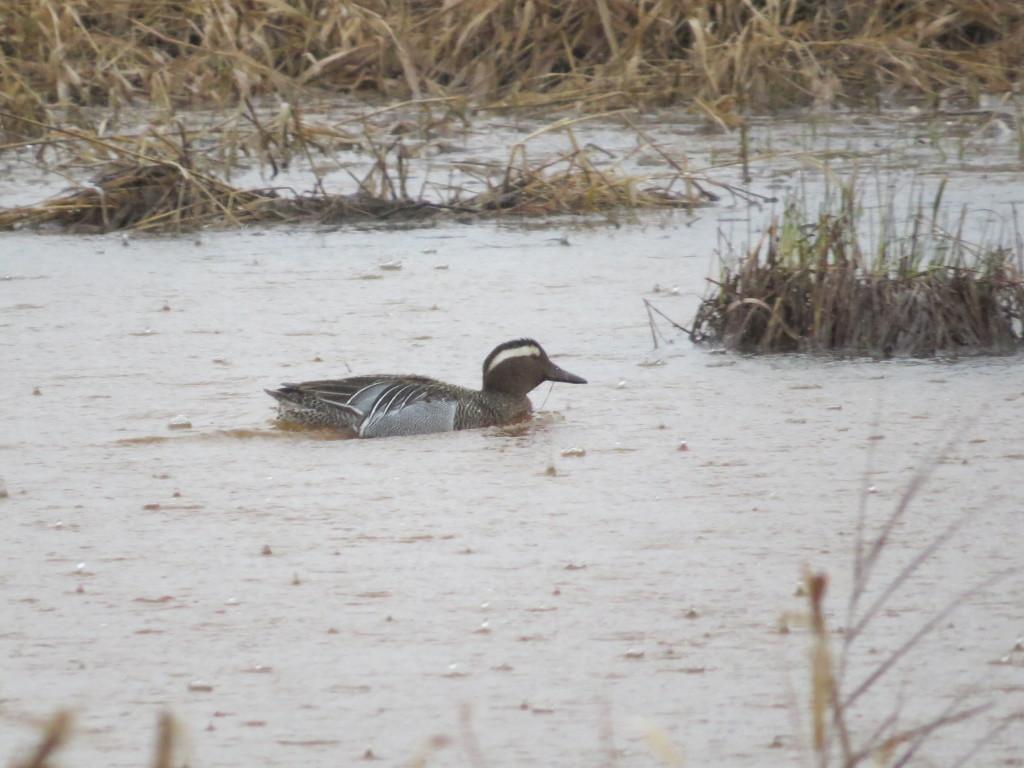
So, 2015, it is unlikely you will live up to the high bar you’re bigger, all-American, older brother, 2014, has set. But take heart because you will be special in your own right. Perhaps you will be known as the year of the Gyrfalcon!
